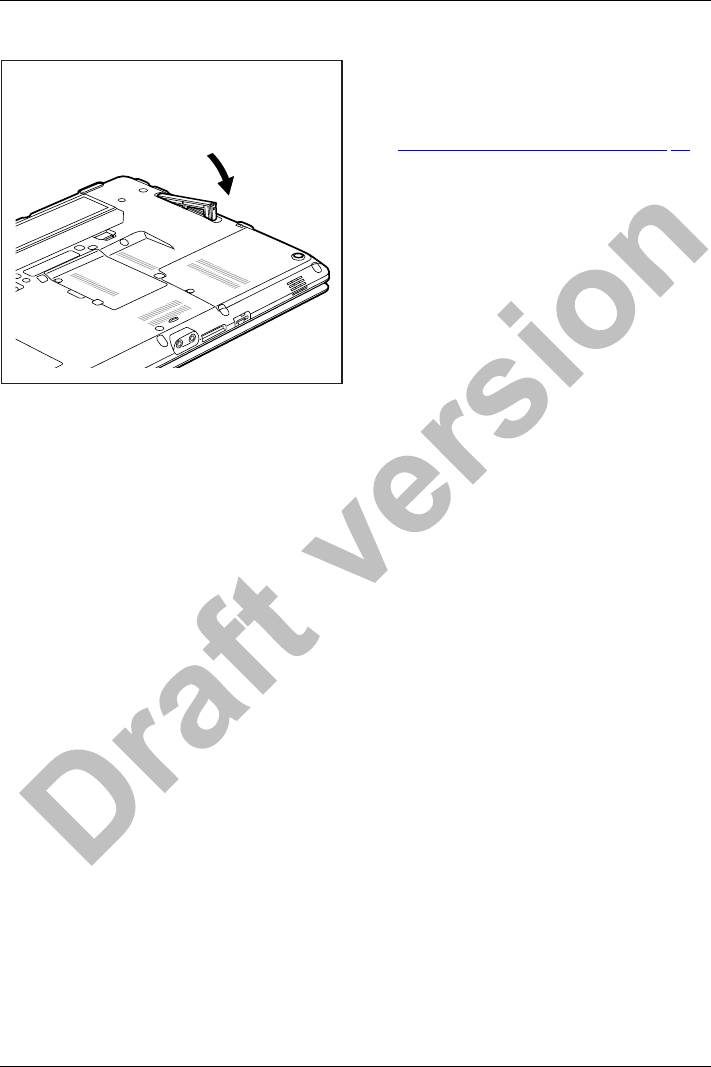Fujitsu Client Computing WL0029 INTEL 62205 ANHMW WLAN IN T732 / TH702 STYLISTIC User Manual USERS MANUAL
Fujitsu Limited INTEL 62205 ANHMW WLAN IN T732 / TH702 STYLISTIC USERS MANUAL
USERS MANUAL

System
Operating manual
LIFEBOOK T732

Congratulations on your purchase of an innovative
product from Fujitsu.
The latest information about our products, tips, updates etc. can be found
on the Internet at: "http://www.fujitsu.com/fts/"
For automatic driver updates, go to: "http://support.ts.fujitsu.com/download"
Should you have any technical questions, please contact:
• our Hotline/Service Desk (see the Service Desk list or visit:
"http://support.ts.fujitsu.com/contact/servicedesk")
• Your sales partner
• Your sales office
We hope you enjoy working with your new Fujitsu system!

LIFEBOOK T732
Operating manual
Innovative technology 7
Ports and controls 9
Important notes 12
First-time setup of your device 15
Working with the notebook 18
Security functions 68
Connecting external devices 75
Removing and installing components
during servicing 82
Settings in BIOS Setup Utility 90
Troubleshooting and tips 92
Technical data 99
Manufacturer’s notes 102
Index 108

Remarks
Information on the product description meets the design specifications of Fujitsu and
is provided for comparison purposes. Several factors may cause the actual results to
differ. Technical data is subject to change without prior notification. Fujitsu rejects any
responsibility with regard to technical or editorial mistakes or omissions.
Trademarks
Fujitsu and the Fujitsu logo are registered trademarks of Fujitsu Limited or its
subsidiaries in the United States and other countries.
Microsoft and Windows are trademarks or registered trademarks of the Microsoft
Corporation in the United States and/or other countries.
Made under license from DTS Licensing Limited. DTS and the symbol are registered trademarks and
& DTS Boost is a trademark of DTS, Inc. Product contains software. © DTS, Inc. All rights reserved.
All other trademarks specified here are the property of their respective owners.
Copyright
No part of this publication may be copied, reproduced or translated without
the prior written consent of Fujitsu.
No part of this publication may be saved or transferred by any electronic means
without the written approval of Fujitsu.

Contents
Contents
Innovativetechnology ................................................................. 7
Furtherinformation ...................................................................... 7
Notational conventions .................................................................. 8
Portsandcontrols ..................................................................... 9
Importantnotes ........................................................................ 12
Safetynotes ............................................................................ 12
Additional safety notes for devices with radio components . . . . . ............................. 12
Energysaving .......................................................................... 13
Energy saving under Windows ....................................................... 13
Travellingwithyournotebook ............................................................ 13
Beforeyoutravel ................................................................... 13
Notebook:transporting ............................................................... 14
Cleaningthenotebook .................................................................. 14
First-time setup ofyourdevice ......................................................... 15
Unpacking and checkingthedevice ...................................................... 15
Selectingalocat
ion ..................................................................... 16
Mains adapter connecting ............................................................... 16
Switchingonthedevice for the firsttime .................................................. 17
Workingwiththenotebook ............................................................ 18
Statusindicators ........................................................................ 18
Openingthenotebook ................................................................... 20
Switching on the notebook . . . . ........................................................... 21
ProgrammingtheON/OFFswitch ..................................................... 21
Different ways to use your notebook . . . ................................................... 22
From notebook to Tablet PC . . ....................................................... 22
Selectdisplayorientation(portraitorlandscapeorientation) ............................. 24
FromTabletPCtonotebook .......................................................... 25
Switching off the notebook . . . . ........................................................... 26
Closing the notebook . . .................................................................. 27
Handwriting recognition under Windows 7 . . . . . ............................................ 27
LCDscreen ............................................................................ 28
AmbientLightSensor ................................................................ 28
UsingadeviceasatabletPC ............................................................ 28
Using fingers ....................................................................... 29
Usingthestyluspen ................................................................. 32
Usingthedeviceasanotebook .......................................................... 35
Touchpadandtouchpadbuttons ...................................................... 35
Keyboard ............................................................................... 37
Virtualnumerickeypad .............................................................. 39
Country and keyboard settings ....................................................... 39
Keycombinations ................................................................... 40
Tabletbuttons .......................................................................... 42
Programmingthetabletbuttons ...................................................... 43
Webcam ............................................................................... 44
Rechargeablebattery ................................................................... 45
Charging,caringforandmaintainingthebattery ....................................... 45
Removingandinstallingthebattery ................................................... 46
Batterychargestatusindicator ....................................................... 48
Fujitsu 3

Contents
Module ................................................................................. 49
Removing a module . ................................................................ 49
Installing a module . . ................................................................ 50
Opticaldrive ............................................................................ 50
Handling data carriers . . . ............................................................ 50
CD/DVDindicator ................................................................... 51
Insertingorremovingadatacarrier ................................................... 51
Manual removal (emergency removal) . . . ............................................. 52
Removing and fittingthedustremovalcover(ventilationslotcover) ......................... 52
Using the power-management features . . ................................................. 54
Memorycards .......................................................................... 55
Supportedformat .................................................................... 55
Insertingthememorycard ........................................................... 55
Removingthememorycard .......................................................... 56
ExpressCards .......................................................................... 56
Insertingthecard ................................................................... 57
Removingthecard .................................................................. 58
Loudspeakers and microphones . . ........................................................ 58
SIMcard ............................................................................... 59
InsertingtheSIMcard ............................................................... 59
RemovingtheSIMcard .............................................................. 59
Optional Wireless LAN / Bluetooth / UMTS / LTE wireless components . . . ................... 60
Switching the wireless components on and off ......................................... 60
SettingupWLANaccess ............................................................ 61
AccessviaUMTS/LTE .............................................................. 61
UMTS/LTEantenna ................................................................. 61
EthernetandLAN ....................................................................... 62
Your Port Replicator (optional) . . . ........................................................ 62
PortsonthePortReplicator .......................................................... 63
Settinguptheportreplicator ......................................................... 64
Connect the notebook to the port replicator . . . ......................................... 64
Switching on the notebook via the port replicator . . . . . .................................. 66
SwitchingoffnotebookviaPortReplicator ............................................. 66
Disconnecting the notebook from the port replicator . . .................................. 67
Securityfunctions ..................................................................... 68
Briefoverviewofsecurityfunctions ....................................................... 68
Configuring the fingerprint sensor ........................................................ 69
UsingtheSecurityLock ................................................................. 69
ConfiguringpasswordprotectioninBIOSSetupUtility ...................................... 70
Protecting BIOS Setup Utility (supervisor and user password) . .......................... 70
Password protection for booting of the operating system . .............................. 71
Passwordprotectionfortheharddisk ................................................. 72
Usingthesecurityfunctionofthetabletkeys .............................................. 73
Setting the Supervisor password . . . . ................................................. 73
SettingtheUserpassword ........................................................... 73
Enteringpasswordsusingthetabletbuttons ........................................... 73
Trusted Platform Module (TPM) (device-dependent) . . . . . .................................. 74
EnablingTPM ....................................................................... 74
DisablingTPM ...................................................................... 74
Connectingexternaldevices ........................................................... 75
Connecting an external monitor . . ........................................................ 76
Connecting an external monitor to the DisplayPort . . . .................................. 77
4Fujitsu

Contents
HDMIport .......................................................................... 78
Connecting USB devices . . . . . ........................................................... 79
USBportwithchargingfunction(AnytimeUSBcharge) ................................. 80
HowtoremoveUSBdevicescorrectly ................................................ 80
Connecting external audio devices ....................................................... 81
Microphone port/Line In . . . ........................................................... 81
Headphone port . . . .................................................................. 81
Removing and installing components during servicing . . . . ............................. 82
Notesoninstallingandremovingboardsandcomponents .................................. 82
Preparing to remove components . ....................................................... 83
Installing and removing memory expansion . . . . ............................................ 83
Removingacover ................................................................... 84
Removingmemorymodules .......................................................... 84
Installingamemorymodule .......................................................... 85
Attachingthecover .................................................................. 85
Removingandinstallingtheharddisk .................................................... 86
Removingacover ................................................................... 86
Removingaharddisk ............................................................... 87
Installingaharddisk ................................................................. 88
Attachingthecover .................................................................. 89
Finishing component removal . ........................................................... 89
Settings in BIOS Setup Utility . . . ....................................................... 90
StartingtheBIOSSetupUtility ........................................................... 90
OperatingBIOSSetupUtility ............................................................. 90
ExitingBIOSSetupUtility ................................................................ 91
Exit Saving Changes - save changes and exit BIOS Setup Utility . . ..................... 91
Exit Discarding Changes – Discard changes and exit BIOS Setup Utility . . . .............. 91
Load Setup Defaults – Copy Standard Entries . ........................................ 91
Discard Changes – Discard changes without exiting the BIOS Setup Utility . .............. 91
Save Changes - save changes without exiting the BIOS Setup Utility . . . . . . .............. 91
Save Changes and Power Off ....................................................... 91
Troubleshootingandtips .............................................................. 92
Helpifproblemsoccur ................................................................... 92
The notebook’s date or time is incorrect ................................................... 93
Battery indicator does not illuminate . . . ................................................... 93
Whencertaincharactersareenteredonthekeyboard,onlynumeralsarewritten ............. 93
The notebook’s LCD screen remains blank . . . . ............................................ 93
The LCD screen is difficulttoread ........................................................ 94
Theexternalmonitorremainsblank ...................................................... 94
Theexternalmonitorisblankortheimageisunstable ..................................... 94
The cursor does not correctly follow the pen movements . . . . . . ............................. 95
Peninputnotworking ................................................................... 95
The notebook cannot be started . . . ....................................................... 95
The notebook stops working . . ........................................................... 96
The printer does not print . . . . . ........................................................... 96
The radio connection to a network does not work . . ........................................ 96
Thebatterydischargestooquickly ........................................................ 97
Acousticwarnings ....................................................................... 97
Errormessagesonthescreen ........................................................... 97
Technicaldata ......................................................................... 99
Fujitsu 5

Contents
Notebook . . . . ........................................................................... 99
PortReplicator(optional) ................................................................ 100
Rechargeable battery . . . ................................................................ 101
Mains adapter for use with the notebook and port replicator . . .............................. 101
Manufacturer’snotes .................................................................. 102
Disposalandrecycling .................................................................. 102
DeclarationsofConformity ............................................................... 102
CEmarking ............................................................................ 102
Regulatorynotices ...................................................................... 102
Regulatory information for notebooks without radio device .............................. 103
DOC (Industry CANADA) notices . . . . ................................................. 104
FCC regulatory information for notebooks with radio device . . . .......................... 106
Index .................................................................................. 108
6Fujitsu

Innovative technology
Innovative technology
... and ergonomic design make your device a reliable and convenient companion.
The device boots very quickly, is ready for immediate use and offers a particularly
long operating time because of its high capacity battery.
With the user-friendly "BIOS Setup Utility" you can control your notebook’s hardware and better
protect your system against unauthorised access by using the powerful password properties.
Information on the connections and user components of your notebook
canbefoundin"Ports and controls", Page 9.
Further information
The Windows drivers for your device can be found on our Internet site.
The factory installation of your device does not support any other operating
system. Fujitsu Technology Solutions accepts no liability whatsoever
if any other operating system is used.
Software oriented components of these instructions refer to Microsoft products,
if they come within the scope of the delivery.
If you install other software products, pay attention to the operating
instructions of the manufacturer.
Fujitsu 7

Innovative technology
Notational conventions
Pay particular attention to text marked with this symbol. Failure to observe
these warnings could pose a risk to health, damage the device or lead
to loss of data. The warranty will be invalidated if the device becomes
defective through failure to observe these warnings.
Indicates important information for the proper use of the device.
►Indicates an activity that must be performed
Indicates a result
This font indicates data entered using the keyboard in a program dialogue or at
the command line, e.g. your password (Name123) or a command used to
start a program (start.exe)
This font indicates information that is displayed on the screen by a program, e.g.:
Installation is complete.
This font indicates
• terms and texts used in a software interface, e.g.: Click on Save
• names of programs or files, e.g. Windows or setup.exe.
"This font" indicates
• cross-references to another section, e.g. "Safety information"
• cross-references to an external source, e.g. a web address: For more
information, go to "http://www.fujitsu.com/fts/"
• Names of CDs, DVDs and titles or designations for other materials,
e.g.: "CD/DVD Drivers & Utilities" or "Safety/Regulations" manual
Key indicates a key on the keyboard, e.g: F10
This font indicates terms and texts that are emphasised or highlighted, e.g.: Do
not switch off the device
8Fujitsu
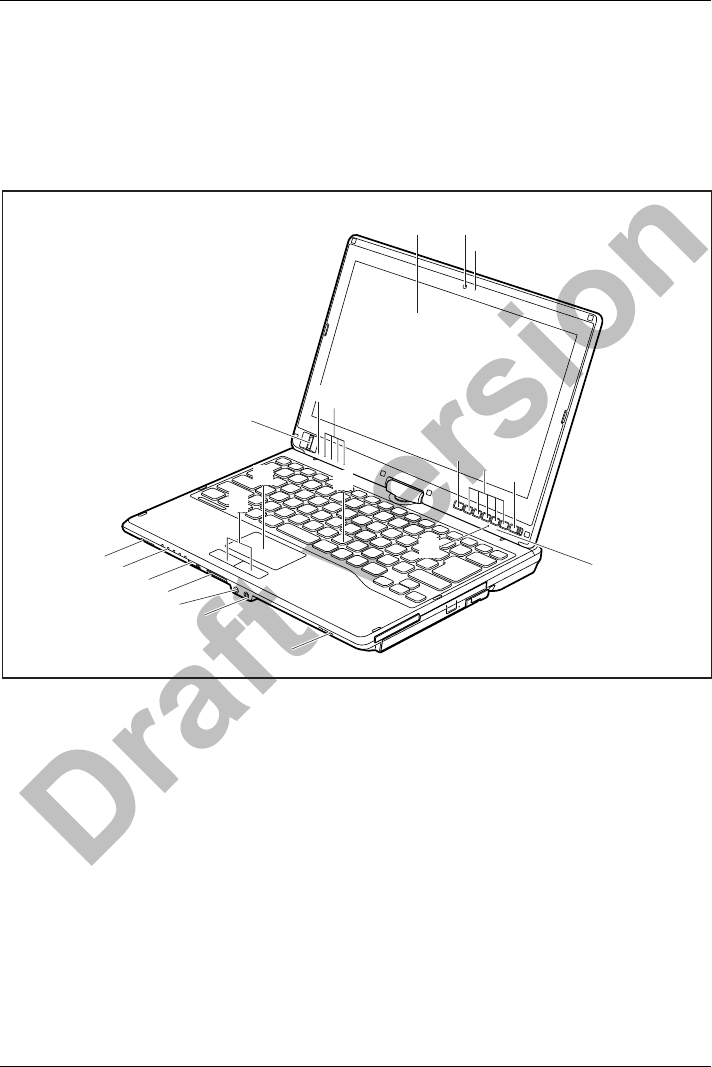
Ports and controls
Ports and controls
This chapter presents the individual hardware components of your device. It gives you
an overview of the device’s indicators and connections. Please familiarise yourself with
these components before you start to work with the device.
Notebook open
1 23
8
6
14
13
12 11
46
14
9
5
7
5
15
16
10
17
18
1 = LCD screen
2 = WebCam (* optional)
3 = WebCam LED
4 = Fingerprint sensor
5 = Microphone
6 = Status indicators
7 = Windows button
8 = Tablet buttons
9 = ON/OFF switch
10 = Ambient light sensor
11 = Keyboard
12 = Touchpad
13 = Touchpad buttons
14 = Loudspeakers
15 = Microphone jack
16 = Headphone port
17 = Memory card slot
18 = ON/OFF switch for wireless components
Fujitsu 9
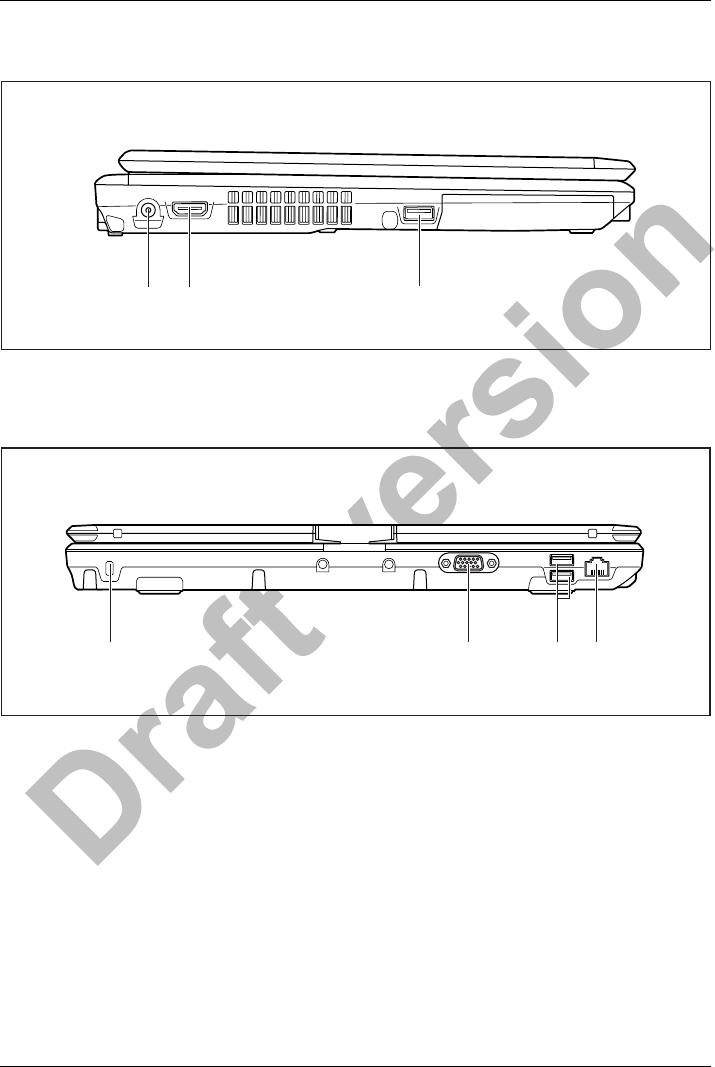
Ports and controls
Left panel
1 2 3
1 = DC input connector (DC IN)
2 = HDMI port
3 = USB port with charging function (Anytime
USB charge, USB 3.0)
Rear
3 421
1 = Security Lock device
2 = VGA monitor port
3 = USB ports (USB 2.0)
4 = LAN port
10 Fujitsu
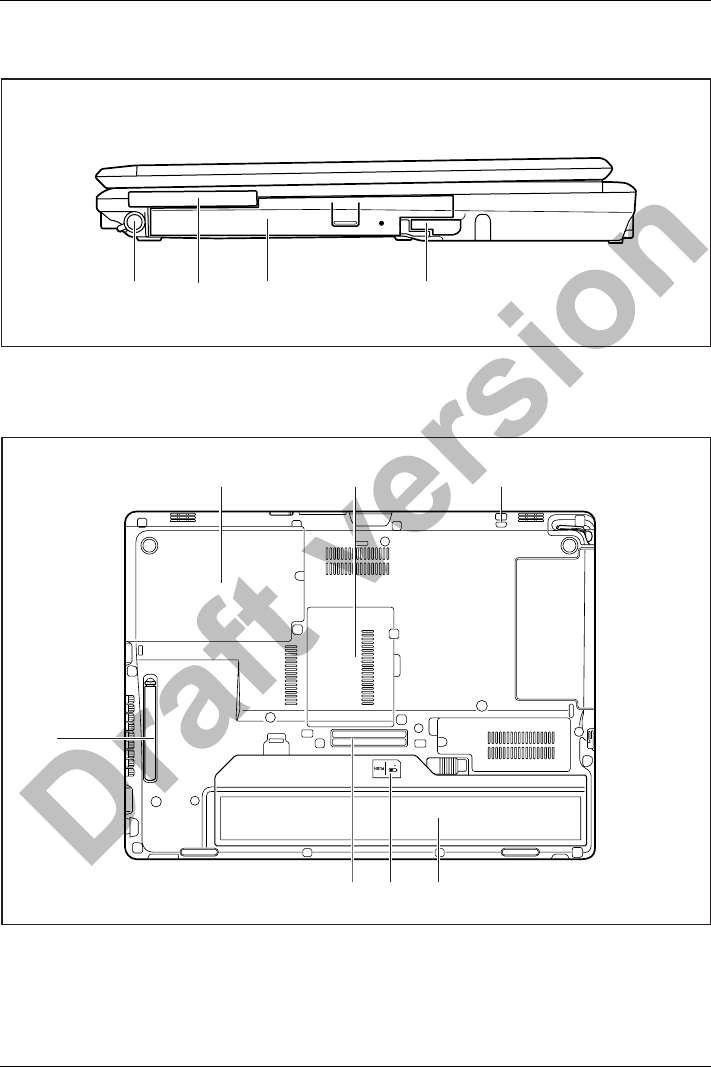
Ports and controls
Right-hand side
1 43
2
1=Penslot
2 = ExpressCard slot
3 = Module bay with optical drive
4 = Eject lever for module bay
Bottom
1
46
2
7
5
3
1 = Hard disk service compartment
2 = Memory service compartment
3 = Attachment eye for the pen cord
4 = Battery with SIM card slot under the battery
5 = Battery charge status indicator
6 = Port for port replicator
7 = Ventilation slot cover
Fujitsu 11

Important notes
Important notes
ImportantnotesNotes
This chapter contains essential safety information which must be followed
when working with your notebook. Other notes also provide useful information
which will help you with your notebook.
Safety notes
SafetynotesNotes
Please follow the safety notes provided in the "Safety/Regulations" manual
as well as the safety notes given below.
Please pay special attention to the sections in the manual marked
with the symbol on the left.
When connecting and disconnecting cables, observe the relevant
notes in this operating manual.
Read the information on the ambient conditions in the "Technical data",
Page 99 and "First-time setup of your device", Page 15 before preparing your
notebook for use and switching it on for the first time.
When cleaning the device, please observe the relevant notes in the
section "Cleaning the notebook", Page 14.
Pay attention to the additional safety notes for devices with radio components
provided in the "Safety/Regulations" manual.
Please refer to the notes in the chapter "Removing and installing
components during servicing", Page 82.
This notebook complies with the relevant safety regulations for data processing
equipment. If you have questions about using your notebook in a particular area,
please contact your sales outlet or our Hotline/Service Desk.
Additional safety notes for devices with
radio components
Radiocomponent :WirelessLAN:Bluetooth,safetynotes
If a radio component (Wireless LAN, Bluetooth, UMTS/LTE) is incorporated in your notebook,
you must be sure to observe the following safety notes when using your notebook:
• Switch off the radio components when you are in an aircraft or driving in a car.
• Switch off the radio components when you are in a hospital, an operating room or near a medical
electronics system. The transmitted radio waves can impair the operation of medical devices.
• Switch off the radio components when you let the device get near flammable
gases or into hazardous environments (e.g. petrol station, paintshops), as the
transmitted radio waves can cause an explosion or a fire.
For information on how to switch radio components on and off, see chapter
"Switching the wireless components on and off", Page 60.
12 Fujitsu

Important notes
Energy saving
NotesEnergyEnergysaving
Switch the notebook off when it is not in use. Switch off external, connected devices if you
are not using them. If you use the energy saving functions, the notebook uses less energy.
You will then be able to work for longer before having to recharge the battery.
Energy efficiency is increased and the environmental impact is reduced.
You save money while protecting the environment.
Energy saving under Windows
►Make use of the power management features (see ""Using the power-management features",
Page 54").
Travelling with your notebook
MobileoperationNotesTrans porta tionNotebook
Please observe the points listed below when travelling with your notebook.
Before you travel
►Back up important data stored on your hard disk.
NotebookTravel,notebook
►Switch off the radio component for data security reasons. With data traffic via a wireless
connection, it is also possible for unauthorised third parties to receive data.
Information on activating data encryption is provided in the documentation
for your radio component.
►If you wish to use your notebook during a flight, first check with the flight
attendants if it is OK to do so.
When travelling in other countries
►If you are travelling abroad, check that the mains adapter can be operated with the
local mains voltage. If this is not the case, obtain the appropriate mains adapter for
your notebook. Do not use any other voltage converter!
►Check whether the local mains voltage and the power cable are compatible. If this is
not the case, buy a power cable that matches the local conditions.
►Enquire with the corresponding government office of the country you will be
travelling in as to whether you may operate the radio component integrated in your
notebook there (see also "CE marking", Page 102).
Fujitsu 13

Important notes
Notebook: transporting
Protect the notebook from severe shocks and extreme temperatures
(e.g. direct sunlight in a car).
►If your device has an optical drive, remove all data media (e.g. CD, DVD) from the drives.
TransportationNotebook
►Switch the notebook off.
►Unplug the mains adapter and all external devices from the power socket.
►Disconnect the mains adapter cable and the data cables for all external devices.
►Close the LCD screen.
►To protect against damaging jolts and bumps, use a notebook carrying
case to transport your notebook.
Cleaning the notebook
Do not clean any interior parts yourself; leave this job to a service technician.
Only use cleaning products designed for computers. Normal household
cleaners and polishes can damage the markings on the keyboard and the
device, the paintwork or the notebook itself.
Ensure that no liquid enters the notebook.
The LCD screen very sensitive to scratches. Only clean the display
surface with a very soft, slightly damp cloth.
►Switch the notebook off.
CleaningNotesNotebo okKeyboardTouchpadLCDscreenCrystalView display
►In order to prevent accidentially switching the device on, remove the power cable from the mains
adaptor and remove the battery (see "Removing and installing the battery", Page 46).
The surface can be cleaned with a dry cloth. If particularly dirty, use a cloth which has
been moistened in mild domestic detergent and then carefully wrung out.
To clean the keyboard and the touchpad, if available, you can use disinfectant wipes.
Ensure that no liquid enters the device.
14 Fujitsu

First-time setup of your device
First-time setup of your device
First- timese tupGettingstarted
Please read the chapter "Important notes", Page 12.
If your device is equipped with a Windows operating system, the necessary
hardware drivers and supplied software are already pre-installed.
Beforeyouswitchonthedeviceforthefirst time, connect it to the mains voltage
using the mains adapter, see "Mains adapter connecting", Page 16.Themains
adapter must be connected during the entire installation process.
A system test is performed when your device is first switched on. Various messages
can appear. The display may remain dark for a short time or may flicker.
Please follow the instructions on the screen.
NEVER switch off your device during the first-time setup process.
On delivery, the battery can be found in the battery compartment or in the accessories kit.
The battery must be charged if you want to operate your device using the battery.
When used on the move, the built-in battery provides the device with the necessary power. You
can increase the operating time by using the available energy-saving functions.
For instructions on how to connect external devices (e.g. mouse, printer) to your
device, please refer to the operating manual for your device.
Unpacking and checking the device
Should you discover any damage that occurred during transportation,
notify your local sales outlet immediately!
►Unpack all the individual parts.
PackagingT ransport
►Check your device for any visible damage which may have occurred during transportation.
You may need the packaging in the future, if you need to transport your device.
Fujitsu 15
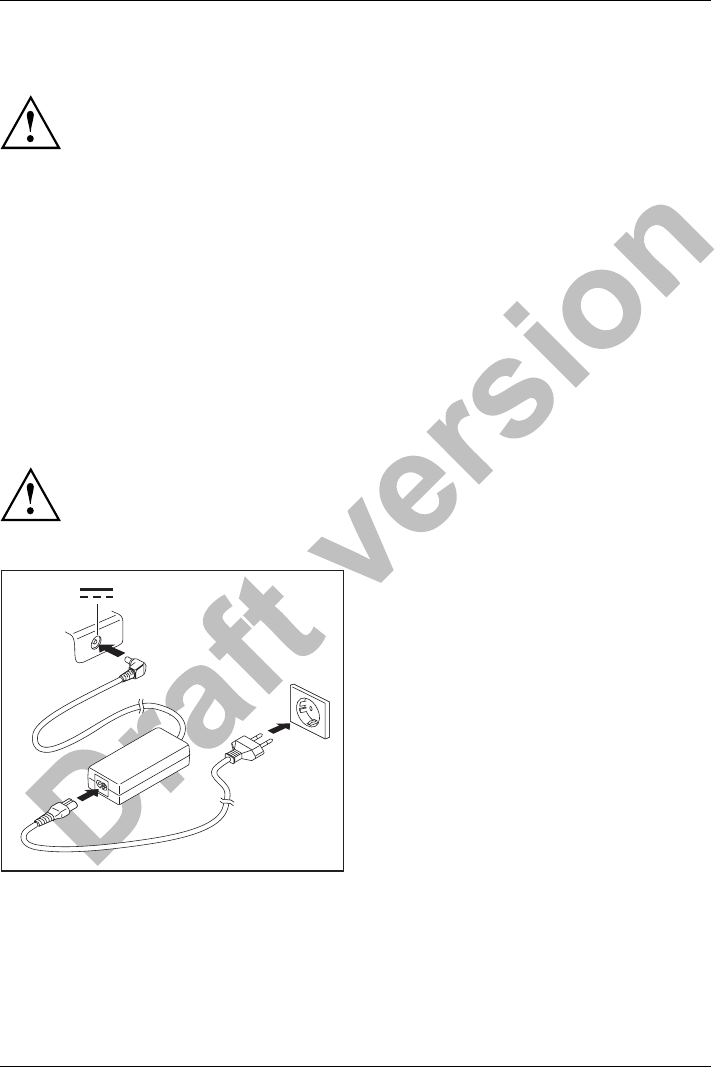
First-time setup of your device
Selecting a location
SelectingalocationDeviceMainsadapt er
Select a suitable location for the device before setting it up. Follow
the instructions below when doing so:
• Never place the device or the mains adapter on a heat-sensitive surface.
The surface could be damaged as a result.
• Never place the device on a soft surface (e.g. carpeting, upholstered furniture,
bed). This can block the air vents and cause overheating and damage.
• The underside of the device heats up during normal operation. Prolonged contact
with the skin may become unpleasant or even result in burns.
• Place the device on a stable, flat, non-slippery surface. Please note that the
rubber feet of the device may mark certain types of delicate surfaces.
• Keep other objects at least 100 mm away from the device and its
mains adapter to ensure adequate ventilation.
• Never cover the ventilation slots of the device.
• Do not expose the device to extreme environmental conditions. Protect
the device from dust, humidity, and heat.
Mains adapter connecting
Preparingforo perationMainsadapter
Observe the safety notes in the enclosed "Safety/Regulations" manual.
The supplied power cable conforms to the requirements of the country in
which you purchased your device. Make sure that the power cable is approved
for use in the country in which you intend to use it.
3
1
2
►Connect the power cable (1) to the
mains adapter.
►Plug the mains cable (2) into a mains outlet.
►Connect the mains adapter cable (3) to
the DC jack (DC IN) of the device.
16 Fujitsu

First-time setup of your device
Switching on the device for the first time
Switchingonforthefirstt ime
On devices with ON/OFF switch for wireless components: Slide the ON/OFF switch
for wireless components to the ON position before switching on the device.
When you switch on the device for the first time, the supplied software is
installed and configured. Because this procedure must not be interrupted,
you should set aside enough time for it to be fully completed and connect
the device to the mains using the mains adapter.
During the installation process, DO NOT restart the device unless
you are requested to do so!
To make it easier to use your device for the first time, the operating system
is pre-installed on the hard disk.
1
►Slide the ON/OFF switch (1) to the right to switch on the notebook.
The ON/OFF switch returns automatically to its original position.
►During installation, follow the instructions on screen.
If a Windows operating system is installed on your device, you will find more
information on the system and drivers, help programmes, updates, manuals etc. on
the device or on the Internet under "http://www.fujitsu.com/fts/support/".
Fujitsu 17
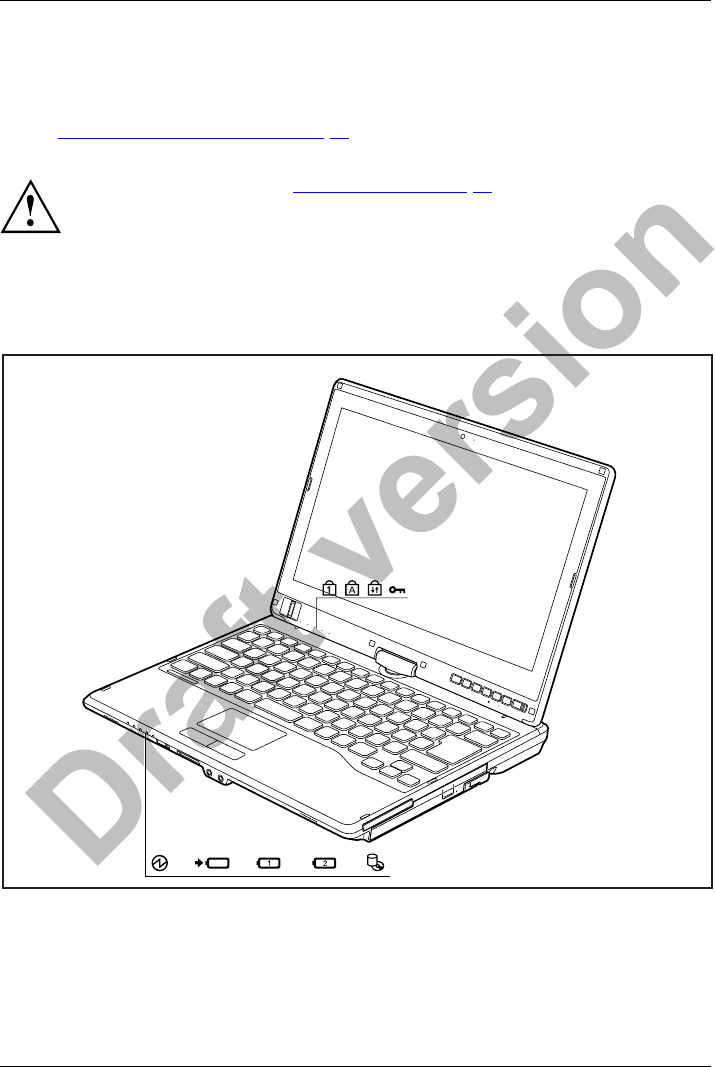
Working with the notebook
Working with the notebook
Notebook,operati onNotebook
This chapter describes the basics for operating your notebook. Please read the chapter
entitled "Connecting external devices", Page 75 for instructions on how to connect
devices such as a mouse and a printer to the notebook.
Please refer to the notes in "Important notes", Page 12.
Status indicators
StatusindicatorsSymbols
The status indicators provide information about the status of the power supply,
the drives and the keyboard functions etc.
18 Fujitsu
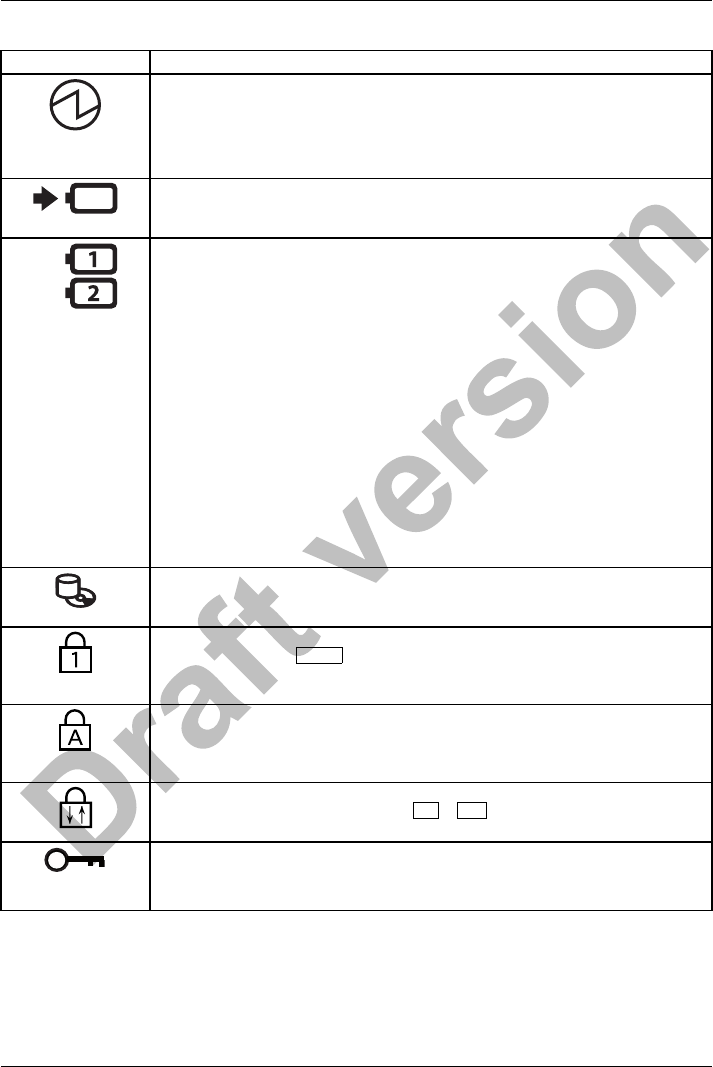
Working with the notebook
Status displays Description
Power-on indicator
• Indicator is illuminated: The notebook is switched on.
• Indicator flashes: The notebook is in sleep mode (Save-to-RAM).
• The indicator is not illuminated: The notebook is switched off or in
Save-to-Disk mode.
Battery charging indicator
The battery charging indicator shows whether a battery is installed and being
charged.
Battery indicator
This description applies for both batteries.
The battery indicator shows the state of charge of the installed battery.
• The indicator is lit green: The battery is between 51 % and 100 %
charged.
• The indicator is lit orange: The battery is between 13 % and 50 %
charged.
• The indicator is lit red: The battery is between 0 % and 12 % charged.
• The indicator flashes orange: The battery state of charge is being
checked (for four seconds after battery installation).
• The indicator flashes red: The battery is faulty.
• The indicator is not lit: There is no battery installed.
Note: if you use batteries with a capacity of 5800 mAh or 6200 mAh, you can
also check the charge status on the battery itself.
Note: You can also check the state of charge directly at the main battery.
Drive indicator
Indicator is illuminated: The hard disk drive or the CD/DVD in the optical drive
of the notebook is being accessed.
Num Lock indicator
Indicator is lit: The Num key has been pressed. The virtual numerical
keypad is activated. You can output the characters indicated on the upper
rightofthekeys.
Caps Lock indicator
Indicator is lit: The Caps Lock key has been pressed. All letters will be output
as uppercase letters. In the case of keys labelled several times, the character
printed on the upper left of the key will appear when that key is pressed.
Scroll Lock indicator
Indicator is lit: The key combination Fn +Scr has been pressed. The effect
that this key has varies between applications.
Lock Workstation indicator
The indicator is illuminated: The security functions of the Notebook have
locked your workstation.
Fujitsu 19
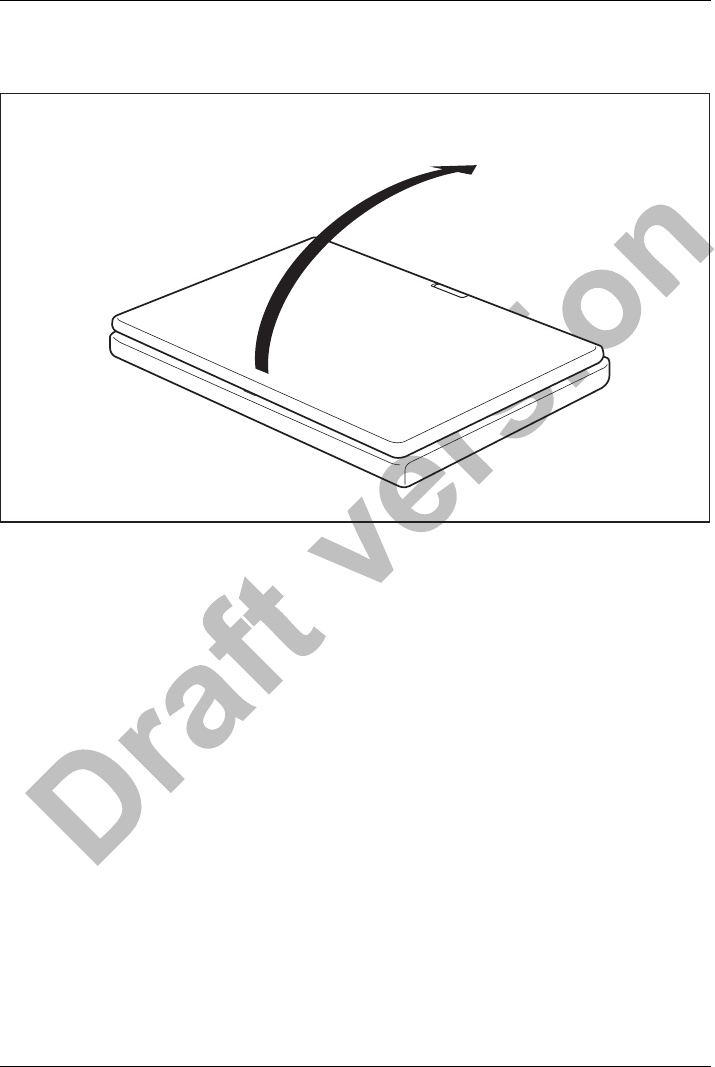
Working with the notebook
Opening the notebook
1
►Open the LCD screen.
20 Fujitsu
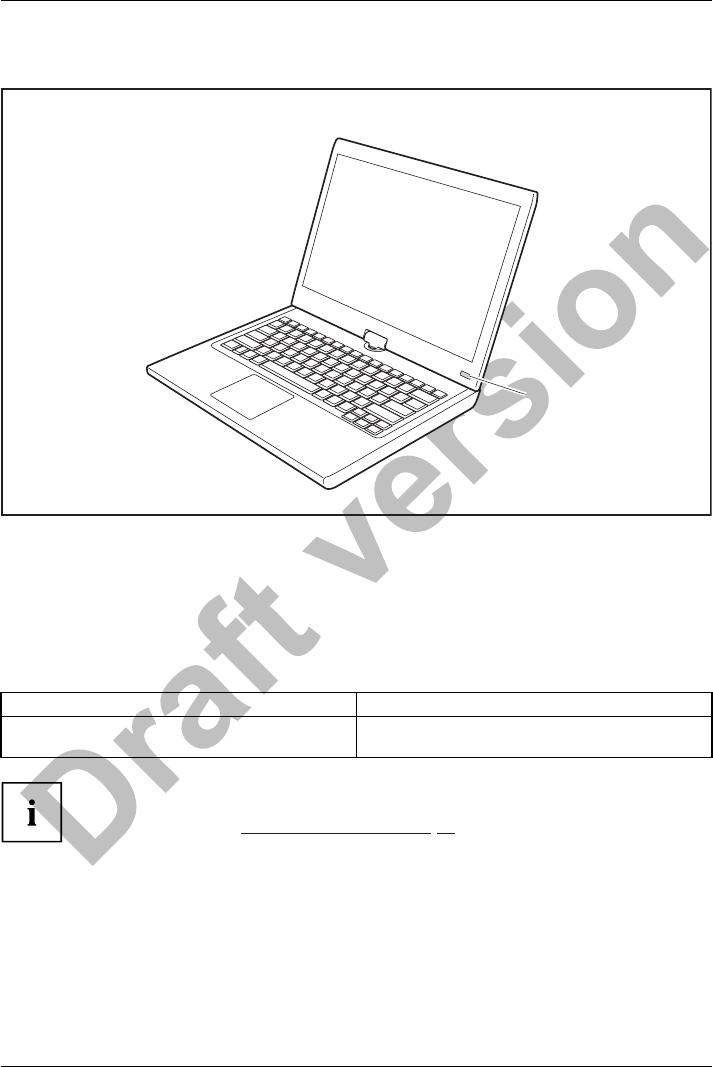
Working with the notebook
Switching on the notebook
Notebook:sw itchingonPower-onindicatorSuspend/Resumebu tton
1
►Slide the ON/OFF switch (1) to the right to switch on the notebook.
The ON/OFF switch returns automatically to its original position.
The ON/OFF switch (1) lights up whenever the system is switched on.
Programming the ON/OFF switch
You can program the ON/OFF switch:
Operating system Menu
Windows 7 Start - (Settings) - Control Panel - System and
Security - Power Options
If you have assigned a password, you must enter this when requested to
do so, in order to start the operating system. Detailed information can be
found in the chapter "Security functions", Page 68.
Fujitsu 21
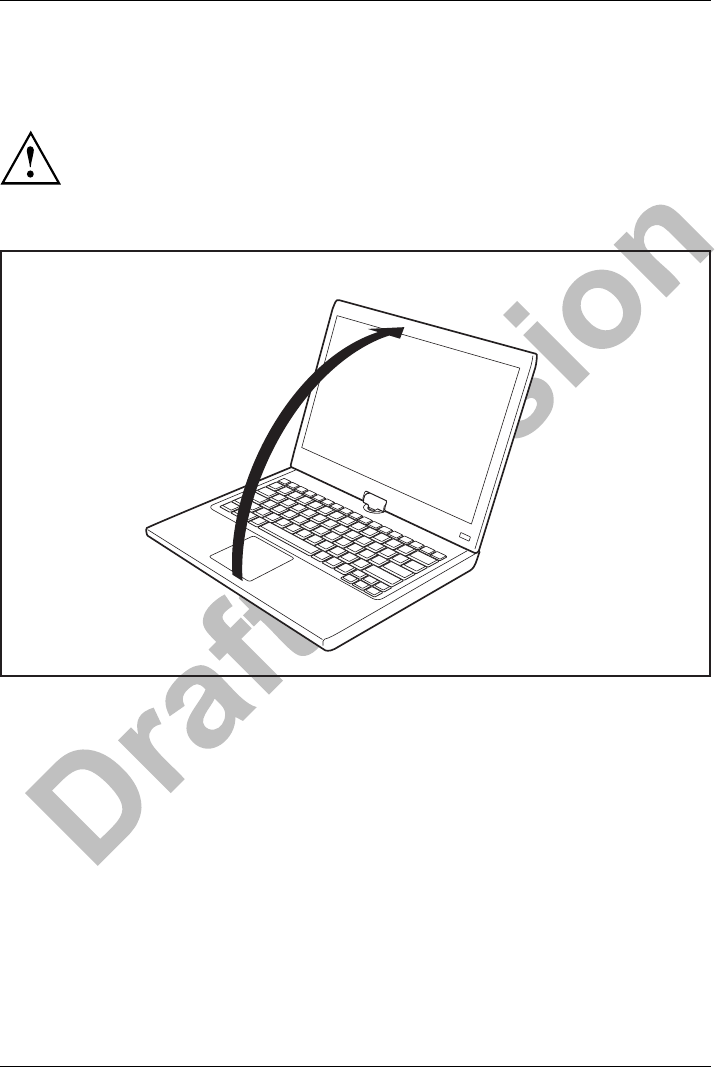
Working with the notebook
Different ways to use your notebook
During your daily work, you can use your notebook as a tablet PC or as a notebook, just as you wish.
Note the direction of rotation in the following description! No guarantee claims
can be met for damage caused by turning in the wrong direction.
You must note that the display cannot be turned completely on its own axis!
From notebook to Tablet PC
►Raise the LCD display into a vertical position.
22 Fujitsu
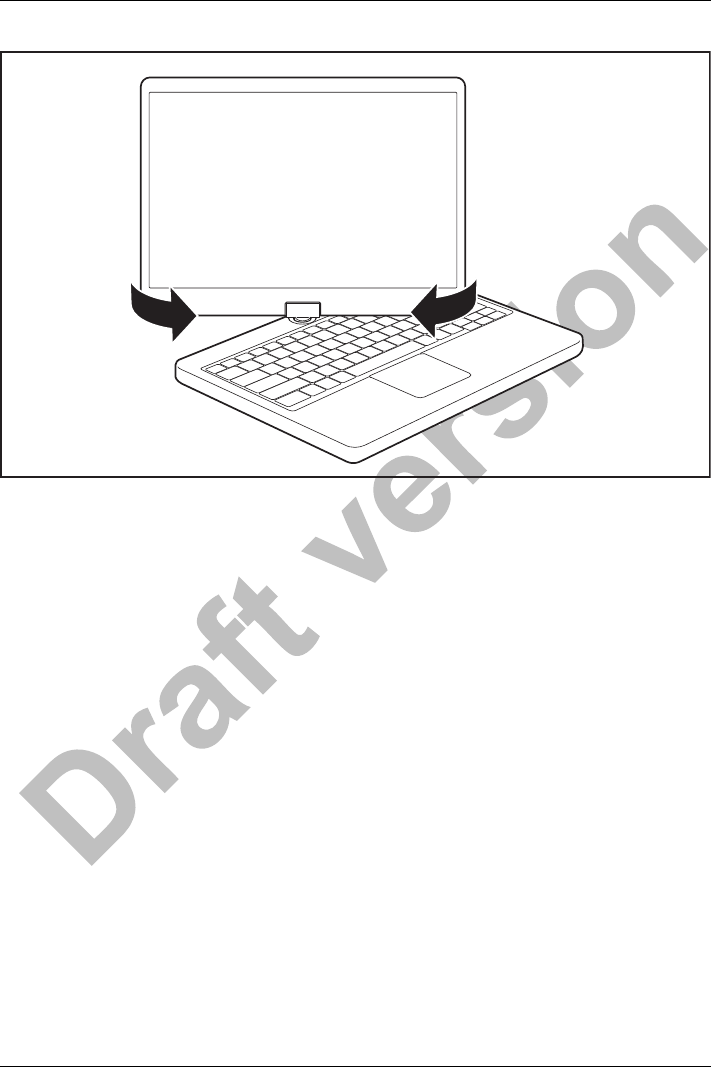
Working with the notebook
►Hold the screen as low as possible on both sides. Turn the screen to the left or right in the direction
of the arrow. At first you will feel some slight resistance, then it will turn easily and without friction.
►Turn the display further until it has turned 180° and the hinge latches in.
Fujitsu 23
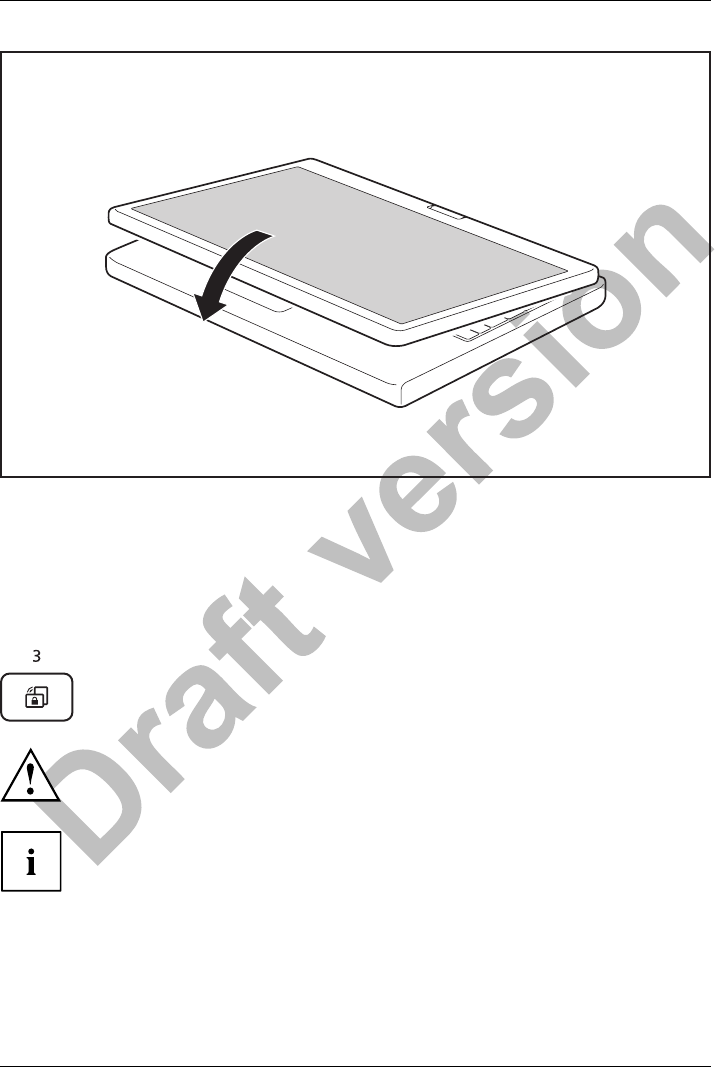
Working with the notebook
►Now fold the screen down until the back of the screen is flat on top of the keyboard.
The screen is now secured in the tablet position.
Select display orientation (portrait or landscape orientation)
Landscapeorientation
Portraitorientation
Displayorientation
You can choose to use either portrait or landscape orientation for the display. To switch
between portrait or landscape orientation, press the tablet button:
Windows 7
You can change these settings in the Fujitsu menu or under Start -(Settings -)
Control Panel -Hardware and Sound -Display -Settings.
Profiles for operating with various different screen modes can be selected via
the Fujitsu Tablet Control option in the Fujitsu menu. These profiles have preset
standard configurations that can be modified as desired.
These settings do not just affect the monitor settings on the Tablet PC, but
also any external monitors that may be connected.
24 Fujitsu
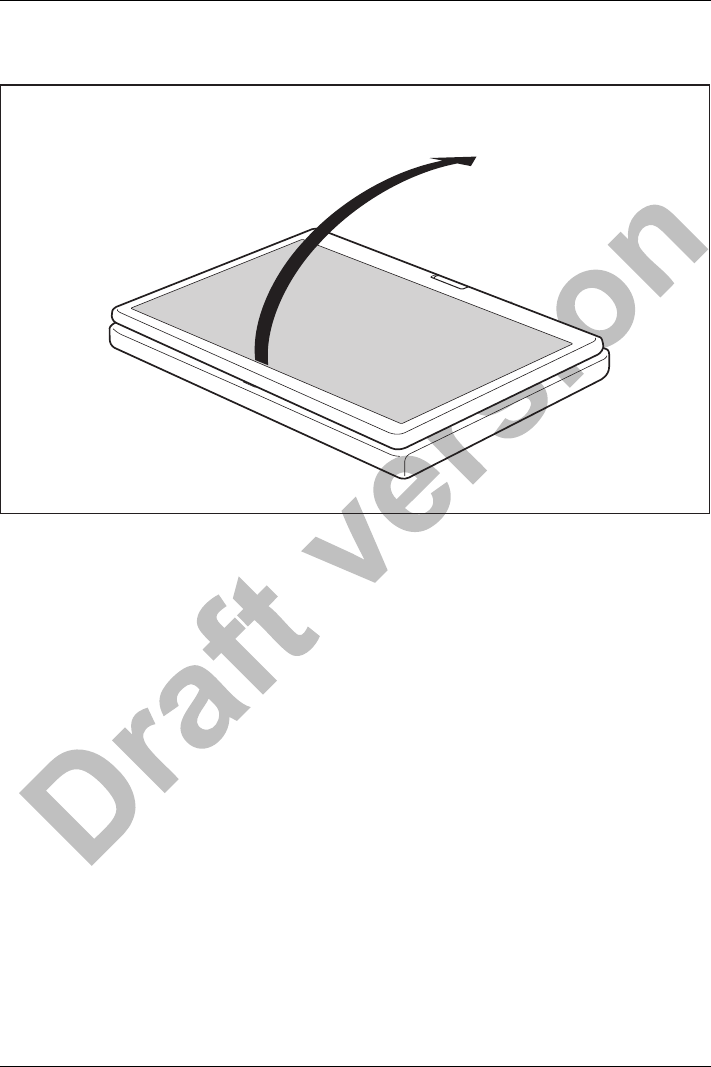
Working with the notebook
From Tablet PC to notebook
1
►Raise the LCD screen into a vertical position.
Fujitsu 25
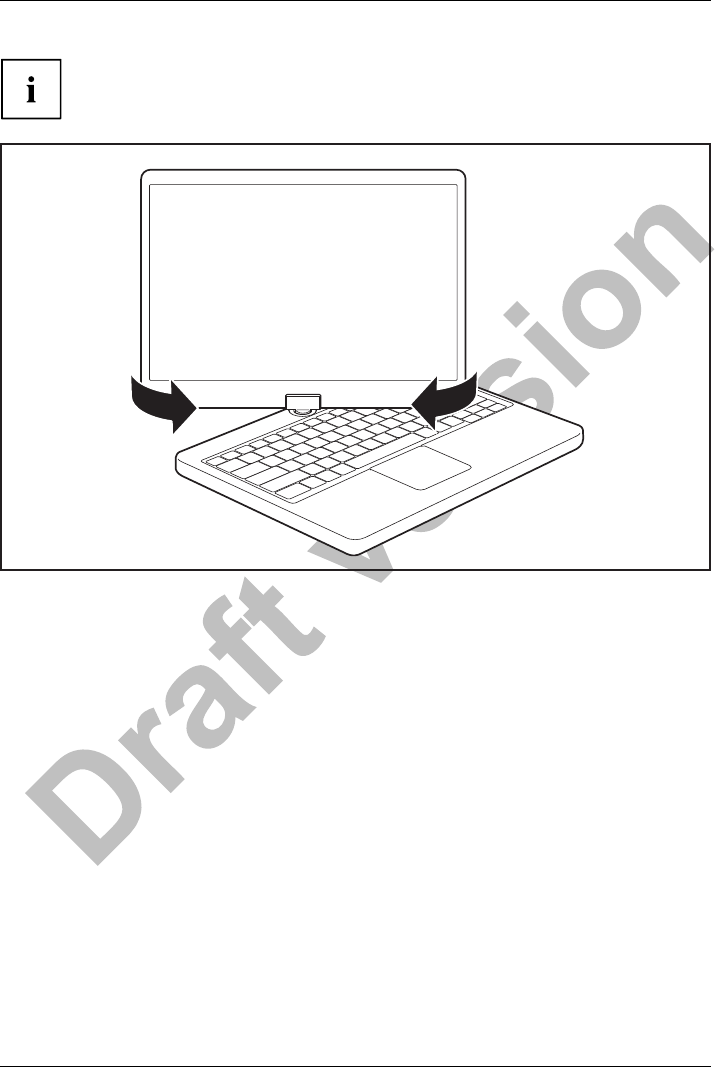
Working with the notebook
Note the direction of rotation in the following description! No guarantee claims
can be met for damage caused by turning in the wrong direction.
►hold the screen as near to the bottom as possible on both sides and turn the screen in the
direction indicated by the rotational direction indicator. It will turn easily and without resistance.
►Turn or move the display further until it has turned 180° and the hinge latches in.
Switching off the notebook
Notebook
►Close all applications and then shut down the operating system (please
see the "Operating System Manual").
►Slide the ON/OFF switch towards the right.
The ON/OFF switch returns automatically to its original position.
26 Fujitsu
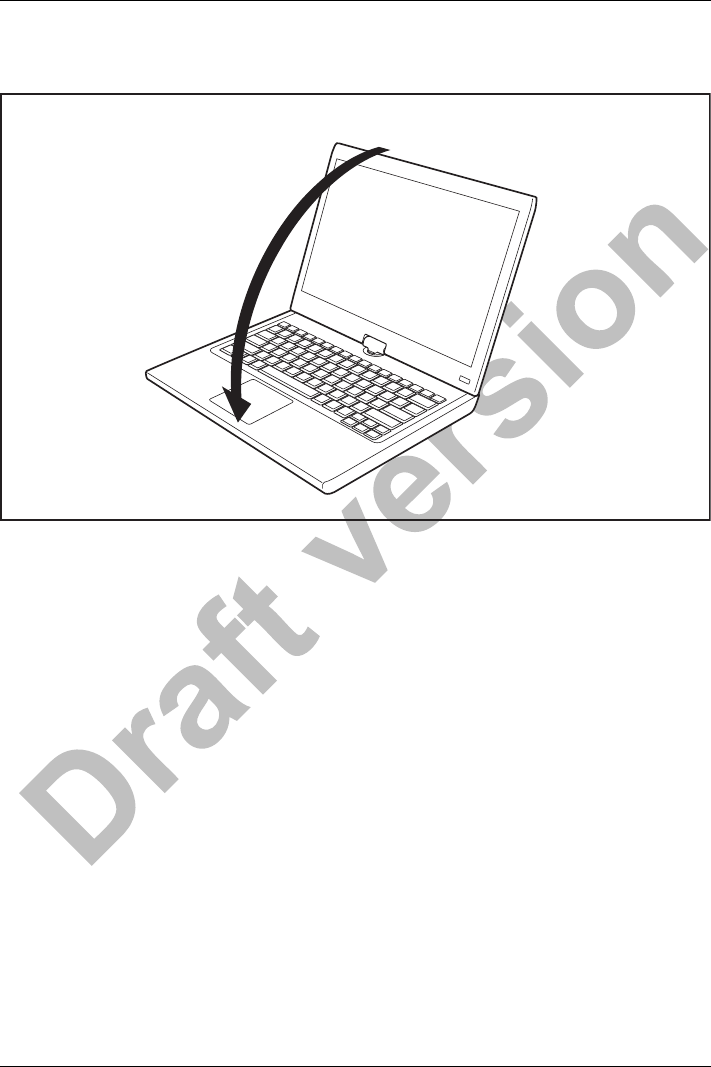
Working with the notebook
Closing the notebook
►Fold the LCD screen down onto the lower part of the notebook until you feel it lock into place.
Handwriting recognition under Windows 7
Handwriting recognition under Windows 7 currently supports the following languages:
English, German, French, Italian, Japanese, Korean, Chinese (traditional and simplified), Dutch,
Portuguese, Spanish, Brazilian, Norwegian (Bokmål and Nynorsk), Swedish, Finnish, Danish,
Polish, Rumanian, Serbian (Cyrillic and Latin script), Catalan, Russian, Czech and Croatian.
Fujitsu 27

Working with the notebook
LCD screen
LCDscreenNotes
High-quality TFT displays are installed in notebooks from Fujitsu Technology Solutions GmbH. For
technical reasons, TFT monitors are manufactured for a specific resolution. An optimal, clear
picture can only be ensured with the correct resolution intended for the relevant TFT monitor. A
monitor resolution which differs from the specification can result in an unclear picture.
The screen resolution of the LCD monitor of your notebook is optimally set at the factory.
The standard of production techniques today cannot guarantee an absolutely fault-free screen
display. A few isolated constant lit or unlit pixels (picture elements) may be present. The maximum
permitted number of pixels faults is stipulated in the international standard ISO 9241-3 (Class II).
Example:
A screen with a resolution of 1280 x 800 has 1280 x 800 = 1024000 pixels. Each pixel consists of
three subpixels (red, green and blue), so there are about 3 million subpixels in total. According to ISO
9241-3 (class II), a maximum of 2 light and 2 dark pixels and in addition 5 light or 10 dark subpixels
or an equivalent mix (1 light subpixel counts as 2 dark subpixels) are allowed to be defective.
At a resolution of 1600 x 900 = 1440000 pixels, a maximum of 3 light and 3 dark pixels
and in addition 7 light or 14 dark subpixels are allowed to be defective.
Pixel A pixel consists of 3 subpixels, normally red, green and
blue. A pixel is the smallest element that can be generated
by complete functionality of the display.
Subpixel A subpixel is a separately addressable internal structure
within a pixel that enhances the pixel function.
Cluster A cluster contains two or more defective pixels or
subpixels in a 5 x 5 pixel block.
Background lighting
TFT monitors are operated with background lighting. The luminosity of the background
lighting can decrease during the period of use of the notebook. However, you can
set the brightness of your monitor individually.
Synchronising the display on the LCD screen and an external monitor
For more information, please refer to the chapter "Key combinations", Page 40
under "Display output, switch between".
Ambient Light Sensor
In the case of delivery with a Windows operating system, the screen brightness is regulated
by means of the ambient light sensor and depending on the particular light conditions. This
results in optimum readability and longer battery life at the same time.
Using a device as a tablet PC
You can execute commands as follows:
• using the stylus pen (supplied with your device).
• using your fingers
28 Fujitsu

Working with the notebook
Using fingers
You can execute certain commands by using your finger tip on the touchscreen of your device.
Everything which you can select or activate using your finger tip can also
be selected or activated using the stylus pen.
Calibrate the Dual Digitizer for finger-based operation of the device.
Please see the appropriate supplementary sheet for instructions on how to
calibrate your device to use Dual Digitizer Technology.
Please note: There are separate calibration programs available for calibrating
the stylus pen and for calibrating finger-based operation. In each case, use the
calibration tool described in the supplementary sheet. Do not use the calibration
tool for the stylus pen to calibrate finger-based operation.
Actions with one finger
Action Description
Selecting objects (click with the left mouse
button)
►With your finger, tap once brieflyonthe
object.
Starting programs (double-click with the left
mouse button)
►With your finger, tap twice briefly in quick
succssion on the program icon.
Moving objects/windows (drag with left mouse
button pressed, Drag & Drop)
►Place a finger directly on the object/window,
hold the finger pressed against the
touchscreen and move the desired
object/window.
Opening a context menu (click with the right
mouse button)
►Touch the desired item once with your finger
tip. Keep the finger tip pressed against the
touchscreen.
The context menu appears.
Moving the cursor ►Position one finger on the touchscreen and
move the finger in the desired direction.
Fujitsu 29
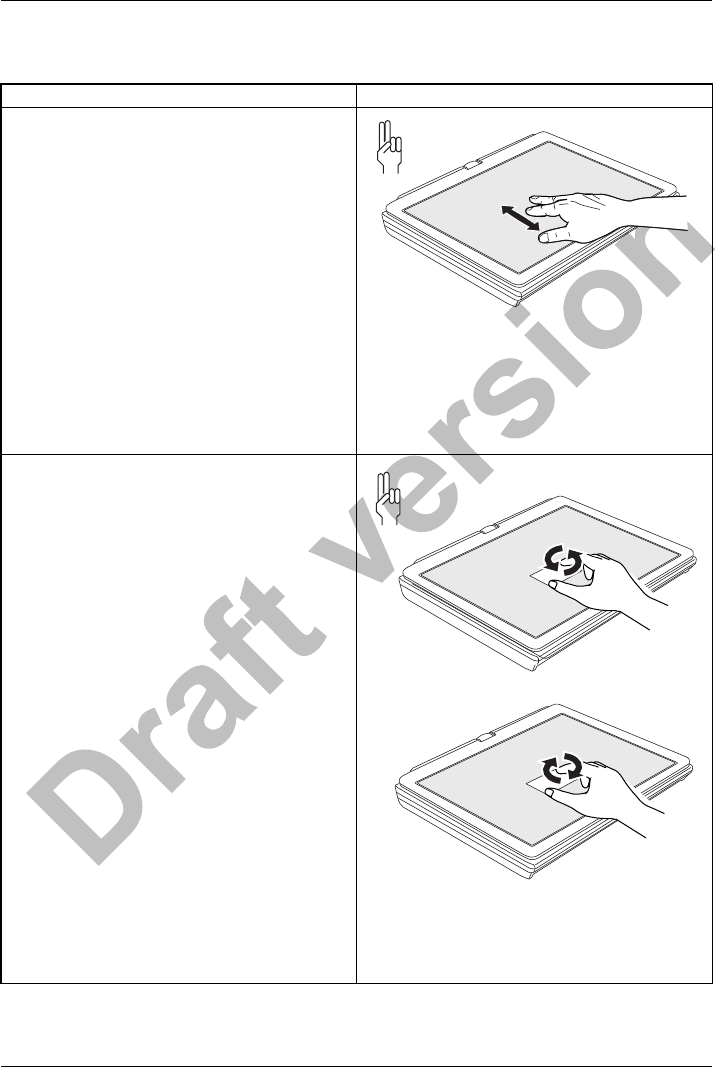
Working with the notebook
Actions with two fingers
Action Description
Scrolling
►Position two fingers on the touchscreen.
►Move your fingers upwards to scroll up.
or
►Move your fingers downwards to scroll
down.
Rotating
►Position the thumb on the touchscreen,
then turn the picture clockwise or
counter-clockwise using your index finger.
30 Fujitsu
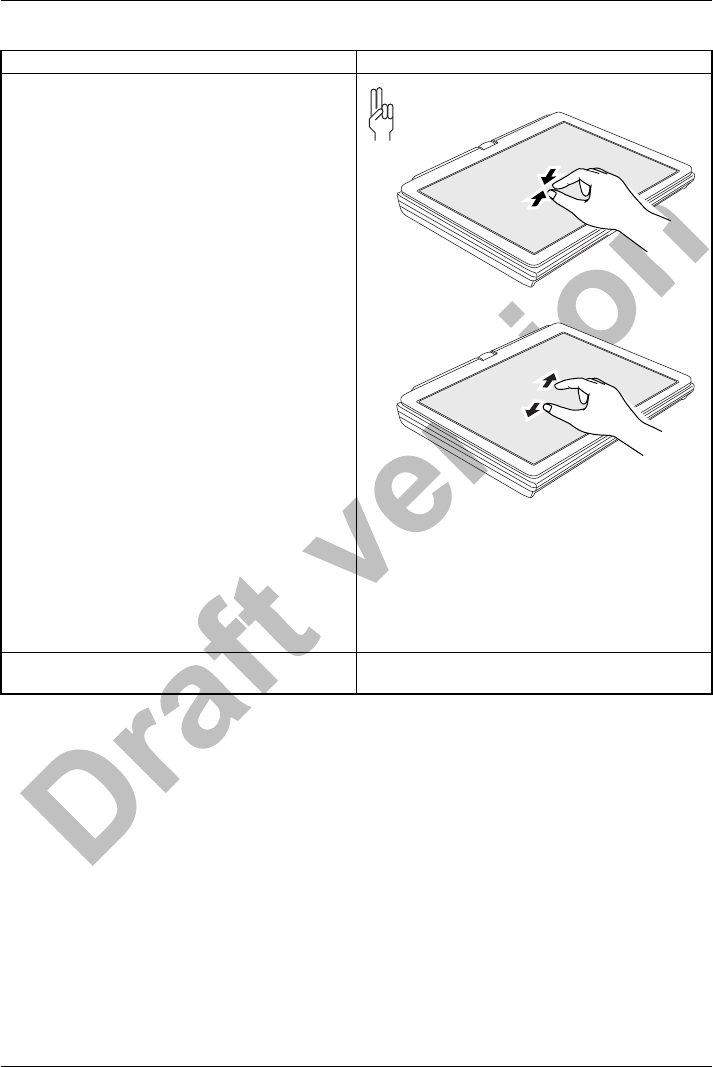
Working with the notebook
Action Description
Increasing or decreasing the view
►Position two fingers on the touchscreen and
move them apart to increase the view.
or
►Position two fingers on the touchscreen and
move them together to decrease the view.
Blocking context-sensitive menus ►With two fingers, tap twice briefly in quick
succession on the touchscreen.
Fujitsu 31
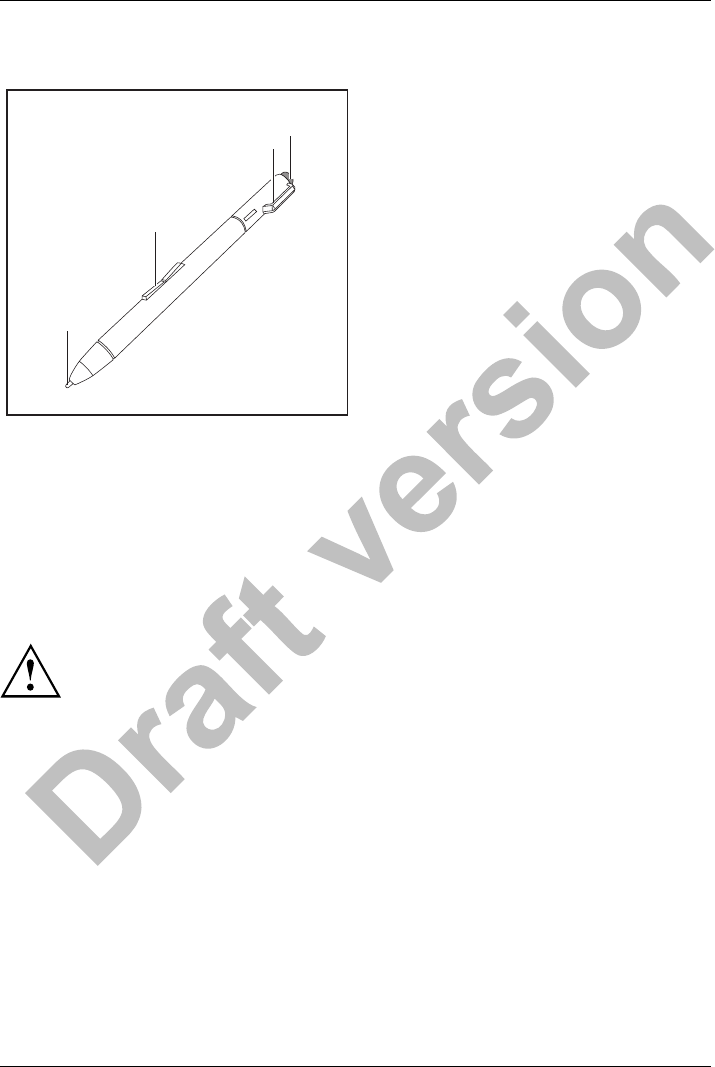
Working with the notebook
Using the stylus pen
3
1
2
4
1 = pen tip
2 = rocker button
3 = eyelet for pen cord
4 = eraser
You can use the pen on your notebook as an electronic writing implement to select
items and to navigate through menu options and programs. Programs that support
handwriting recognition also allow you to write characters directly on the screen with
the pen. You can also use the pen as a drawing tool.
The notebook pen is retained securely in the pen slot. This ensures that the pen cannot be
lost, regardless of whether you use the notebook as a Tablet PC or as a notebook, or transport
it while travelling. Always replace the pen in its slot when you are not using it.
The notebook is supplied with a pen cord which you can attach to the eyelets
on the pen and on the notebook.
Only use the pen provided with your notebook. Do not use substitute pen tips
that were not specially designed for your notebook. Replace the stylus tip if it
is worn. The warranty does not cover a scratched screen.
While writing, you should take care not to scratch the surface of the
display (e.g. with a wristwatch or bracelet).
32 Fujitsu

Working with the notebook
The pen of your notebook is an electronic instrument which can be damaged
if used incorrectly. Handle the pen with care.
The following list contains guidelines for proper pen handling:
• Do not gesture with the pen.
• Do not use the pen as a pointer.
• Never use the pen on any other surface than the screen of your notebook.
• Do not try to turn the thumb grip on the pen. The thumb grip is used to
place the pen in its slot and to take it out of the slot.
• Never store the pen with the tip bearing the weight of the pen (e.g. with the tip down
in a pen holder). If the pen is stored with the tip pointing down, this may have
an adverse effect on the pen mechanism (particularly under high temperatures).
In this case the pen tip may react as though it is constantly being pressed down.
To avoid damage, the pen should be stored in the pen slot when not in use.
Thepencanbeinfluenced by electromagnetic fields (cursor quivers or
jumps). There may be a few areas on the screen where the cursor quivers
slightly in spite of pressing the pen down firmly.
The screen responds to entries made with the tip of the finger or the pen when the tip
of the finger or the pen is in direct contact with the screen.
You can use the pen to perform all the functions for which you would otherwise use a mouse.
In addition, you can conveniently delete hand-written pen entries using the pen.
Handling Mouse Pen
Selecting menu
entries Click with the left-hand mouse button. Touch the menu entry with the pen tip.
Starting programs Double click with the left-hand mouse
button. Briefly touch the program icon twice
with the pen tip.
Moving
objects/windows Drag with the left-hand mouse button
held pressed. Place the pen tip directly on the
object/window. Hold the pen tip
pressed against the screen. Move the
desired object/window.
Opening a context
menu Click with the right-hand mouse
button. Touch the desired element with the
pen and leave the pen on the element
for a moment.
Moving the cursor -Place the pen tip directly on the
screen.
Setting the pen
Operating system Menu
Windows 7 Under Hardware and Sound – Pen and Input Devices in the Control Panel
you can change various settings for the pen (assignment and function of
the pen button).
Fujitsu 33
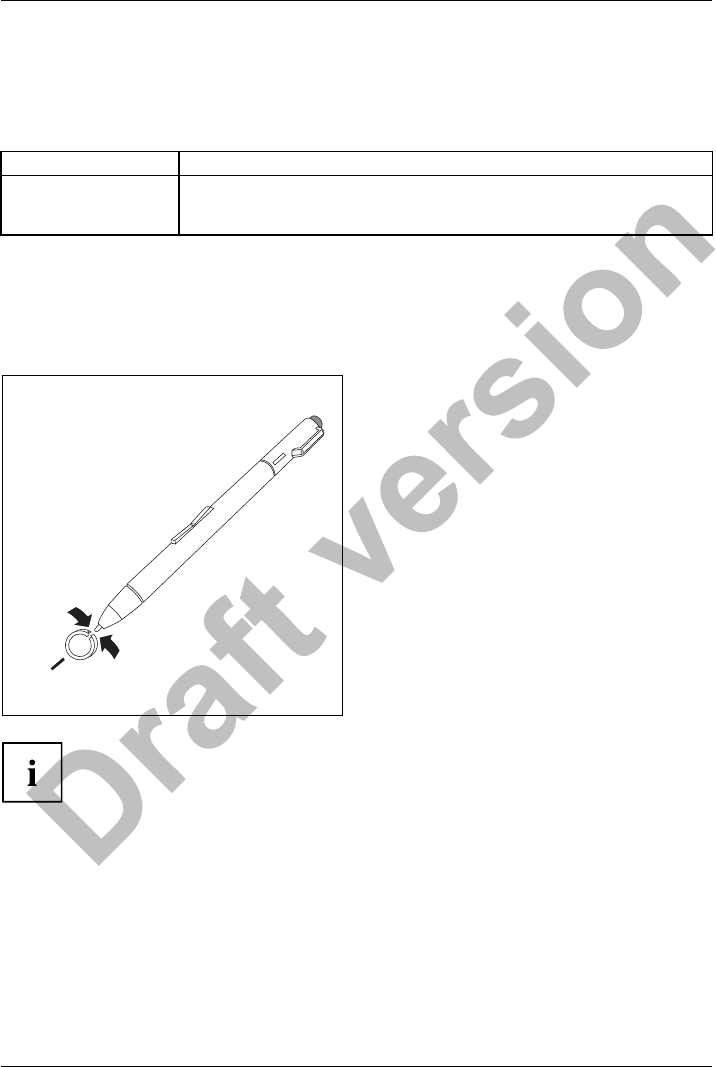
Working with the notebook
Calibrating the pen
Before using the pen for the first time, you should calibrate it so that the cursor follows the
movements of the pen as accurately as possible. You should also always repeat the calibration
if the co-ordination between the pen and cursor movement deteriorates.
Operating system Menu
Windows 7 To calibrate, call up the Hardware and Sound / Tablet PC Settings function
in the Control Panel. You need to calibrate both portrait and landscape
formats.
Replacing the pen tip
With use, the pen tip may become worn or may pick up foreign particles that can scratch the screen.
A damaged or worn tip may not move freely, causing unpredictable results when using the pen.
If your pen exhibits these problems, you should replace the pen tip. To do this, use the supplied tool (1).
1
►To remove the tip, position the tip in the gap
between the two ends of the tool supplied.
►Pinch the two ends of the supplied tool
together so that thetipisfirmly clasped,
then pull it from the barrel.
►To replace the tip, retrieve one of the
new tips that were supplied your pen.
Insert the flat end of the tip into the
barrel and exerting gentle pressure, push
it in until it is firmly in place.
If the tip is worn or damaged, discard it.
Installing a pen cord
You should attach the pen with a pen cord to prevent accidentally dropping or losing it.
►Attach the end of the pen cord with the smaller loop to your pen.
►Attach the end of the pen cord with the larger loop to your notebook.
34 Fujitsu
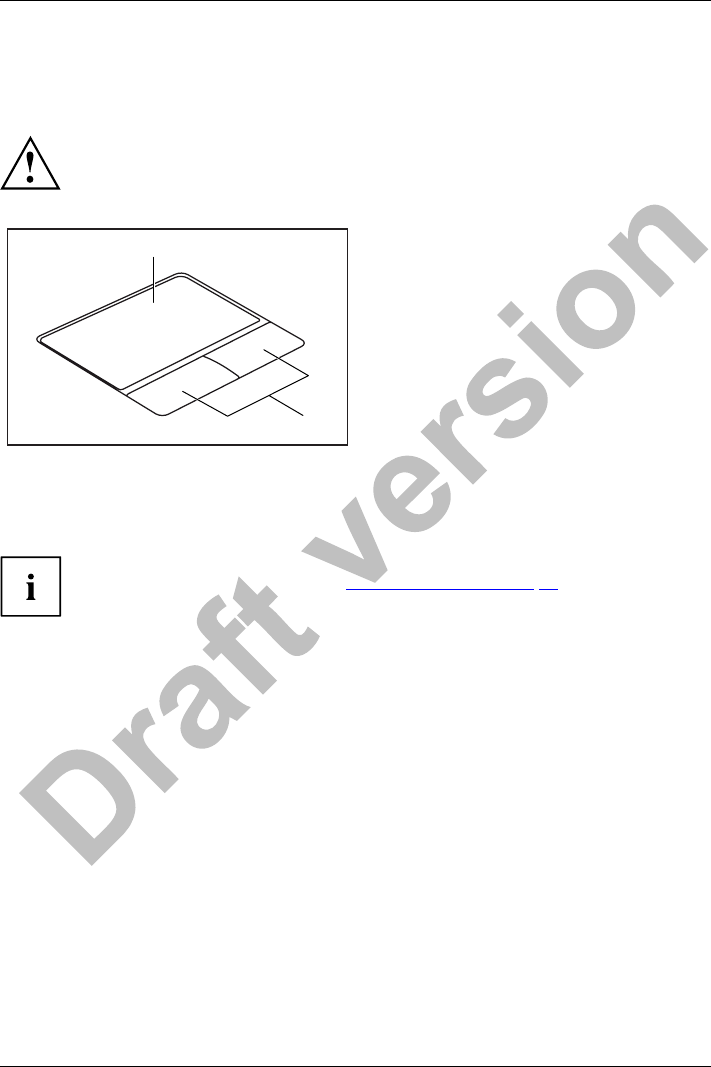
Working with the notebook
Using the device as a notebook
Touchpad and touchpad buttons
Keep the touchpad clean. Protect it from dirt, liquids and grease.
TouchpadTouchpad
Do not use the touchpad if your fingers are dirty.
Do not rest heavy objects (e.g. books) on the touchpad or the touchpad buttons.
1
2
1 = Touchpad
2 = Touchpad buttons
The touchpad enables you to move the mouse pointer on the screen.
The touchpad buttons allow you to select and execute commands. They correspond
to the buttons on a conventional mouse.
You can use a key combination to disable the touchpad, to avoid accidentally moving
the pointer on the screen (see also "Key combinations", Page 40).
Moving the pointer
►Move your finger on the touchpad.
Touchpad
The pointer will move.
Selecting anitem
►Move the pointer to the item you wish to select.
Touchpad
►Tap the touchpad once or press the left button once.
The item is selected.
Executing commands
►Move the pointer to the field you wish to select.
Tou chp ad
►Tap the touchpad twice or press the left button twice.
The command is executed.
Fujitsu 35

Working with the notebook
Dragging items
►Select the desired item.
Touchpad
►Press and hold the left button and drag the item to the desired position
with the finger on the touchpad.
The item will be moved.
Switching the Touchpad on and off
You can switch the Touchpad on and off using a key combination,
see "Key combinations", Page 40.
36 Fujitsu
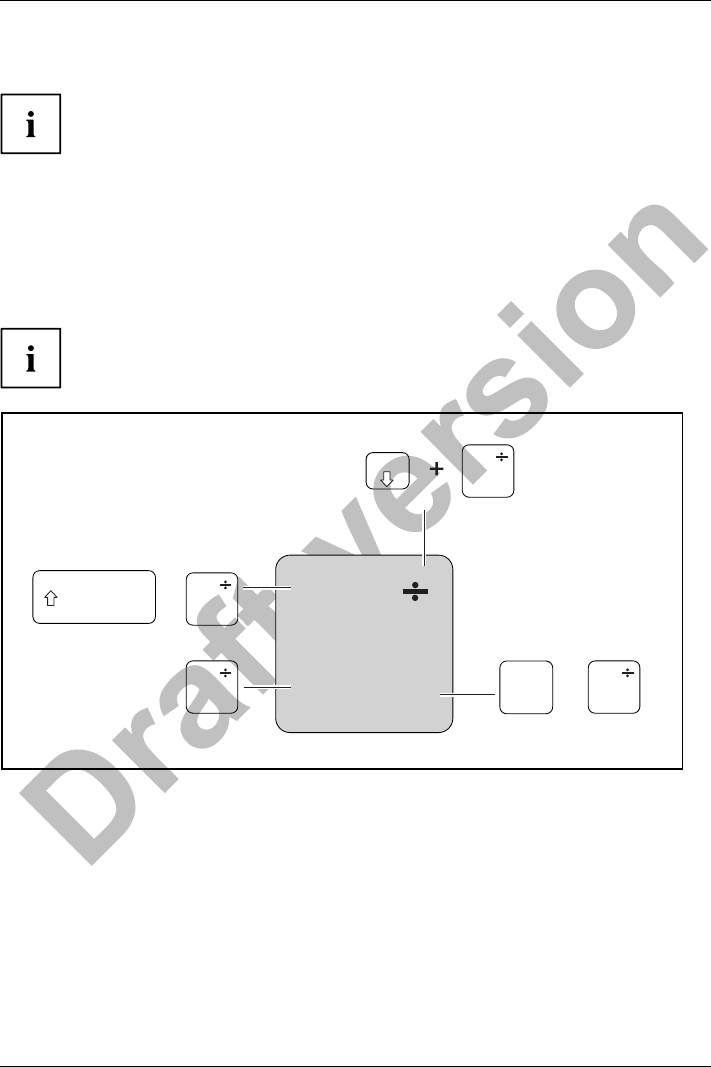
Working with the notebook
Keyboard
KeyboardNumerickeypadNumer ickeypadButtons
The keyboard of your notebook is subject to continuous wear through normal
use. The key markings are especially prone to wear. The key markings are
liable to wear away over the life of the notebook.
The keyboard has been designed to provide all the functions of an enhanced keyboard.
Some enhanced keyboard functions are mapped with key combinations.
The following description of keys refers to Windows. Additional functions supported by the keys
are described in the relevant manuals supplied with your application programs.
The figure below shows how to access the different characters on keys with overlaid functions.
The example applies when the Caps Lock key has not been activated.
The illustrations shown below may differ from your actual device.
0
=
}
+
+
Num
Alt Gr
=
0}
=
0}
=
0}
=
0}
Fujitsu 37
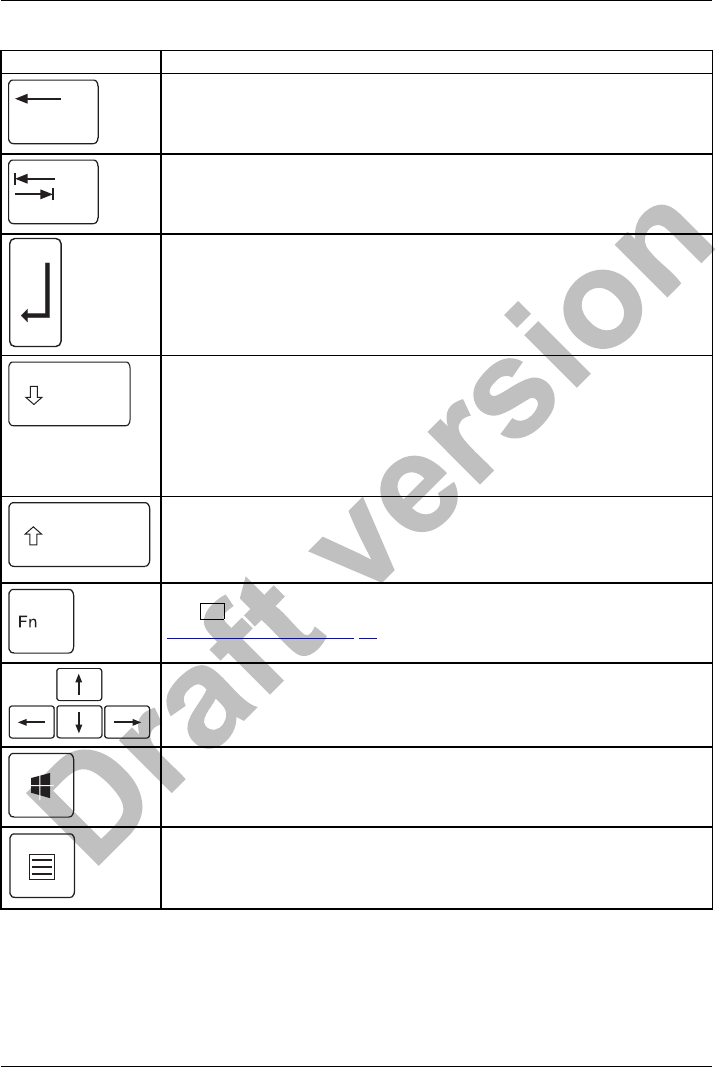
Working with the notebook
Key Description
Backspace key
The Backspace key deletes the character to the left of the cursor.
BackspaceBac kspace
Tab key
The Tab key moves the cursor to the next tab stop.
Tabkey
Enter key (return)
The Enter key terminates a command line. The command you have entered
is executed when you press this key.
EnterkeyReturnEnterLinef eed
Caps Lock key
The Caps Lock key activates the Caps Lock mode, and the corresponding
icon is displayed in the Windows information area. In Caps Lock mode, all
of the characters you type appear in upper case. In the case of overlay
keys, the character printed on the upper left of the key will appear when
that key is pressed. To cancel the Caps Lock function, simply press the
Caps Lock key again.
ShiftkeyCapsLock
Shift key
The Shift key causes uppercase characters to appear. In the case of overlay
keys, the character printed on the upper left of the key appears when that
keyispressed.
ShiftkeyShift
Fn button
The Fn key enables the special functions indicated on overlay keys (see
"Key combinations", Page 40).
Fnkey
Cursor keys
The cursor keys move the cursor in the direction of the arrow, i.e. up, down,
left, or right.
CursorkeysCursorcontrolkeys
Start key
The Start key opens the Windows Start menu.
Startkey
Menu key
The Menu key invokes the menu for the marked item.
38 Fujitsu
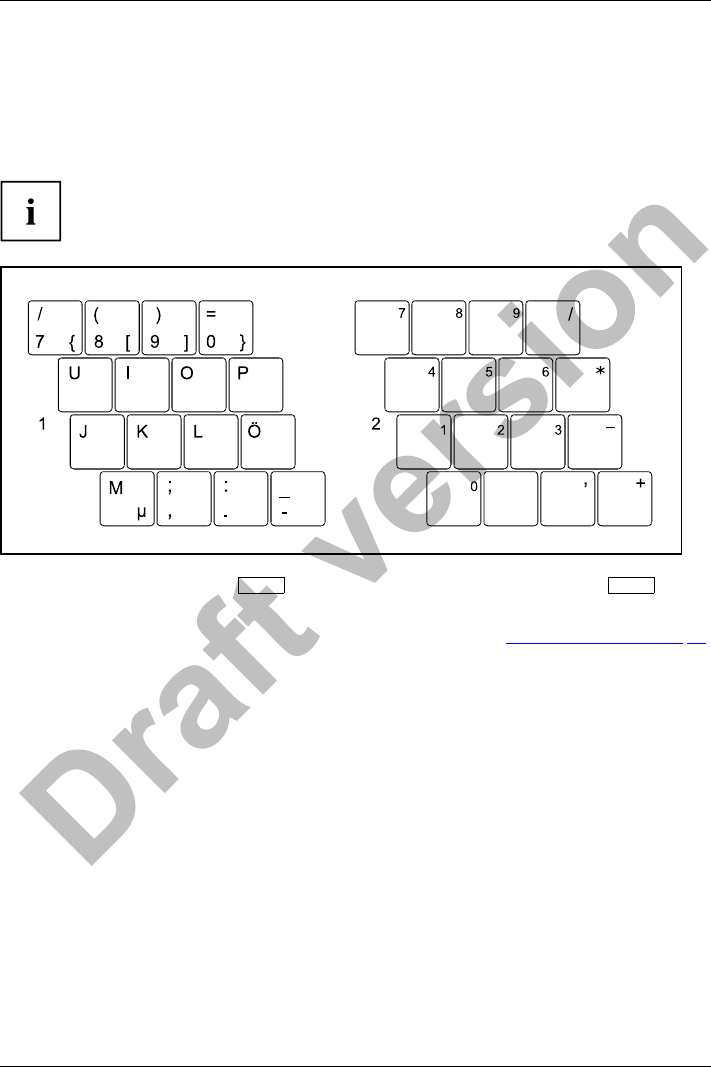
Working with the notebook
Virtual numeric keypad
NumerickeypadVirtualnumericke ypadNumLock
To provide the convenience of a numeric keypad, your keyboard is equipped with a virtual
numeric keypad. The special keys of the virtual numeric keypad are recognisable by the numbers
and symbols printed in the upper right corner of each key. If you have switched on the virtual
numeric keypad, you can output the characters shown on the upper right of the keys.
The keyboard layout shown below may differ from your actual device.
1 = Valid characters when the Num
key is not activated 2 = Valid characters when the Num
is activated
Further information about the status indicators can be found in chapter "Status indicators", Page 18.
Country and keyboard settings
If you want to change the country and keyboard settings, proceed as follows:
►Enter the settings by clicking Start – (Settings) – Control Panel – Time, Regional and Language Options.
Fujitsu 39
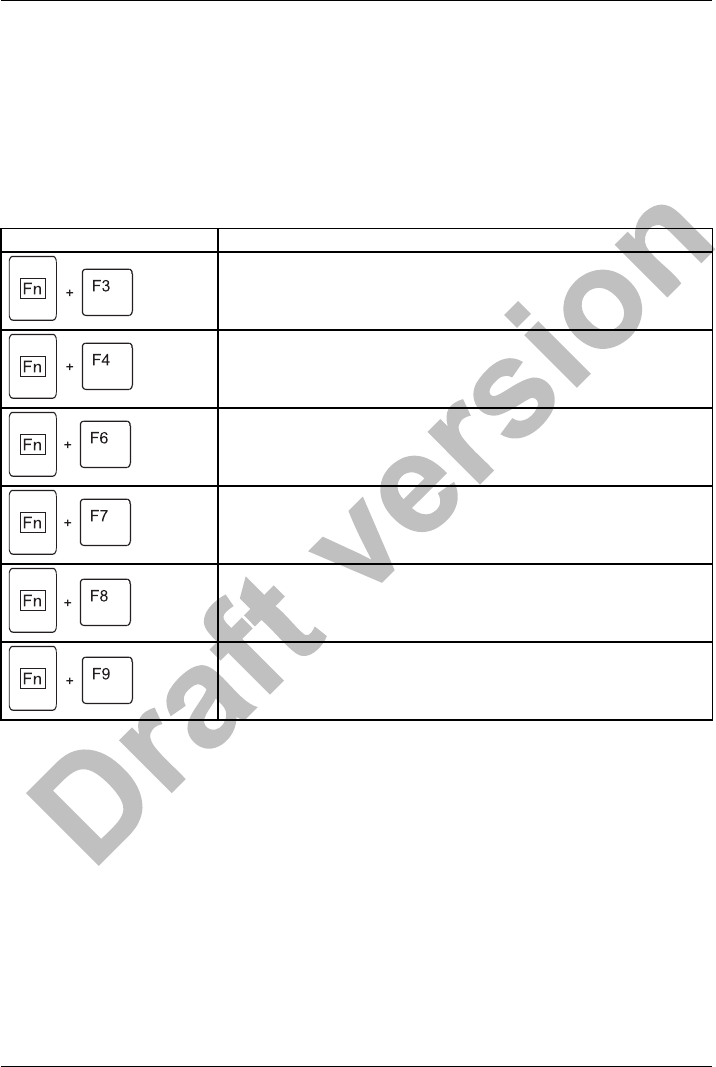
Working with the notebook
Key combinations
The key combinations described below apply when using Microsoft Windows
operating systems. Some of the following key combinations may not function in
other operating systems or with certain device drivers.
Key combinations are entered as follows:
►Press the first key in the combination and keep it pressed.
►While holding the first key down, press the other key or keys in the combination.
Combination Description
Switching the loudspeakers on/off
This key combination switches the integrated loudspeakers on and
off.
Fn+F3Loudspea kerLoudspeaker
Enable/disable touchpad
This key combination enables and disables the touchpad.
Fn+F4TouchpadTouchpadbuttonsTouchpad
Decrease screen brightness
This key combination decreases the brightness of the screen.
Fn+F6LCDscreenScreenbrightness
Increase screen brightness
This key combination increases the brightness of the screen.
Fn+F7Screen brightness
Decrease volume
This key combination reduces the volume of the internal
loudspeakers.
Fn+F8Volume
Increase volume
This key combination increases the volume of the internal
loudspeakers.
Fn+F9Volume
40 Fujitsu
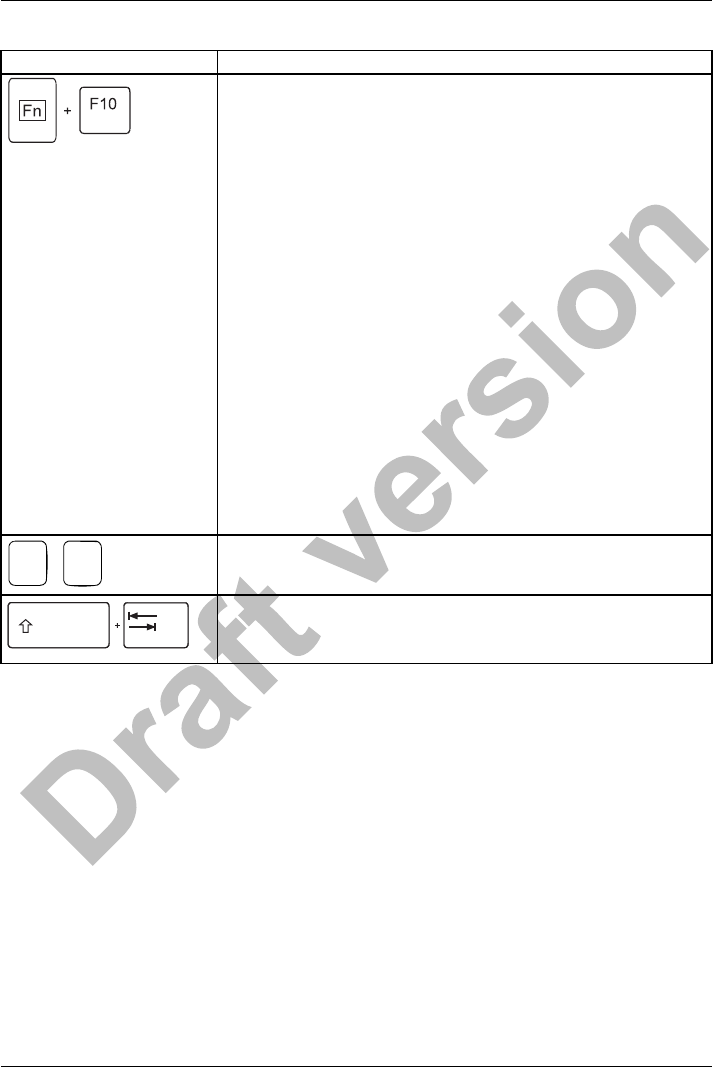
Working with the notebook
Combination Description
Toggle output screen
Fn+F10Toggleoutputs creen
Use this key combination to select which screen(s) is/are used for
display if an external monitor is connected.
Screen output is possible:
• only on the notebook’s LCD screen
• only on the external monitor
• on the notebook’s LCD screen and the external monitor at the
same time.
Press the key combination several times to switch through all
possible settings.
It is possible to display video on two screens simultaneously,
regardless of the type and number of external screens connected.
If you have connected two external monitors to the port replicator,
the following display outputs are possible:
• only on the notebook’s LCD screen
• only on the external monitor (analogue)
• at the same time on the LCD screen (digital)
• at the same time on the notebook’s LCD screen and on the
external monitor (analogue)
You cannot use the key combination to switch output at the same
time to both external monitors on the Port Replicator.
+
Ctrl CHalt current operation
This key combination can be used to halt an operation instantly
without clearing the keyboard buffer.
Back tab
This key combination moves the cursor back to the previous tab
stop.
Shift+TabTabback
Fujitsu 41
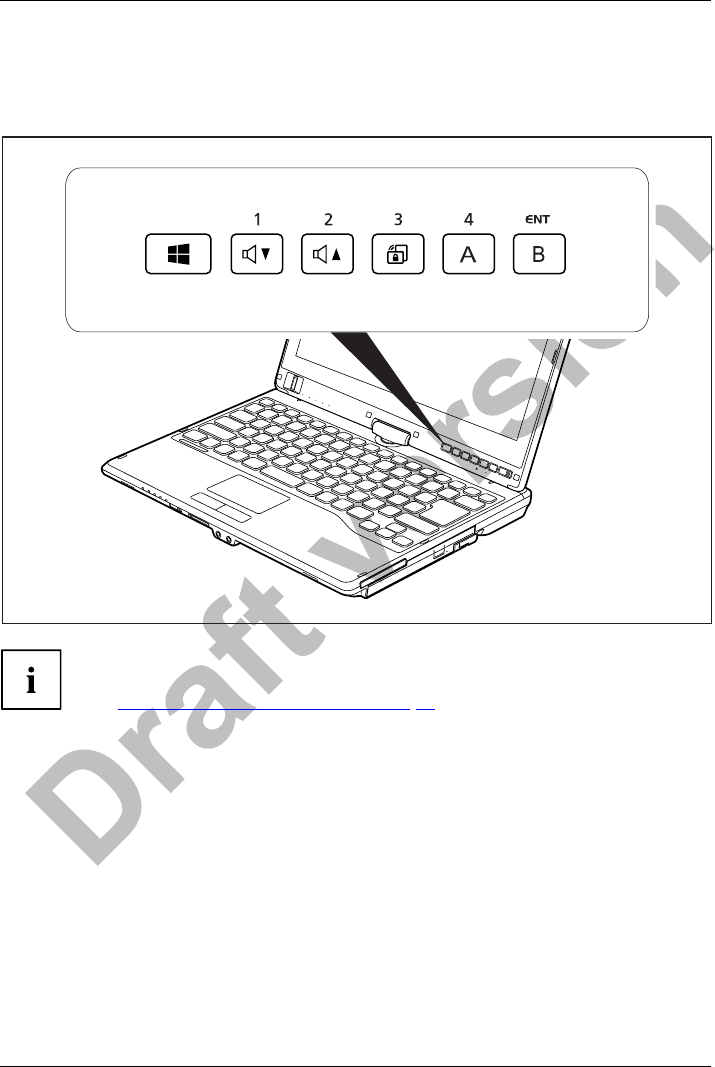
Working with the notebook
Tablet buttons
Your notebook has six multifunctional tablet buttons. You can navigate on the screen with a
simple press of a button, call preset applications or ones that you have set yourself.
The tablet buttons have different uses in different modes.
In addition, you can still individually program some of the tablet buttons,
see "Programming the tablet buttons", Page 43.
42 Fujitsu
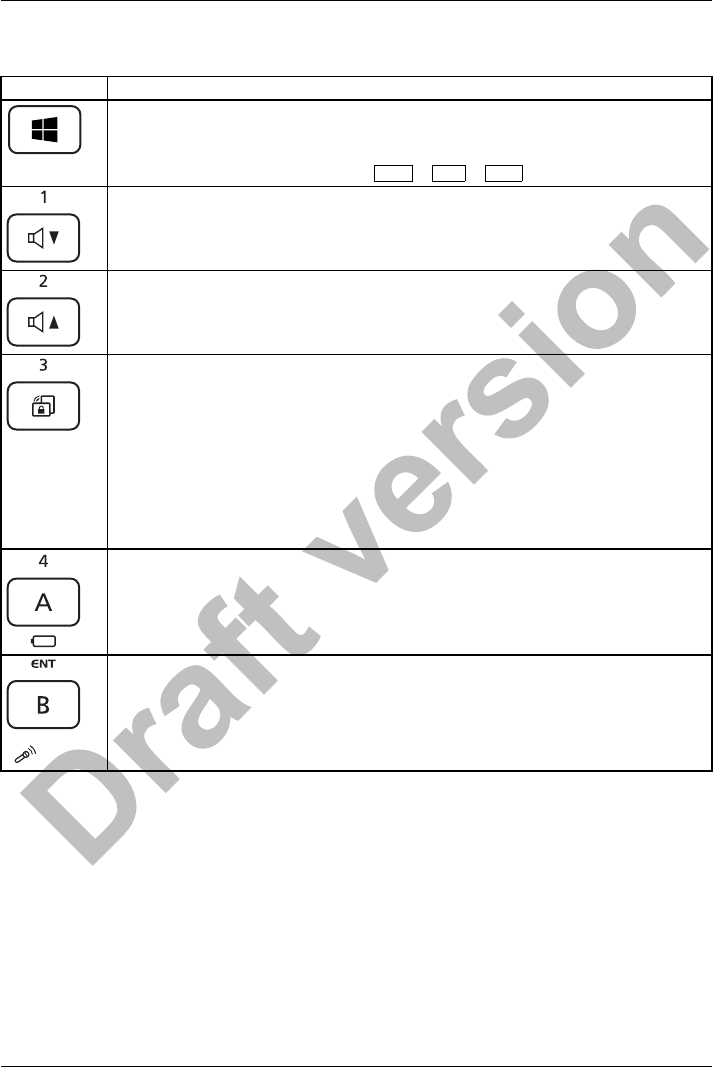
Working with the notebook
Basic functions when the device has booted
Button Basic function
Windows button
This button corresponds to the function of the Windows Start key on a keyboard.
If the button is pressed in combination with the ON/OFF switch, the function
corresponds to the key combination Ctrl +Alt +Del .
Decrease volume
This button reduces the volume of the built-in loudspeakers.
Increase volume
This button increases the volume of the built-in loudspeakers.
Rotation Lock
When you press this button, the orientation of the screen display changes from
portrait (vertical) to landscape (horizontal) or vice versa.
When you would like to use the Tablet PC as an eBook, for example, you would
use the portrait orientation.
When accessing spreadsheets, you would more typically use a landscape
orientation.
Windows 7:
This button locks and unlocks the automatic rotation of the display.
Button "A"
This button starts the Fujitsu Menu application. You can use this application to
change certain system settings.
The button is freely programmable.
Button "B"
Use this button to start the Windows Journal.
The button is freely programmable.
Programming the tablet buttons
You can program the tablet buttons to open a specific application or execute
a specific function when pressed.
Proceed as follows:
►In Control Panel, select the option to manage the settings for the tablet buttons and pen.
►Follow the instructions on the screen and program the tablet buttons as you require.
Fujitsu 43

Working with the notebook
Webcam
Webcam
Depending on the software used, you can use your Webcam to take pictures,
record video clips or take part in web chats.
• The picture quality depends on the lighting conditions and the software being used.
• You can only operate the webcam with a particular application (e.g. an Internet telephony
program or a video conferencing program which supports a webcam).
• When using the webcam the notebook support must not wobble.
• The webcam automatically adjusts itself to the current light level. For this reason
the LCD screen may flicker while the light level is adjusted.
Further information on using the webcam and on the additional settings
which are possible for your webcam can be found in the help function
of the program which uses the webcam.
If you would like to perform a function test of your web cam, there is suitable test
software available at "http://www.fujitsu.com/fts/support/index.html".
44 Fujitsu

Working with the notebook
Rechargeable battery
RechargeablebatteryBatteryLife,batteryRechargeablebatteryRechargeablebattery
When not plugged into a mains socket, the notebook runs on its built-in battery. You
can increase the life of the battery by caring for the battery properly. The average
battery life is around 500 charge/discharge cycles.
You can extend the battery life by taking advantage of the available energy saving functions.
Charging, caring for and maintaining the battery
BatteryBattery
The notebook battery can only be charged, when the ambient temperature
is between 5°C and max. 35°C.
You can charge the battery by connecting the notebook to the mains adapter
(see "Mains adapter connecting", Page 16).
If the battery is running low you will hear a warning alarm. If you do not connect the mains adapter
within five minutes of the warning alarm described above, your notebook will automatically switch off.
monitoring the battery charging level
BatteryBatterystatusmeter
Windows also has a "Battery status meter" in the taskbar for monitoring the battery capacity. When
you place the mouse pointer on the battery symbol, the system displays the battery status.
The battery capacity can be monitored using an indicator which shows the current state
of charge. Use the following menu to enable this feature:
Operating system Menu
Windows 7 Start – (Settings) – Control panel – Mobile PC –
Power options
Battery storage
BatteryBatterySelf-discharge,battery
Chargingcapacity, battery
Keep the battery pack between 0°C and +30°C. The lower the temperature at which
the batteries are stored, the lower the rate of self-discharge.
If you will be storing batteries for a longer period (longer than two months),
the battery charge level should be approx. 30 %. To prevent exhaustive
discharge which would permanently damage the battery, check the level
of charge of the battery at regular intervals.
To be able to make use of the optimal charging capacity of the batteries, the battery
should be completely discharged and then fully recharged.
If you do not use the batteries for long periods, remove them from the
notebook. Never store the batteries in the device.
Fujitsu 45
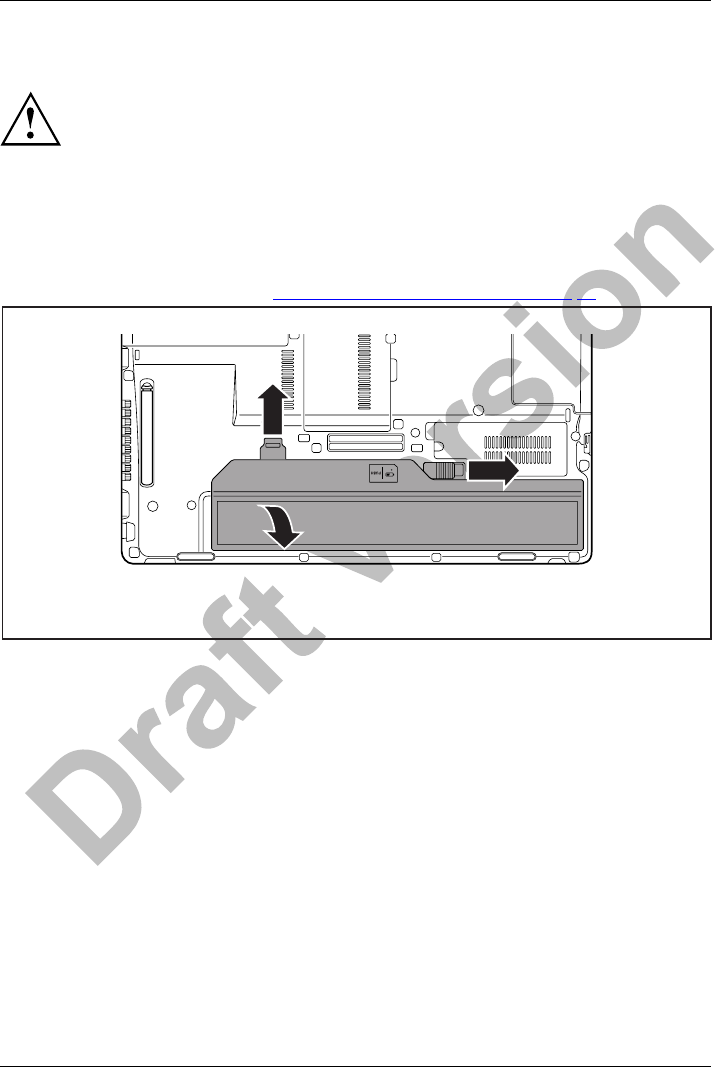
Working with the notebook
Removing and installing the battery
Only use rechargeable batteries approved by Fujitsu Technology
Solutions for your notebook.
Never use force when fitting or removing a battery.
Make sure that no foreign bodies get into the battery connections.
Never store a battery for longer periods in the discharged state. This
can make it impossible to recharge.
Removing the battery
►Prepare for removal, see chapter "Preparing to remove components", Page 83.
2
1
3
►Slide the release button (1) in direction of the arrow.
►Slide the release button (2) in direction of the arrow.
►Lift the battery out of the battery compartment (3).
46 Fujitsu
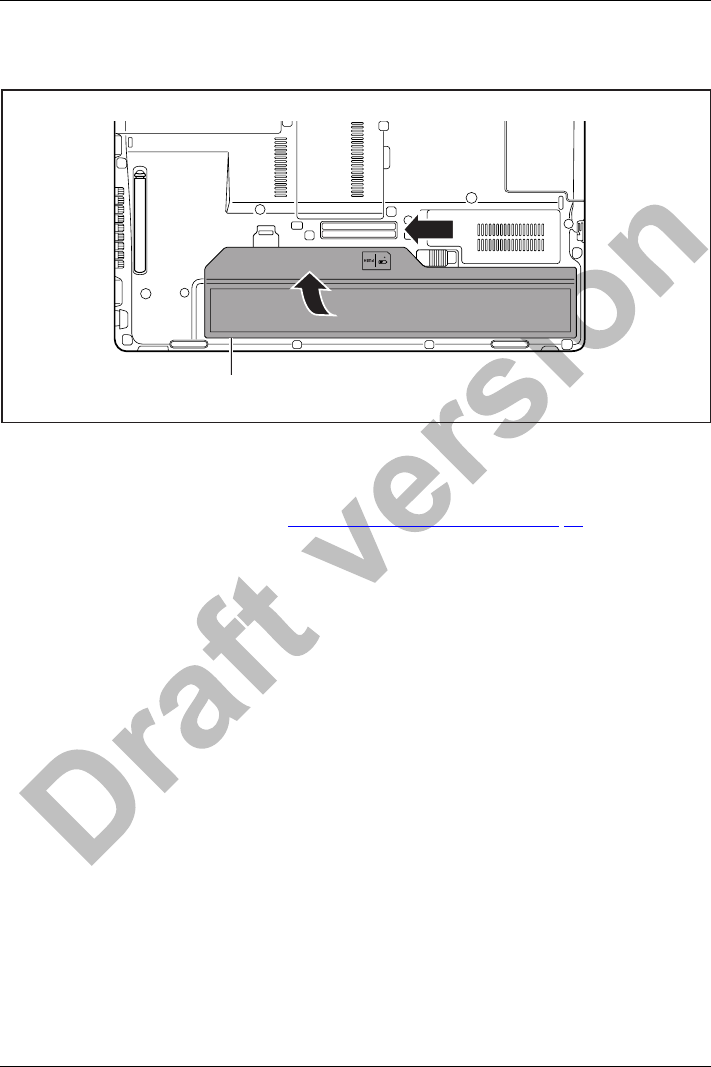
Working with the notebook
Inserting battery
2
3
1
►Place the battery on the lower edge of the battery compartment (1).
►Slide the battery into the battery compartment until you feel it engage (2).
►Slide the release button into its locked position (3).
►Complete the removal, see chapter "Finishing component removal", Page 89.
Fujitsu 47
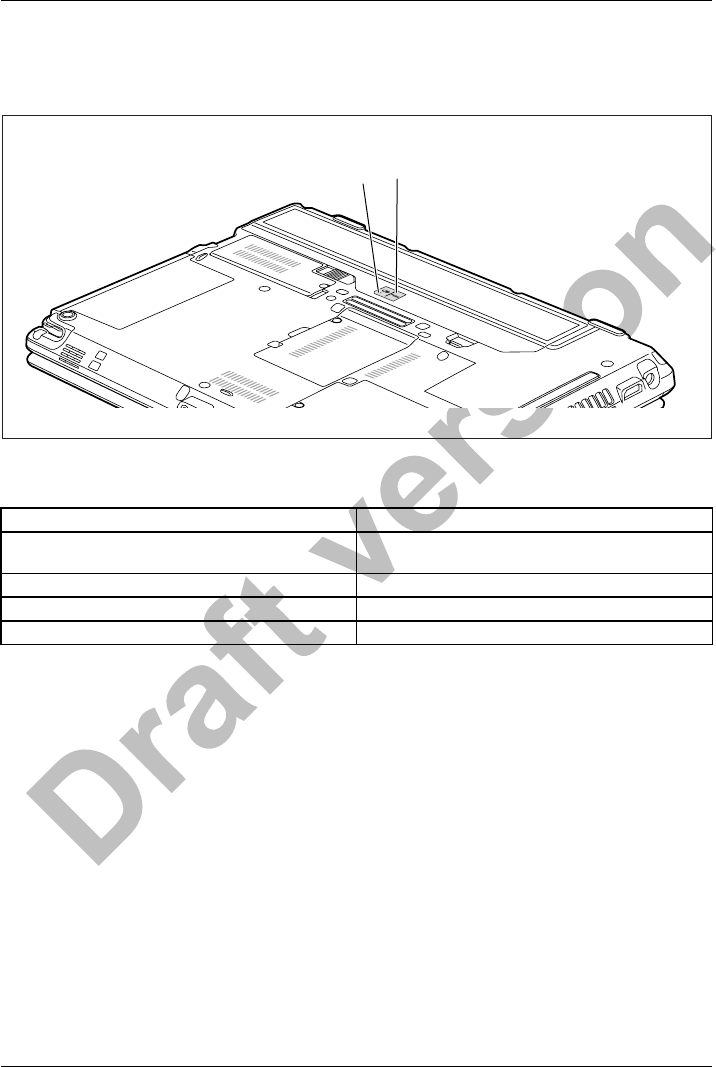
Working with the notebook
Batterychargestatusindicator
You can check the charge status directly on the battery itself.
11
a
►Press the key (1).
The LED (a) lights up in one of the following colours:
LED indicator State of charge
Green The battery is between 50 % and 100 %
charged.
Orange The battery is between 11 % and 49 % charged.
Red The battery is between 1 % and 10 % charged.
LED not lit The battery is fully discharged.
48 Fujitsu
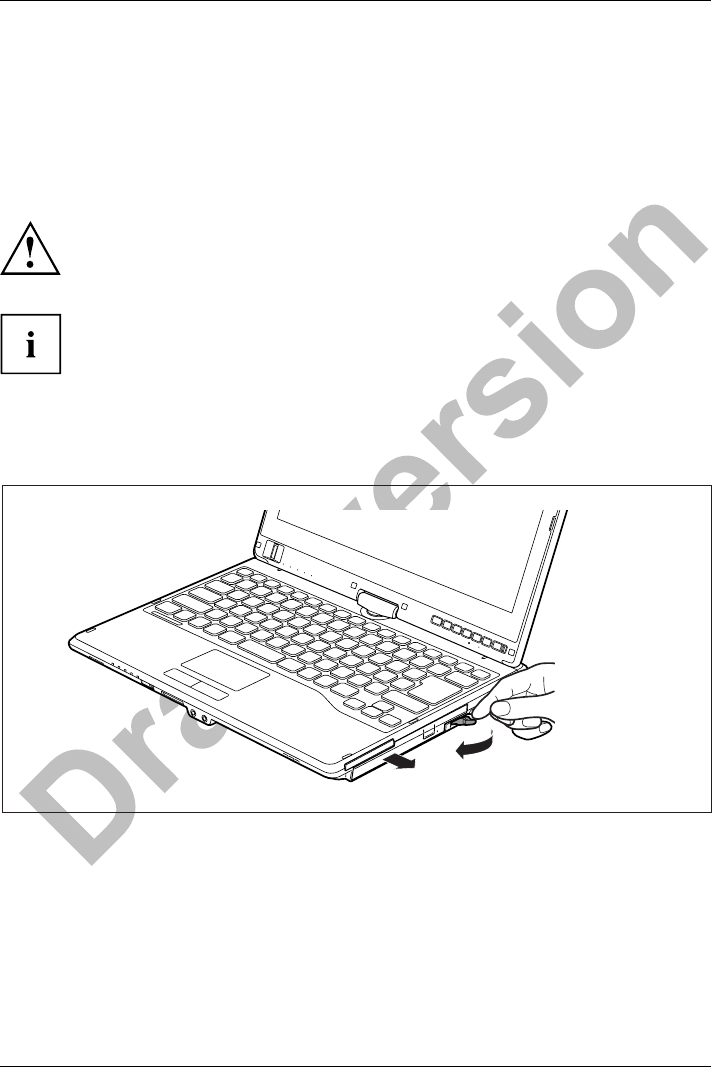
Working with the notebook
Module
ModulebayModules
The design of your notebook enables the flexible use of notebook batteries and drives. The
following modules can be operated in the module bay of your notebook:
• Second battery
• Optical drive
• Empty plug-in unit (save weight)
Only use modules designed for your notebook.
Do not use force when installing or removing the module.
Make sure that no foreign objects enter the module bay.
You can swap modules during operation. This means you do not
need to switch off the notebook.
To replace a module, simply click on the corresponding icon in the
task bar and then on Exit or Select - Exit.
The module can now be removed without any further actions being necessary.
Removing a module
1
2
ModuleDriveWeight Saver
►Slide the release lever in the direction of the arrow (1).
►Now pull the module out of the module bay (2).
Fujitsu 49
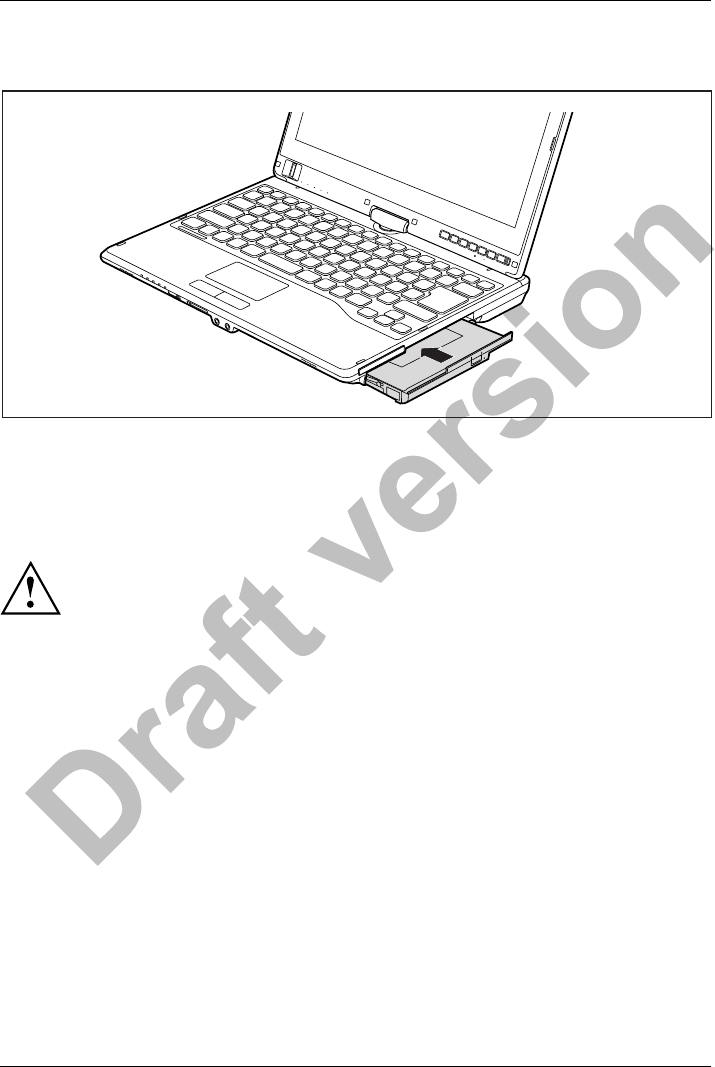
Working with the notebook
Installing a module
►Place the module into the module bay so that the contacts enter first.
►Push the module into the module bay until you feel it locking into place.
Optical drive
Opticaldrive
This product contains a light emitting diode, classification according to IEC 60825
1:2007: LASER CLASS 1, and must therefore not be opened.
Handling data carriers
Handling
Observe the following guidelines when handling data carriers:
• Avoid touching the surface of a data carrier. Only handle data carriers by their edges.
• Always store data carriers in their cases. This will protect the data carrier against
being covered in dust, scratched or damaged in any other way.
• Protect your data carriers against dust, mechanical vibrations and direct sunlight.
• Avoid storing a data carrier in areas subject to high temperatures or humidity.
You may use both 8-cm and 12-cm data carriers in the optical drive.
When using a data carrier of lesser quality, vibrations and reading errors may occur.
50 Fujitsu
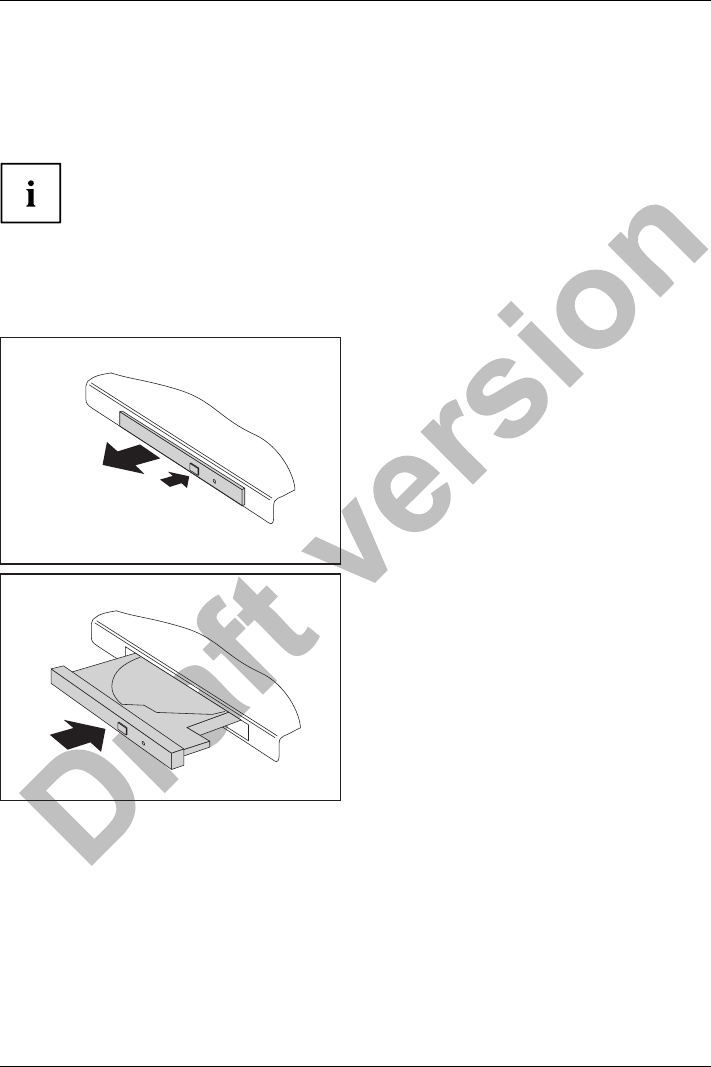
Working with the notebook
CD/DVD indicator
CD/DVDindicator
The CD/DVD indicator flashes when a data carrier is inserted. The indicator goes out when
the drive is ready for reading. The indicator lights up when the drive is being accessed.
You may only remove the data carrier when the indicator is unlit.
If the CD/DVD indicator does not go out after a data carrier has been inserted, but
instead continues to flash, this means that the drive cannot access the data carrier.
Either the data carrier is damaged or dirty or you are using a data
carrier that the drive cannot read.
Inserting or removing a data carrier
InsertingRemoving
The notebook must be switched on.
2
1
►Push the insert/eject button (1).
The drive tray will open.
►Gently pull the drive tray (2) completely out.
►Place the data carrier in the drive tray with
the printed side facing upwards.
or
►Remove a data carrier that has
been inserted.
►Push in the drive tray until you
feel it lock into place.
Fujitsu 51
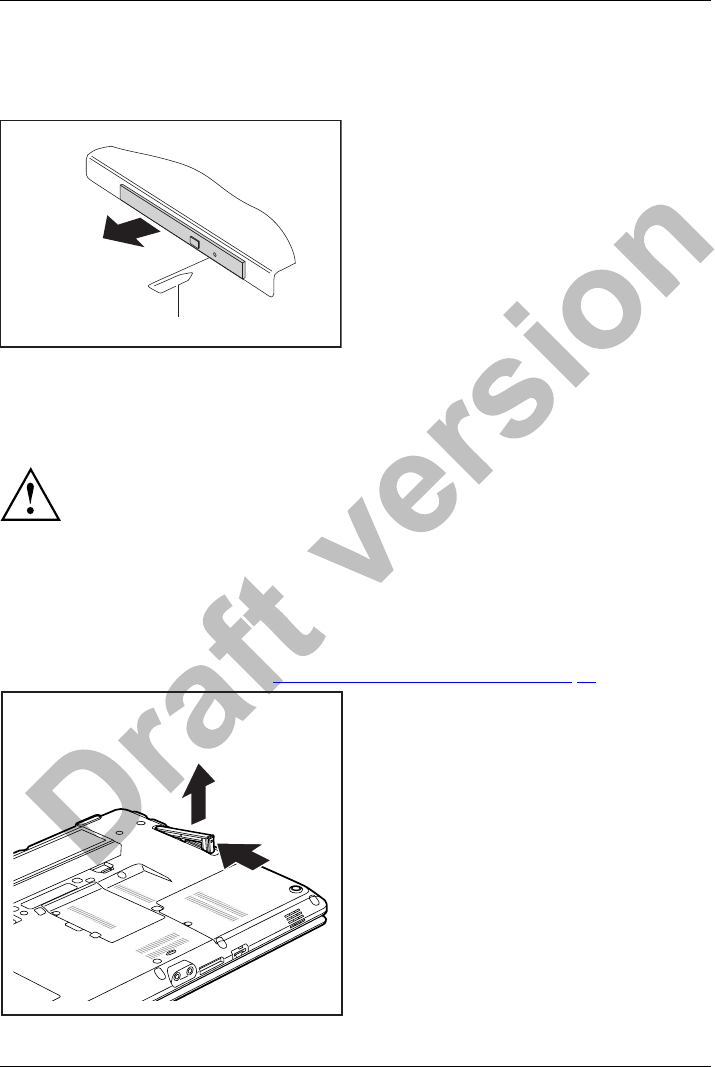
Working with the notebook
Manual removal (emergency removal)
CD/DVD:ManualremovalofdatacarrierEmergencyrem ovalofdata carrier
In the event of a power failure or damage to the drive, you can remove the data carrier manually.
1
2
►Switch your notebook off.
►Push a pen or a piece of wire (such as a
paperclip) firmly into the opening (1).
The drive tray is ejected. You can now pull
the drive tray (2) out of the drive.
Removing and fitting the dust removal cover
(ventilation slot cover)
In order to ensure optimum cooling of the components in your notebook, you
should periodically clean the ventilation slot of the heatsink.
This ensures optimum fan performance. You can achieve the best cleaning
results with a small hand-held vacuum cleaner.
If necessary, you can also use a dry brush to release dust from the ventilation slots.
Do not use any cleaning liquids! Ensure that no liquid enters the device.
To avoid overheating of the device, do not remove the ventilation slot
cover when the device is switched on.
►Prepare for removal, see chapter "Preparing to remove components", Page 83.
1
2
►Press and hold the lock of the ventilation
slot cover (1) and remove it from its slot (2).
►Clean the dust chamber.
52 Fujitsu
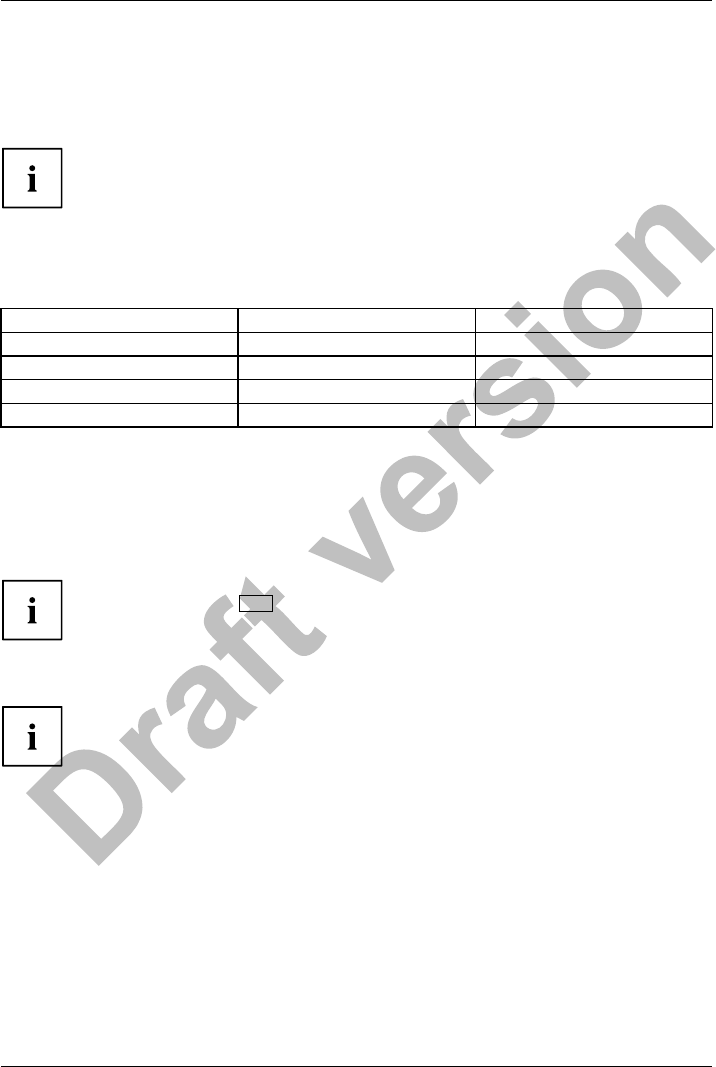
Working with the notebook
Using the power-management features
PowerPowerBattery
The notebook uses less power when the available power-management features are used. You
will then be able to work longer when using the battery before having to recharge it.
Power efficiency is increased and environmental pollution reduced. By
choosing the best power options, you can make significant savings and
at the same time help protect the environment.
When you close the LCD screen, depending on the setting in Windows, the
notebook automatically enters a power saving mode.
We recommend the following settings:
Function On external power On battery power
Turn off monitor After 10 minutes After 5 minutes
Turn off hard disk(s) After 15 minutes After 10 minutes
Energy saving (S3) After 20 minutes After 15 minutes
Hibernate mode (S4) After 1 hour After 30 minutes
►Select the power management functions in your Control Panel.
►Select the Screen Saver in your Control Panel.
or
►Right-click on the desktop. Switch on the screen saver by clicking Personalization –
Change screen saver.
If you need further information about an option, you can get help with most
settings by pressing F1 to open the Microsoft Help.
When the notebook is in power-saving mode, the following must be remembered:
During power saving mode, open files are held in the main memory
orinaswapfile on the hard disk.
Never turn off your notebook while it is in a power saving mode. If the built-in battery is
nearly empty, close the open files and do not go into power saving mode.
If you do not intend to use your notebook for a long period of time:
►Exit power saving mode if necessary via the mouse or keyboard or by switching on the
notebook.
►Close all opened programs and completely shut down the notebook.
54 Fujitsu
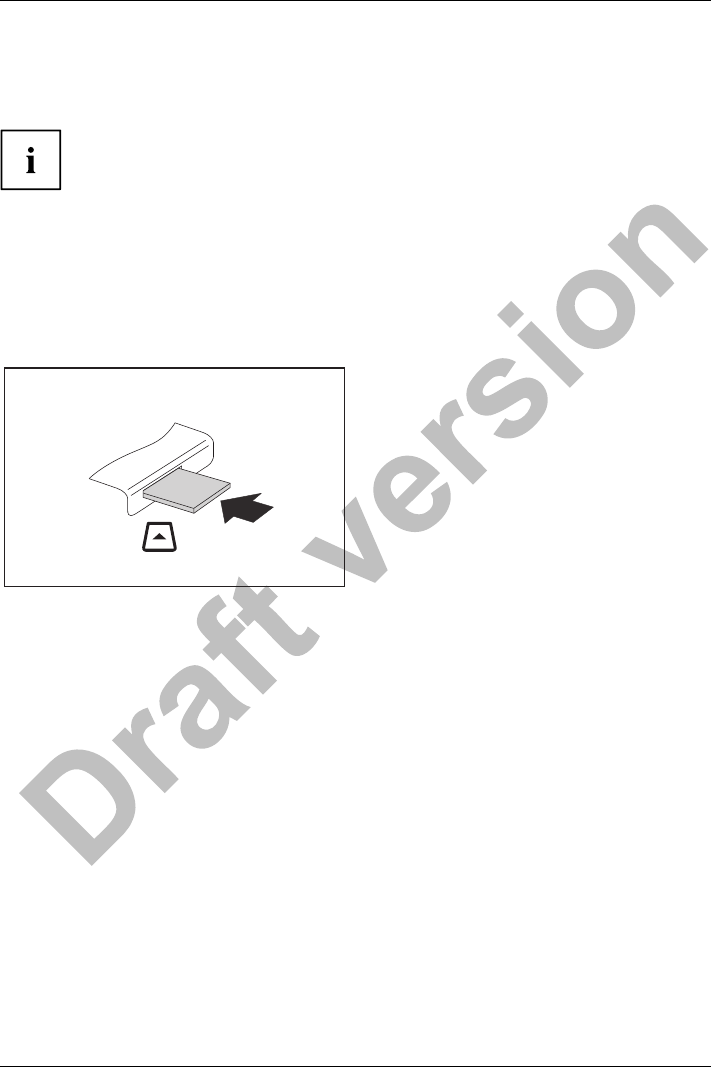
Working with the notebook
Memory cards
Slot
Your notebook is equipped with an integrated memory card reader.
Observe the manufacturer’s instructions when handling the memory cards.
Memorycard
Supported format
The memory card reader supports the following format:
• Secure Digital (SDTM card)
Inserting the memory card
►Carefully slide the memory card into the
slot. The label should be facing upward. Do
not apply excessive force, as otherwise the
delicate contact surfaces could be damaged.
Memorycard
Depending on the particular type
used, the memory card may protrude
slightly from the slot.
Fujitsu 55
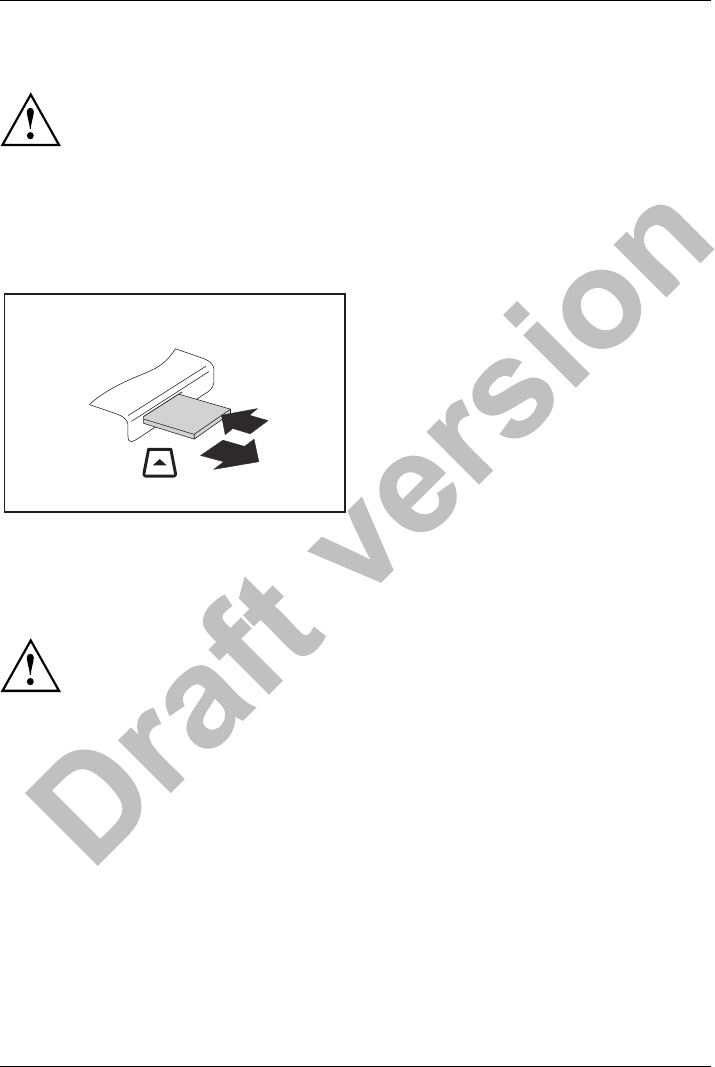
Working with the notebook
Removing the memory card
Memorycard
In order to protect your data, always follow the correct procedure
for removing the card outlined below.
You can stop the memory card via the corresponding icon in the task bar:
►Left-click on the icon.
►Select the card you want to stop and remove.
►Press the Enter key.
Wait for the dialogue box which tells you that it is now safe to remove the memory card.
1
2
►On devices with card locking: Press
on the storage card (1).
Memorycard
The storage card is released and
can now be removed.
►Pull the storage card out of the slot (2).
ExpressCards
SlotExpressCar d
AnExpressCardslotallowsanExpressCard/54tobeusedwiththecomputer.
Consult the documentation supplied by the ExpressCard’s manufacturer
and follow the instructions provided.
Never use force when installing or removing an ExpressCard.
Make sure that no foreign objects enter the ExpressCard slot.
56 Fujitsu
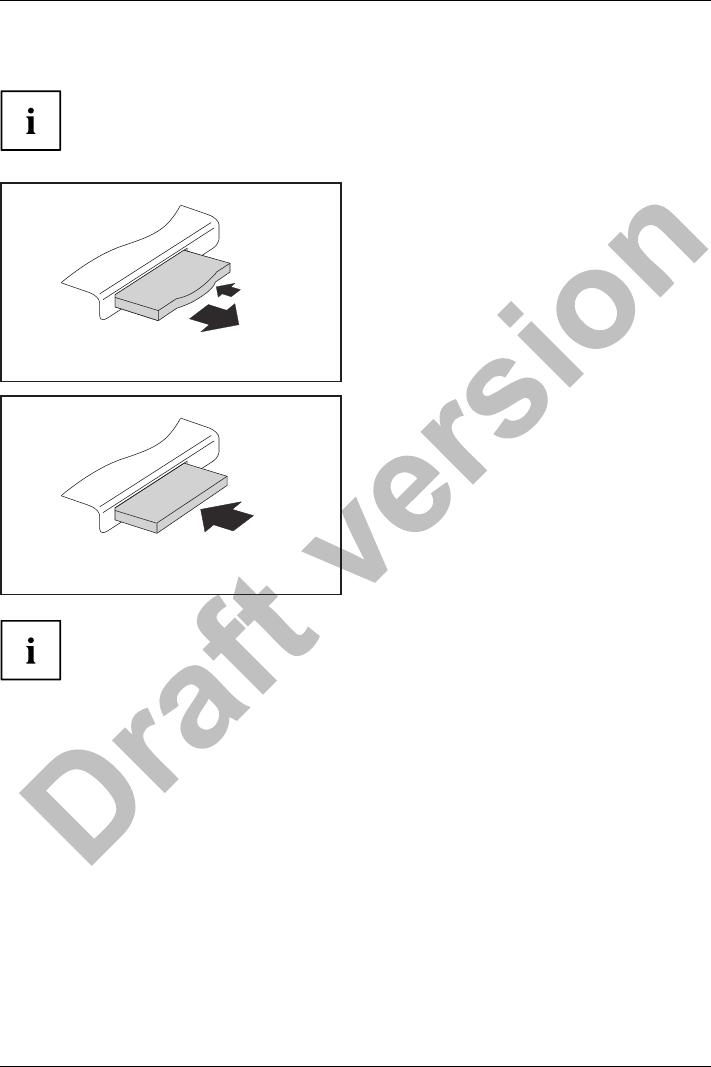
Working with the notebook
Inserting the card
Keep the placeholder for the slot in a safe place. When you remove the card again, you
must reinstall the place holder. This prevents foreign objects from getting into the slot.
1
2
►Press the edge of the placeholder (1)
to make the card placeholder protrude
from the notebook’s case.
►Pull the card placeholder out of the slot (2).
►Insert the card into the slot guide with
the connection contacts first.
►Gently push the card into the slot until you
feel it click into place. Do not use any force.
Depending on the particular type used, the
card may protrude slightly from the slot.
Please see the documentation relating to the card for driver installation instructions.
Fujitsu 57
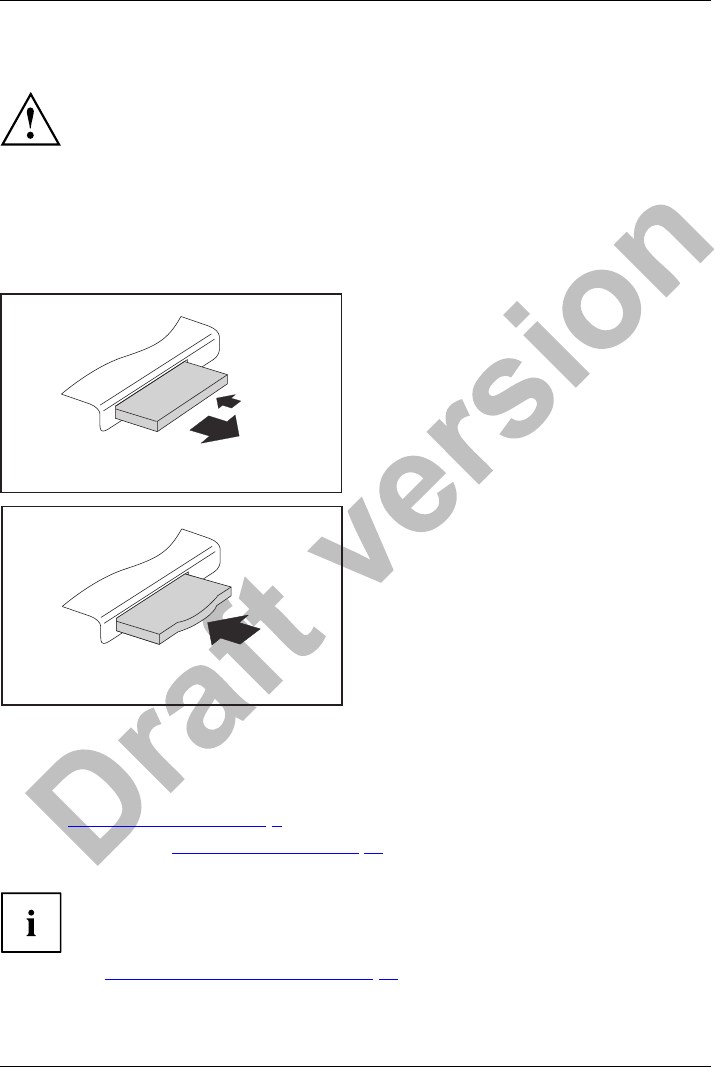
Working with the notebook
Removing the card
Always remove the card according to the rules described below, to
ensure that none of your data is lost.
You can stop the ExpressCard using the corresponding symbol in the task bar:
►Click on the symbol for safe removal of hardware with the left mouse button.
►Select the ExpressCard you want to stop and remove.
►Press the Enter key.
Wait for the dialogue box which tells you that it is now safe to remove the ExpressCard.
1
2
►Press the edge of the card (1) so that the
card protrudes a little from the notebook.
►Pull the card out of the slot (2).
2
►Insert the card placeholder into the
slot guide.
►Gently slide the card placeholder into the
slot until you feel it click into place.
Loudspeakers and microphones
Microphone
Loudspeakers
Bassloudspeak er(subwoofer)
Volume control
Information on the exact position of the speakers and microphone can be
found in "Ports and controls", Page 9.
Please refer to chapter "Key combinations", Page 40 for information on setting the volume
and also enabling/disabling the loudspeakers using key combinations.
If you attach an external microphone, the built-in microphone is disabled.
When you connect headphones or external speakers, the built-in speakers are disabled.
Information on connecting headphones and a microphone can be found
in "Connecting external devices", Page 75.
58 Fujitsu
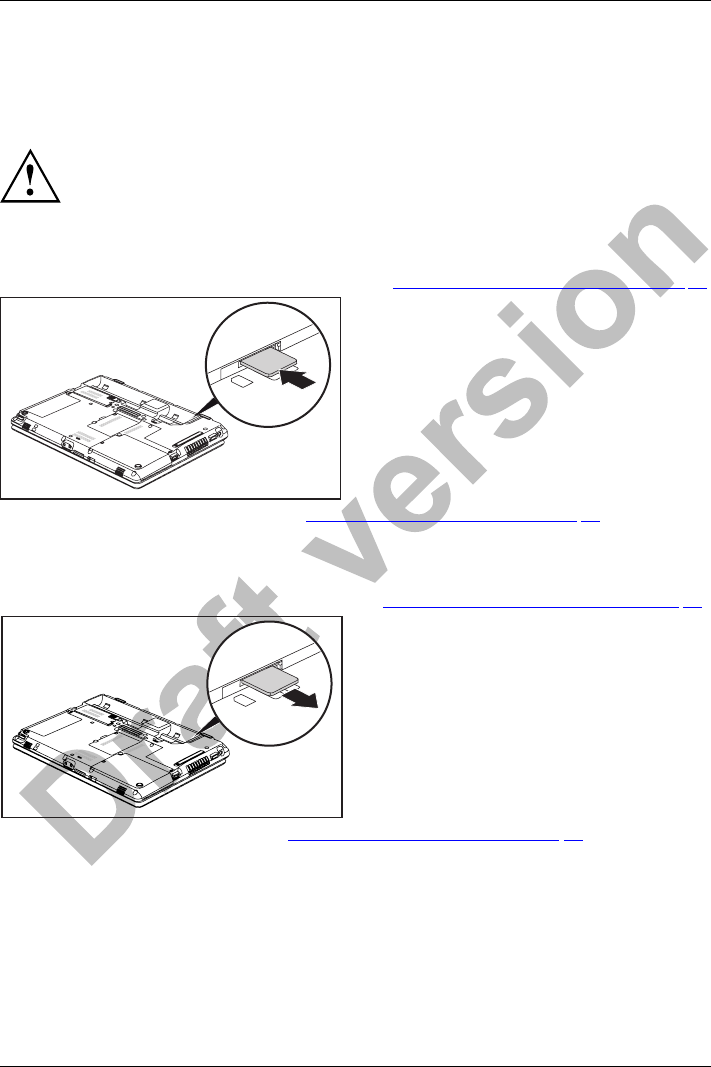
Working with the notebook
SIM card
A SIM card (Subscriber Identity Module) is a chip card which is inserted in a mobile phone or
notebook and, together with an integrated UMTS/LTE module, enables access to a mobile network.
When handling SIM cards, follow the instructions supplied by the provider.
Inserting the SIM card
►Prepare for installation of the SIM card, see chapter "Preparing to remove components", Page 83.
1
►Slide the SIM card into the slot (1)
until it is felt to engage, as shown in
the battery compartment.
►Complete the installation, see chapter "Finishing component removal", Page 89.
Removing the SIM card
►Prepare for removal of the SIM card, see chapter "Preparing to remove components", Page 83.
1
►Press on the edge of the SIM card so that
it jumps up slightly out of the slot.
►Pull the SIM card out of the slot in the
direction of the arrow (1).
►Complete the removal, see chapter "Finishing component removal", Page 89.
Fujitsu 59
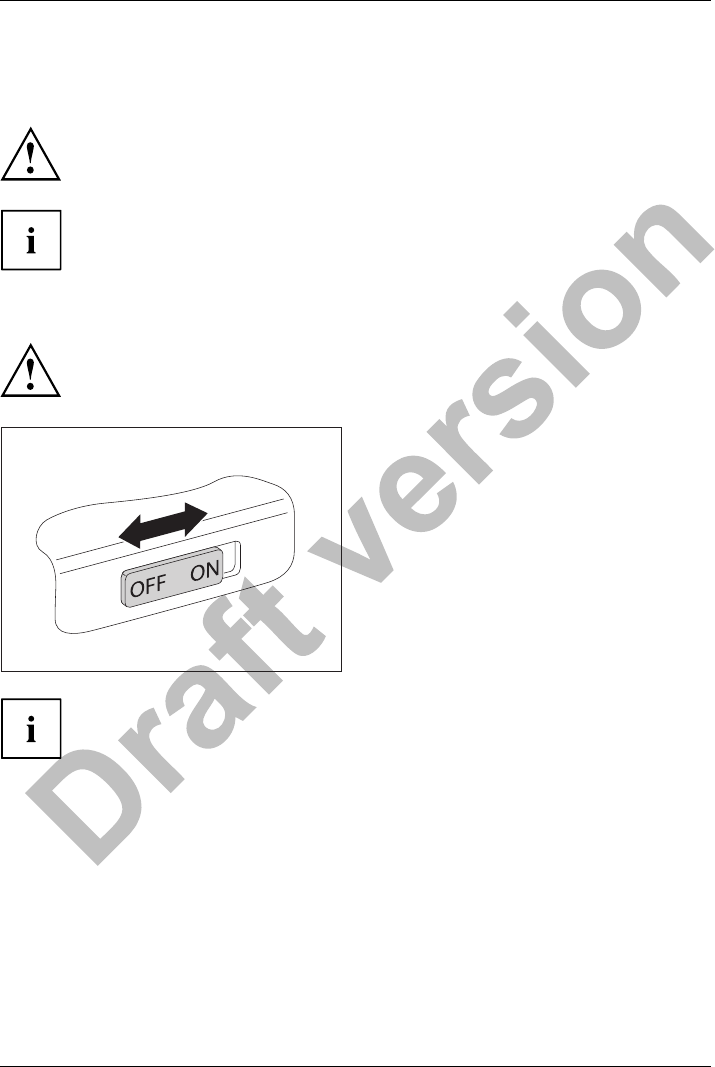
Working with the notebook
Optional Wireless LAN / Bluetooth / UMTS /
LTE wireless components
The installation of radio components not approved by Fujitsu Technology Solutions
will invalidate the certifications issued for this device.
Depending on the device configuration you ordered, your device will be equipped
with Wireless LAN, Bluetooth and/or UMTS / LTE.
Switching the wireless components on and off
Before switching on your device for the first time, the on/off switch for
radio components must be in the "ON" position.
►Slide the ON/OFF switch into the "ON"
position to activate the radio components.
WirelessLA NWirelessLANBlueto othBlue tooth
or
►Slide the ON/OFF switch to the
"OFF" position to deactivate the
radio components.
If you switch off the radio components, the wireless LAN antenna and, when present,
the Bluetooth module and UMTS/LTE module will be switched off.
You can use the PlugfreeNetwork program to switch the installed radio
components on and off individually.
You can also deactivate the wireless components individually in the BIOS Setup.
For this to occur, you must either not have assigned a supervisor password or if a
supervisor password has been assigned, you must know this password.
Pay attention to the additional safety notes for devices with radio components
provided in the "Safety/Regulations" manual.
Details on using Wireless LAN can be found in the online help system
included in the Wireless LAN software.
You can find more information on how to use Bluetooth on the CD you
received with your Bluetooth software.
You can obtain more information on UMTS/LTE from your service provider.
60 Fujitsu

Working with the notebook
Setting up WLAN access
• Requirement: A WLAN must be available and you must have the
corresponding access information.
Information on configuring the WLAN access can be found in the
documentation for your operating system.
Access via UMTS / LTE
If you ordered an integrated UMTS / LTE module with your system, you can enjoy optimum
reception and maximum energy efficiency without awkward cables or antennas. The
optional UMTS / LTE module is ready for use straight away.
If you did not order a UMTS / LTE module, you can purchase the accessories for UMTS /
LTE reception from your retailer or your Fujitsu Technology Solutions dealer.
You will find information on establishing the connection with the UMTS / LTE network
in the documentation for the hardware used.
Your device can connect to the Internet via UMTS / LTE. To do this, use one
of the following types of connection:
• Integrated UMTS / LTE module (availability dependent on your model variant)
• a USB dongle (a USB stick with your mobile phone provider’s SIM card)
• a mobile end-device (e.g. mobile phone with Bluetooth or cable connection)
• UMTS ExpressCard (fits into the ExpressCard slot on your device)
UMTS/LTE antenna
1
►To improve the signal strength of the
UMTS/LTE, fold out the UMTS/LTE antenna
in the direction of the arrow (1).
UMTSUMTS
Fujitsu 61
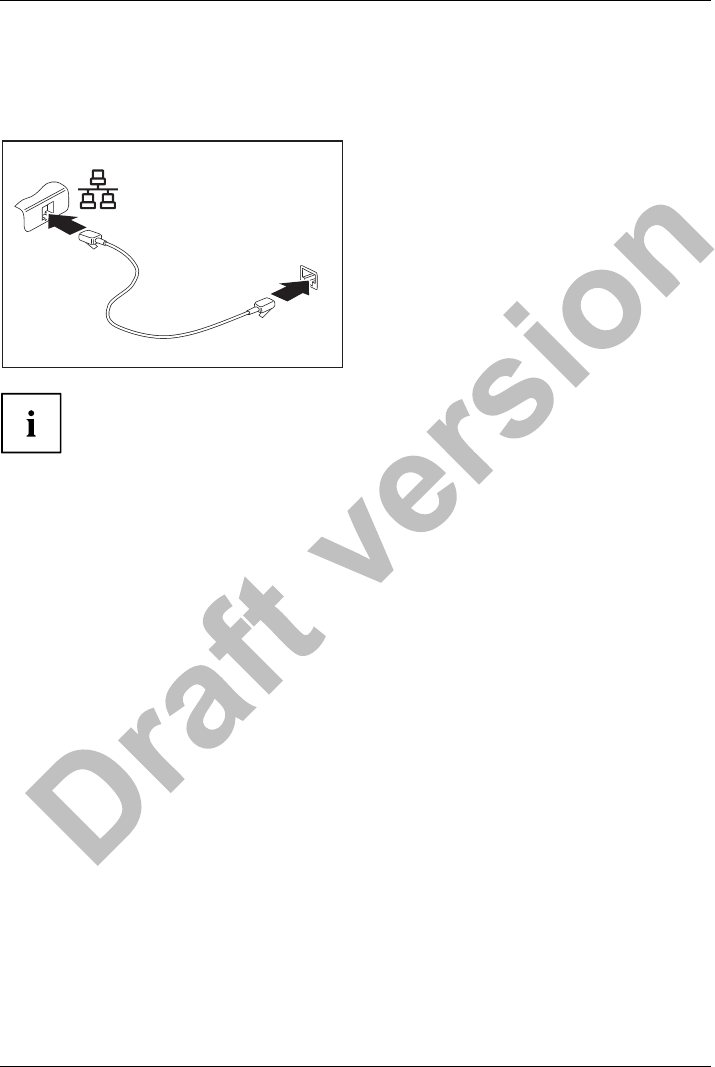
Working with the notebook
Ethernet and LAN
EthernetLAN
The internal network module of your notebook supports Ethernet LAN. You can use it to
establish a connection to a local network (LAN = Local Area Network).
2
1
►Connect the network cable to the LAN
port of the notebook (1).
►Connect the network cable to your
network connection (2).
Your network administrator can help you to configure and use the LAN connections.
The network cable is not included in the delivery scope. This type of
cable can be obtained from a specialist dealer.
Your Port Replicator (optional)
Your Port Replicator is a device that enables you to quickly connect your notebook
to your peripherals, such as a monitor, printer etc.
The features offered by the Port Replicator include standard ports for
monitor, audio, mouse and keyboard.
You need only dock the notebook in order to use your peripheral devices.
62 Fujitsu
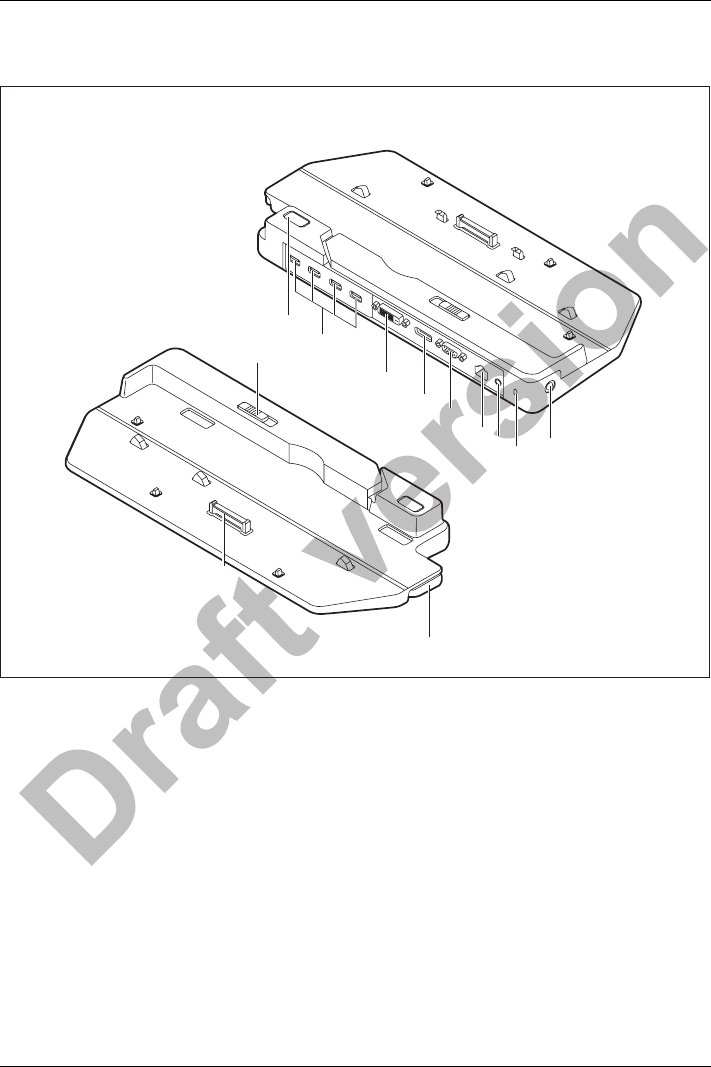
Working with the notebook
Ports on the Port Replicator
PortReplicatorPorts
1
12
2
3
45678
10
11
9
1 = ON/OFF switch
2 = USB ports (USB 3.0)
3=DVIport
4 = DisplayPort
5 = VGA monitor port
6 = LAN port
7 = Headphone port
8 = Security Lock device
9 = DC input connector (DC IN)
10 = Adjusting lever of the Port Replicator
11 = Unlocking lever
12 = Connector on the Port Replicator for the
docking port on the bottom of the notebook
Fujitsu 63

Working with the notebook
Setting up the port replicator
Select a suitable location for the port replicator before setting it up.
Follow the instructions below when doing so:
• Never place the port replicator on a soft surface (e.g. carpeting, upholstered furniture, bed).
This can block the air vents of the notebook and cause overheating and damage.
• Place the port replicator on a stable, flat and non-slip surface. Please note that the
port replicator’s rubber feet may mark certain types of surface.
• Never place the port replicator and the mains adapter on a heat-sensitive surface.
• Do not expose the port replicator to extreme environmental conditions.
Protect the port replicator from dust, humidity and heat.
Connect the notebook to the port replicator
The Port Replicator supports various LIFEBOOK models. The adjusting
lever of the Port Replicator can be used to adapt the Port Replicator
to the size of the particular LIFEBOOK.
Before connecting the notebook to the port replicator, check if the setting
lever of the port replicator is in the right position. If necessary, adjust
the setting lever to the correct position.
►Disconnect the mains adapter cable from the DC socket (DC IN) of the notebook.
64 Fujitsu

Working with the notebook
1
2
3
►Position the notebook on the port replicator in such a way that the docking connector on the
underside of the notebook is aligned with the docking connector of the port replicator as shown.
►Press down on the notebook’s rear corners so that it locks into position.
►Connect the mains adapter cable to the DC jack (DC IN) of the port replicator (1).
►Connect the power cable to the mains adapter (2).
►Plug the power cable into the mains socket (3).
Fujitsu 65

Working with the notebook
Switching on the notebook via the port replicator
►Press the ON/OFF switch on the port replicator to switch the notebook on.
Switching off notebook via Port Replicator
►Close all applications and shut down your operating system (please refer
to the manual for the operating system).
If the notebook cannot be shut down properly, press the ON/OFF button
on the Port Replicator for approx. four seconds. The notebook will switch
off. Any unsaved data may however be lost.
66 Fujitsu
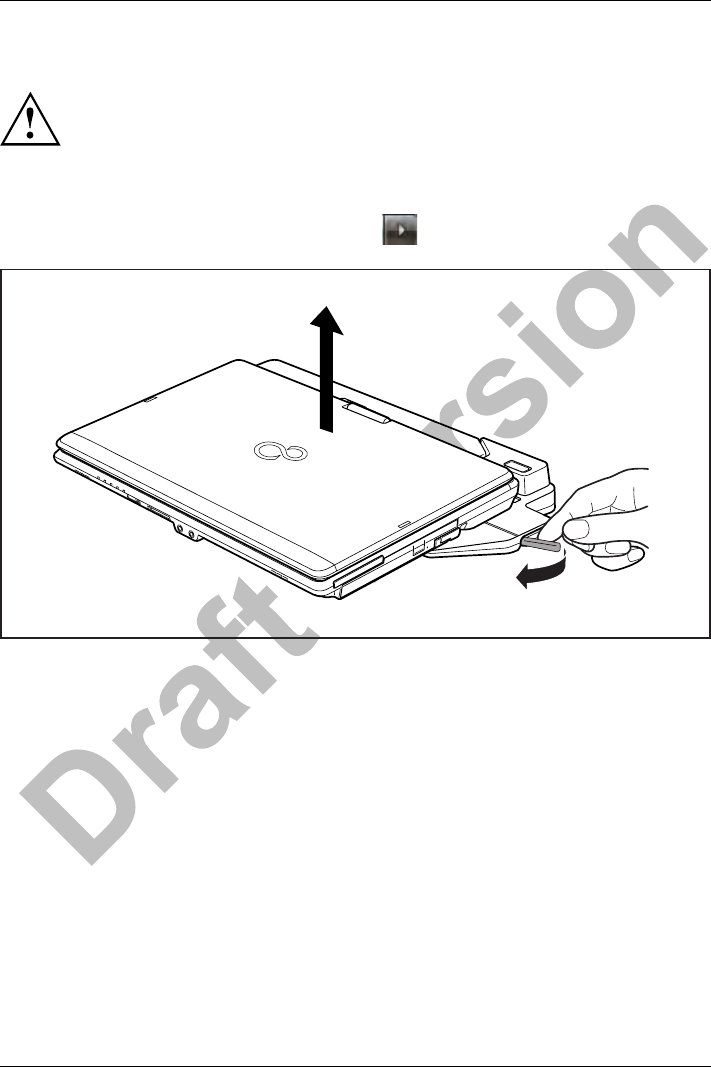
Working with the notebook
Disconnecting the notebook from the port replicator
Problems may occur if the notebook is removed from the port replicator
during operation. We recommend that you switch off the notebook beforehand
or use the Windows function Start – Undock.
Windows 7
Problems may occur if the notebook is removed from the port replicator during
operation. We recommend that you switch off the notebook beforehand or use
the Windows function Start (arrow icon) – Undock.
1
2
►Pull the release button in the direction of the arrow (1).
►Pick up the notebook (2).
Fujitsu 67

Security functions
Security functions
Securityfunctions
Your notebook has several security features that you can use to secure your
system from unauthorised access.
This chapter explains how to use each function, and what the benefits are.
Please remember that in some cases, for example, forgetting your password,
you may be locked out and unable to access your data. Therefore,
please note the following information:
• Make regular backups to external data carriers such as external hard
drives, CDs, DVDs or Blu-ray Discs.
• Some security functions need you to choose passwords. Make a note
of the passwords and keep them in a safe place.
If you forget your passwords you will need to contact the our Service
Desk. Deletion or resetting of passwords is not covered by your warranty
and a charge will be made for assistance.
Brief overview of security functions
Detailed information about the security equipment of your device can be found in
the "Professional Notebook" manual, on the "Drivers & Utilities" CD/DVD or on
the Internet at "http://www.fujitsu.com/fts/support/index.html".
Security functions Type of protection Preparation
Security Lock Mechanical Fit and lock the Kensington
Lock Cable (accessory).
Fingerprint sensor (depending
on the device) Biometric Install the supplied fingerprint
software.
BIOS password protection Password protection for BIOS
Setup, operating system and
hard disk with supervisor and
user password. The passwords
consist of a maximum of eight
alphanumeric characters.
Specify at least one supervisor
password in the BIOS Setup
and activate the password
protection for the operating
system and hard disk as
desired.
Boot from removable media Prevents unauthorised booting
of an operating system from
external media (e.g. USB stick,
USB CD-ROM drive etc.).
In the BIOS Setup, go to the
Security menu and edit the
option Boot from Removable
Media.
Owner Information Overlay service desk or owner
information during the boot
process.
In the BIOS Setup, go to the
Security menu and edit the
option Owner Information.
Trusted Platform Module
(device dependent) Identification and authentication
of the notebook Define a supervisor password
in the BIOS Setup and enable
the TPM (Security Chip).
68 Fujitsu
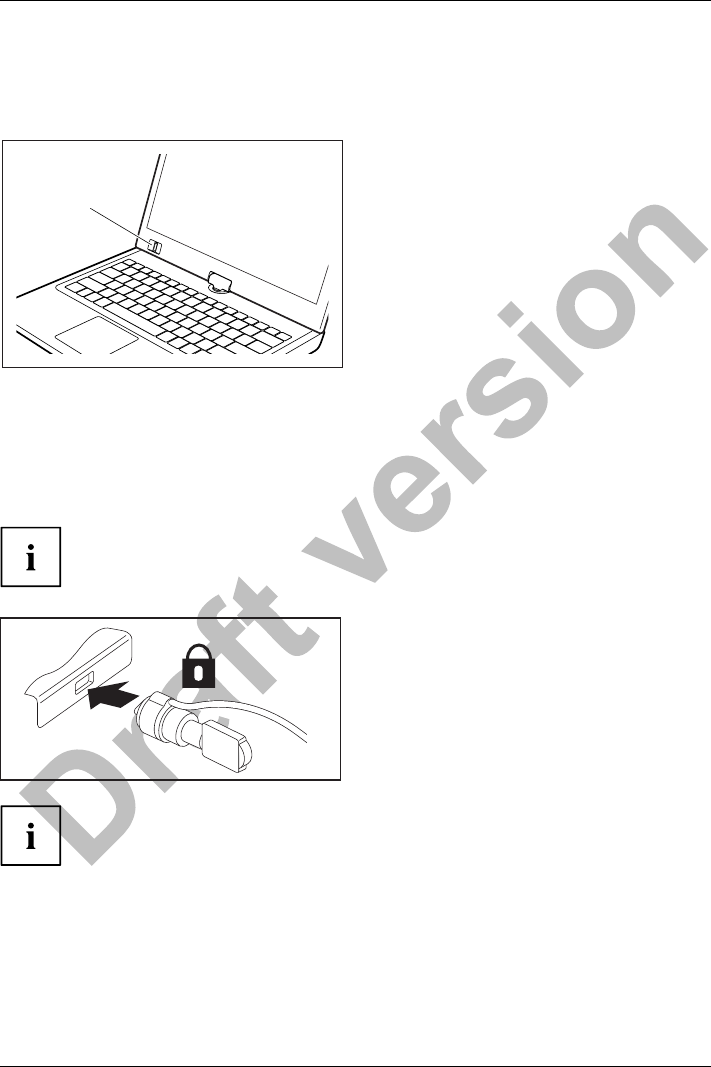
Security functions
Configuring the fingerprint sensor
Fingerprintsens orFingerprintsens or
The fingerprint sensor can record an image of a fingerprint. With additional fingerprint
software, this image can be processed and used instead of a password.
1
►You must install the fingerprint software
in order to be able to use the
fingerprint sensor (1).
Using the Security Lock
Your device comes with a Security Lock device for the Kensington Lock Cable. You can
use the Kensington Lock Cable, a sturdy steel cable, to help protect your notebook from
theft. The Kensington Lock Cable is available as an accessory.
Fujitsu Technology Solutions recommends the use of a combination lock.
►Fit the Kensington Lock Cable on the
device on your notebook.
UsingtheKensingtonLockCableSecurity LockMechanicalback upAnti-theftprotection
Attach another Kensington Lock Cable to your Port Replicator to protect
your Port Replicator from theft as well.
Fujitsu 69
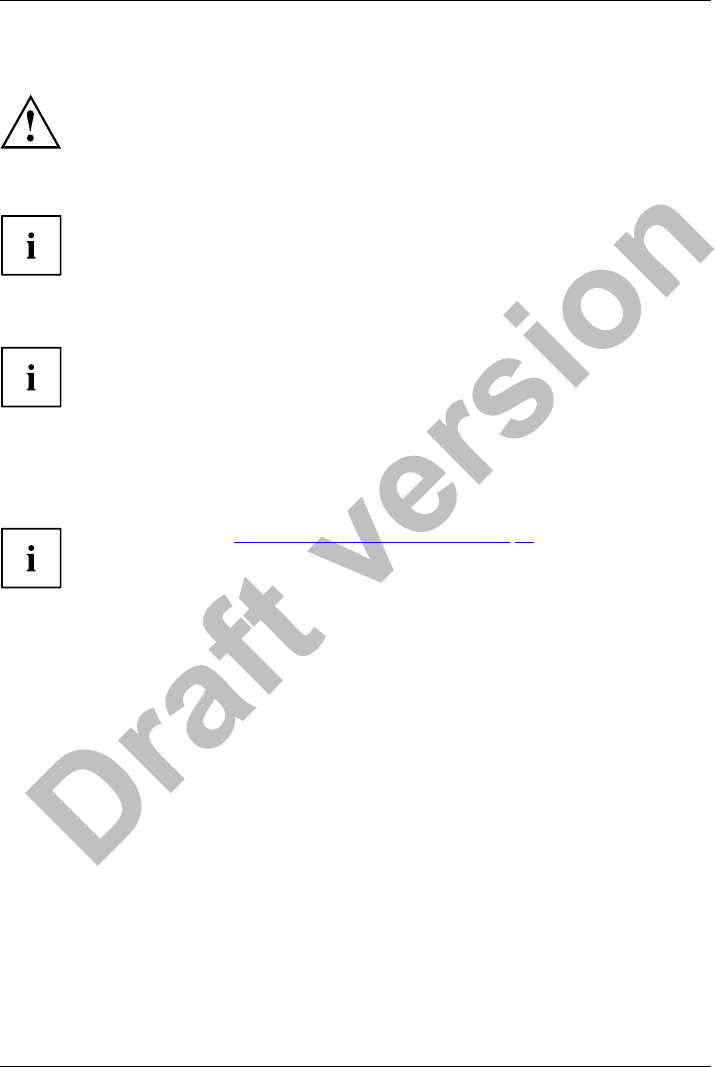
Security functions
Configuring password protection in BIOS Setup Utility
Before using the various options for password protection in the BIOS Setup utility
to increase data security, please observe the following:
Make a note of the passwords and keep them in a safe place. If you forget your
supervisor password you will not be able to access your notebook. Passwords are
not covered by your warranty and a charge will be made for assistance.
Password protection
Your password can be up to eight characters long and contain letters and numbers.
No distinction is made between uppercase and lowercase.
Protecting BIOS Setup Utility (supervisor and user password)
If you have opened these operating instructions on the screen, we recommend that
you print out the following instructions. Because you cannot call the instructions
onto the screen while you are setting up the password.
BIOSSetupUtility
You prevent unauthorised use of the BIOS Setup Utility with both the supervisor and the user
password. The supervisor password gives you access to all functions of the BIOS Setup
Utility, while the user password only provides some of the functions. You can only set a
user password if a supervisor password has already been assigned.
Please refer to the ""Settings in BIOS Setup Utility", Page 90 section for a
description of how to call up and operate the BIOS Setup Utility.
Setting supervisor and user password
►Start the BIOS Setup Utility and go to the Security menu.
►Select the Set Supervisor Password field and press the Enter key.
With Enter new Password: you are asked to enter a password.
►Enter the password and press the Enter key.
Confirm new Password requires you to confirm the password.
►Enter the password again and press the Enter key.
Changes have been saved is a confirmation that the new password has been saved.
►To set the user password, select Set User Password and proceed exactly as
when configuring the supervisor password.
If you do not want to change any other settings, you can exit BIOS Setup Utility.
►In the Exit menu, select the option Save Changes & Exit.
►Select Yes and press the Enter key.
PasswordSupervisor passwordUserpassword
The notebook will be rebooted and the new password will come into effect. It will now be
necessary to first enter your supervisor or user password in order to open the BIOS Setup Utility.
Please note that the user password only provides access to a few of the BIOS settings.
70 Fujitsu

Security functions
Changing the supervisor or user password
You can only change the supervisor password when you have logged into the
BIOS Setup Utility with the supervisor password.
PasswordSupervisorpasswordUserpassword
►Call the BIOS Setup Utility and go to the Security menu.
►When changing the password, proceed exactly as for password assignment.
Removing passwords
To remove a password (without setting a new password) perform the following steps:
PasswordSupervisorpasswordUserpassword
►Start the BIOS Setup Utility and go to the Security menu.
►Highlight the Set Supervisor Password or Set User Password field and press the Enter key.
You will be requested to enter the current password by the Enter Current Password prompt.
You will be requested to enter a new password by the Enter New Password prompt.
►Press the Enter key twice.
►In the Exit menu, select the option Save Changes & Exit.
►Select Yes and press the Enter key.
The notebook will now reboot with the password removed.
Removing the supervisor password simultaneously deactivates the user password.
Password protection for booting of the operating system
With the supervisor password you have set in the BIOS Setup Utility (see
section "Setting supervisor and user password", Page 70), you can also
prevent booting of the operating system.
Operating system
Activating system protection
►Start the BIOS Setup Utility and go to the Security menu.
Operatingsystem
►Select the PasswordonBootoption and press the Enter key.
►Select the desired option (Disabled,First Boot or Every Boot) and press the Enter key
►Select the Save Changes & Exit option under Exit.
The notebook will reboot. You will be prompted to enter your password (the supervisor password).
Deactivating system protection
►Start the BIOS Setup Utility and go to the Security menu.
Operatingsystem
►Select the PasswordonBootoption and press the Enter key.
►Select the Disabled option and press the Enter key.
If you do not want to change any other settings, you can exit BIOS Setup Utility.
►Select the Save Changes & Exit option under Exit.
The notebook will reboot. The system is no longer password-protected.
Fujitsu 71

Security functions
Password protection for the hard disk
Passwordprotect ion:
The had disk password prevents unauthorised access to the hard disk drives
and is checked internally each time the system is booted. The condition for this
is that you have assigned at least the supervisor password.
Activating hard disk protection
►Call up the BIOS Setup and select the Security menu.
If you have not assigned BIOS passwords yet, define the supervisor and the user
password now, if desired (see "Security functions", Page 68).
►Mark the Hard Disk Security field and press the Enter key.
►In the Drive0 area mark the Set Master Password field and press the Enter key.
Enter new Password then appears and you are asked to enter a password.
►Enter the password and press the Enter key.
Confirm new Password requires you to confirm the password.
►Enter the password again and press the Enter key.
Setup Notice: Changes have been saved is displayed to confirm that the
new password has been saved.
►To assign the password for the second hard disk (Drive1), go to the Drive1 area and
select the field Set Master Password, then proceed in exactly the same way as for
setting up the password for the first hard disk (Drive0).
The field Password Entry on Boot is set to Enabled by default. You can exit the BIOS
Setup once you have finished changing the settings.
►From the Exit menu, choose the option Exit Saving Changes.
►Press the Enter key and select Yes.
The notebook reboots and your hard disk is now protected with a password. The system
will ask you to enter the password when the notebook is restarted again.
Deactivating hard disk protection
To cancel a password without setting a new one, proceed as follows:
►Call up the BIOS Setup and select the Security menu.
►Mark the Hard Disk Security field and press the Enter key.
►In the Drive0 area mark the Set Master Password field and press the Enter key.
You will be initially requested to enter the old password by the Enter current Password prompt.
You will then be requested to enter a new password by the Enter new Password prompt.
►After entering the password, press the Enter key three times.
►From the Exit menu, choose the option Exit Saving Changes.
►Press the Enter key and select Yes.
The notebook reboots, and password protection for the hard disk is cancelled.
►To cancel the password for the second hard disk (Drive1), go to the Drive1 area
and select the field Set Master Password, then proceed in exactly the same way as
for cancelling the password for the first hard disk (Drive0).
72 Fujitsu

Security functions
Using the security function of the tablet keys
If you have allotted a supervisor and/or user password in the form of tablet key combinations as
described below, you can use the tablet keys to enter this when you start your device.
Setting the Supervisor password
►Select Start - Run.
►Enter the following at the command line: C:\Program Files\Fujitsu\Security
Panel Application\Supervisor\FJSECS.EXE.
►Confirm with Enter .
►Follow the instructions on the screen.
Setting the User password
►Select Start - All Programs.
►Select Security Panel Application – Security Panel Application.
►Follow the instructions on the screen.
Entering passwords using the tablet buttons
The passwords to be entered via the tablet buttons are usually composed of a combination of
button presses, e.g. button 2+ button 3followed by button 1and the ENT button.
►Enter your password using the buttons 1to 4.
►Confirm by pressing ENT .
The device will be unlocked.
Fujitsu 73

Security functions
Trusted Platform Module (TPM) (device-dependent)
TPMTrustedP latformModule
To use the TPM, you must activate the TPM in the BIOS Setup before the software
is installed. The condition for this is that you have assigned at least the supervisor
password (see "Security functions", Page 68).
Enabling TPM
• Requirement: You have assigned a supervisor password, see "Security functions", Page 68.
►Call up the BIOS Setup and select the Security menu.
►Mark the TPM Security Chip Setting field and press the Enter key.
►Select Enabled to activate the TPM.
Once you have activated the TPM the Clear Security Chip option appears.
Select Clear Security Chip to delete the holder in the TPM. By clicking on Enabled,
all secret keys (e.g. SRK - Storage Root Keys, AIK - Attestation Identity Keys
etc.) generated by applications are deleted.
Please note that you will then no longer be able to access the data you have
encrypted with the keys based on that holder.
►Select the Exit Saving Changes option in the Exit menu.
►Press the Enter key and select Yes.
The notebook will restart, and TPM will be enabled after the reboot.
Disabling TPM
• Requirement: You have assigned a supervisor password, see "Security functions", Page 68.
►Call up the BIOS Setup and select the Security menu.
►Mark the TPM Security Chip Setting field and press the Enter key.
►Select Disabled to deactivate the TPM.
►From the Exit menu, choose the option Exit Saving Changes.
►Press the Enter key and select Yes.
Your notebook will now restart and TPM will be disabled.
74 Fujitsu

Connecting external devices
Connecting external devices
Always refer to the safety information provided in "Important notes", Page 12 before
connecting or disconnecting any devices to or from your notebook.
Always read the documentation supplied with the device you wish to connect.
Never connect or disconnect cables during a thunderstorm.
Never pull at a cable when disconnecting it. Always grasp the plug.
Follow the steps below in order, when connecting or disconnecting
devices to your notebook:
With some devices such as USB devices, it is not necessary to switch off
the notebook and the device before connecting/disconnecting. For more
information about whether or not devices need to be switched off, please refer
to the documentation supplied with the external device.
Some of the external devices require special drivers (see the operating
system and external device documentation).
Connecting devices to the notebook
1. Turn off your notebook and all external devices.
2. Unplug your notebook and all devices from the mains sockets.
3. Connect the cables for your external devices following the instructions.
4. Plug all power cables into the mains sockets.
DevicesPeripher aldevices
Disconnecting devices from the notebook
1. Turn off your notebook and all external devices.
2. Unplug your notebook and all devices from the mains sockets.
3. Disconnect the cables for your external devices following the instructions.
DevicesPeripher aldevices
Fujitsu 75
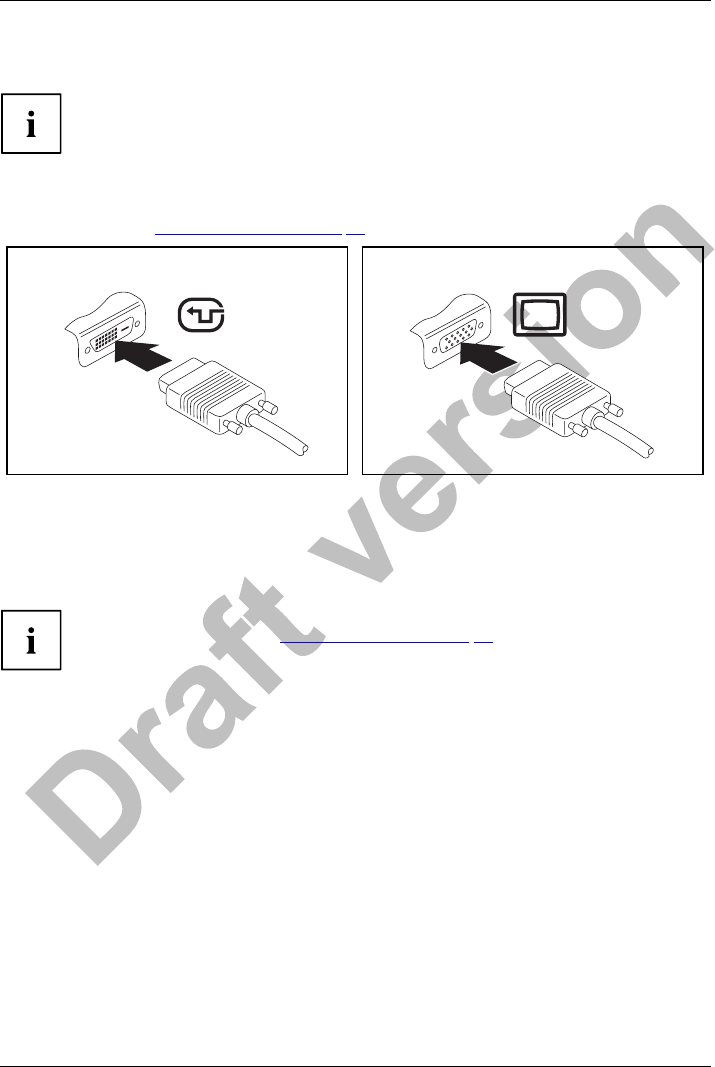
Connecting external devices
Connecting an external monitor
The Port Replicator, available as an option for your notebook, offers
you a DVI port and a DisplayPort.
An analogue monitor is connected to the analogue VGA monitor port, a digital monitor to the
DVI-I monitor port of the port replicator. Screen output is limited to a maximum of two screens
at any one time (see "Key combinations", Page 40, section "Toggle output screen").
MonitorVGAcon nectionsocketScreenportMonitorport
Digital DVI monitor port Analogue VGA monitor port
►Switch off the notebook and the external monitor.
►Plug the data cable of the external monitor into the monitor port.
►First switch on the external monitor and then the notebook.
You can also switch back and forth between the external monitor and the notebook’s
LCD monitor, see chapter "Key combinations", Page 40.
You can display the same picture on the external monitor and the
notebook LCD screen simultaneously.
76 Fujitsu

Connecting external devices
Connecting an external monitor to the DisplayPort
It is possible to connect a digital monitor to the DisplayPort on the port replicator.
Screen output is limited to a maximum of two screens at any one time (see "Key
combinations", Page 40, section "Toggle output screen").
Digital DisplayPort
►Switch off the notebook and the external monitor.
►Plug the data cable of the external monitor into the monitor port.
►First switch on the external monitor and then the notebook.
You can also switch between the external monitor and the LCD monitor of the
notebook, see chapter "Key combinations", Page 40.
You can display the same picture on the external monitor and the
notebook LCD monitor simultaneously.
Fujitsu 77
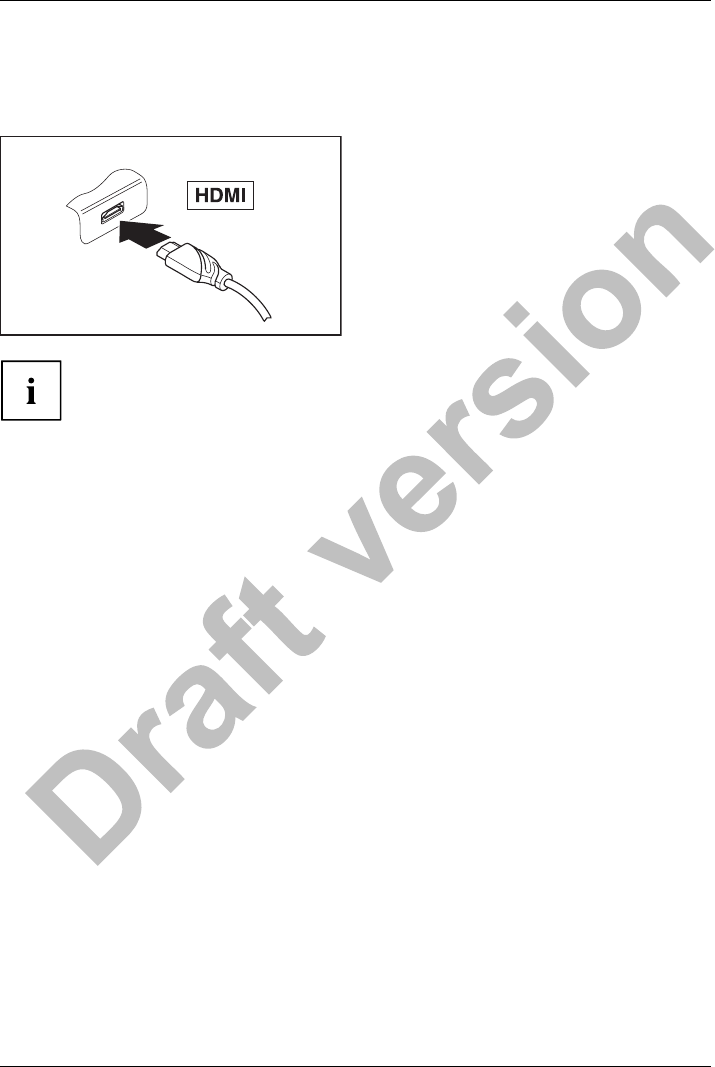
Connecting external devices
HDMI port
HDMIport
The HDMI port on your notebook can be used to connect an external amplifier,
LCD TV or a plasma TV with an HDMI connection.
►Connect the data cable to the
external device.
►Connect the data cable to the HDMI
port of the notebook.
Some LCD televisions have only two loudspeaker connections and therefore
cannot reproduce Dolby digital or DTS. In order to reproduce the sound, you
must go into Windows and adjust the sound settings.
Proceed as follows:
►Select Startsymbol – (Settings) – Control Panel – Hardware and Sound – Sound.
►Mark Realtek HDMI Output.
►Select Properties – Supported formats.
►Deactivate the settings DTS audio and Dolby digital.
►Confirm the settings with OK.
78 Fujitsu
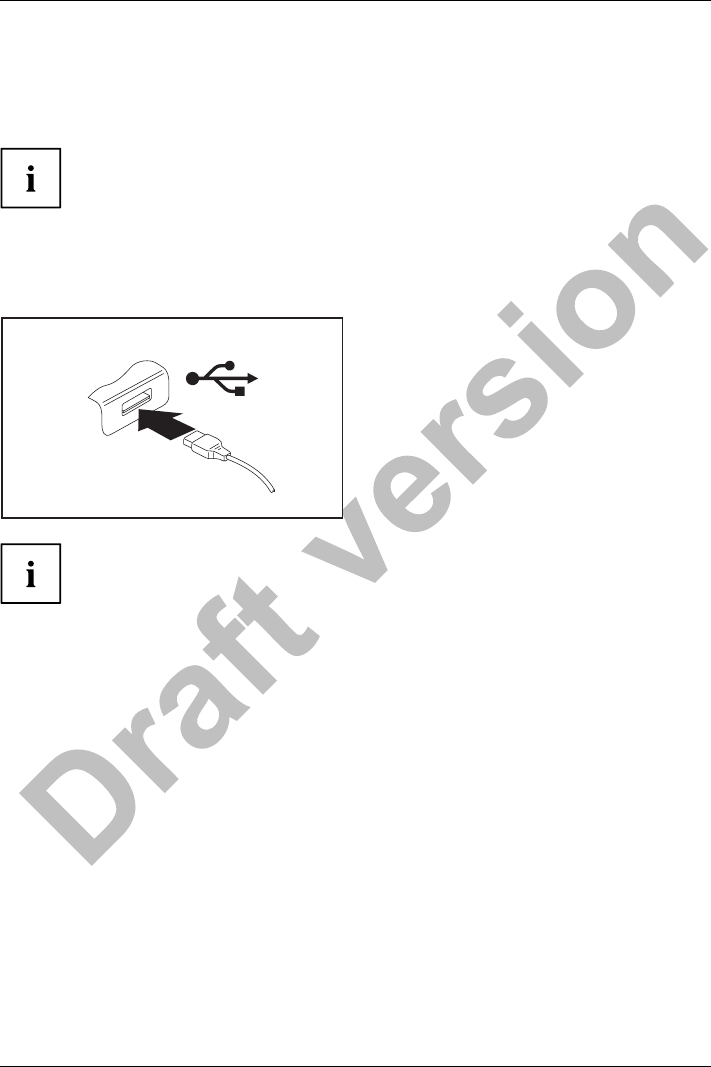
Connecting external devices
Connecting USB devices
USBports
On the USB ports, you can connect external devices that also have a USB port
(e.g. a DVD drive, a printer, a scanner or a modem).
USB devices are hot-pluggable. This means you can connect and disconnect
devices while your operating system is running.
USB 1.x has a maximum data transfer rate of 12 Mbit/s.
USB 2.0 has a data transfer rate of up to 480 Mbit/s.
USB 3.0 has a data transfer rate of up to 5 Gbit/s.
Additional information can be found in the documentation for the USB devices.
►Connect the data cable to the
external device.
►Connect the data cable to a USB
port of the notebook.
Device drivers
USB devices will be automatically recognised and installed by your operating system.
Fujitsu 79
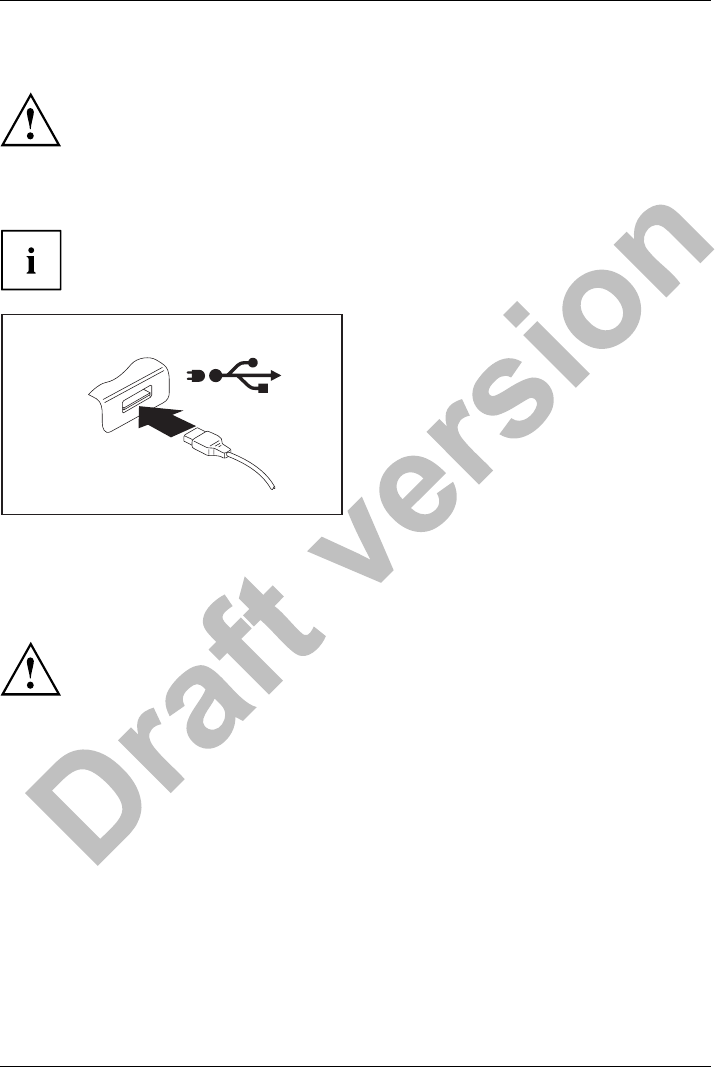
Connecting external devices
USB port with charging function (Anytime USB charge)
USBchargingfunction
It is recommended that the notebook be operated with the power supply connected
whenever the USB port with charging function is in use, as this function will drain
the battery more quickly if an external USB device is being charged.
The power supply unit must already be connected when the notebook is
switched off, as otherwise the USB charging function will be disabled and
the connected USB devices will not be charged.
Some USB devices (e.g. mobile telephones) require a driver in order to utilise the
USB charging function. In this case the USB charging function will not work when the
notebook is switched off, as no drivers are active when the notebook is switched off.
You can use this USB port to charge or supply power to a USB device (e.g. to charge a PDA
or a mobile phone or to connect a USB lamp), even if the notebook is switched off.
How to remove USB devices correctly
Always correctly remove the device according to the rules described below,
to ensure that none of your data is lost.
►Left click on the icon to safely remove hardware, located in the taskbar.
►Select the device which you want to shut down and remove.
►Press the Enter key.
Wait for the dialogue box which tells you that it is now safe to remove the device.
80 Fujitsu
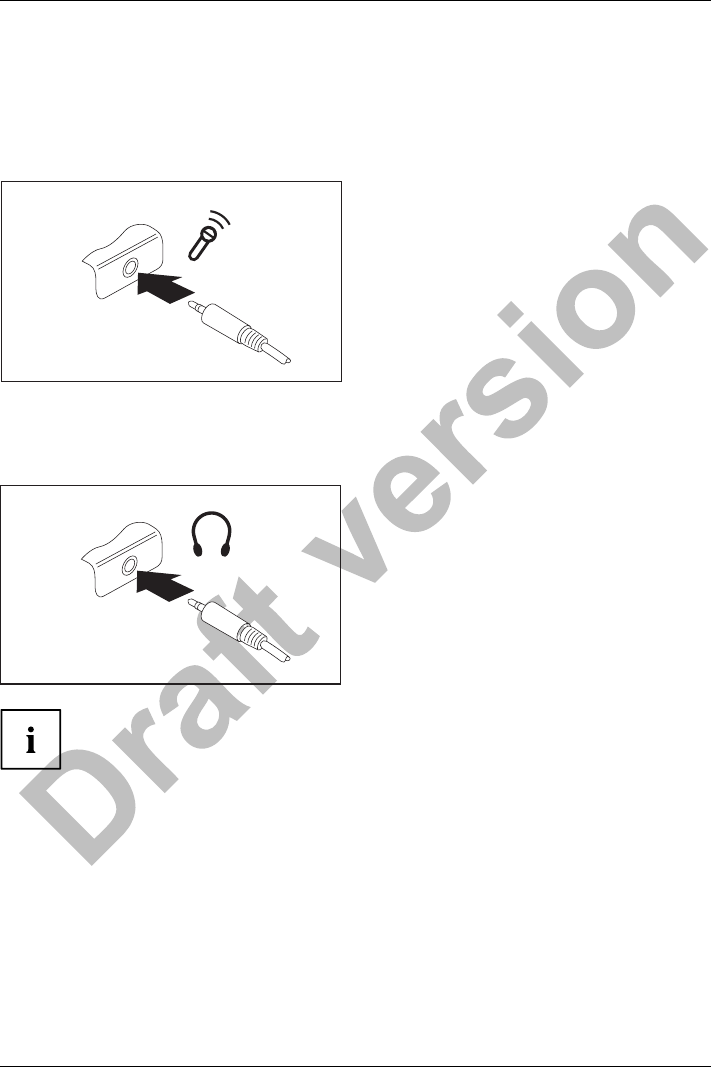
Connecting external devices
Connecting external audio devices
Microphone port/Line In
Audiodevices, connectingAudioportsMicrophone ,connecting
The microphone port/Line In allows you to connect an external microphone, a MiniDisc
player, MP3 player, CD player or a tape deck to your notebook.
►Connect the audio cable to the
external device.
►Connect the audio cable to the microphone
port/Line In of the notebook.
Headphone port
Connectingaudio devices
AudioportsConnecting headphones
You can connect headphones or external loudspeakers to your notebook via the headphone port.
►Connect the audio cable to the
external device.
►Connect the audio cable to the headphone
port of the notebook.
The internal loudspeakers are disabled.
If you purchase a cable from a retailer, please note the following information:
The headphone port on your notebook is a "3.5 mm jack socket".
If you want to connect headphones or a speaker you will need a "3.5 mm jack plug".
Fujitsu 81

Removing and installing components during servicing
Removing and installing components
during servicing
Only qualified technicians should repair your notebook. Unauthorised
opening or incorrect repair may greatly endanger the user (electric shock,
fire risk) and will invalidate your warranty.
Components
Serv icing
After consulting the Hotline/Service Desk, you may remove and install the
components described in this chapter yourself.
If you remove and install components without consulting the Hotline/Service
Desk, then the warranty of your notebook will be voided.
Notes on installing and removing boards
and components
• Switch the notebook off and pull the power plug out of the mains socket.
• Always remove the battery.
• Take care when you use the locking mechanisms on the battery and any other component.
• Never use sharp objects such as screwdrivers, scissors or knives as leverage to remove covers.
NotesBoardESD Boards with electrostatic sensitive devices (ESD) are marked with the label
shown.
When handling boards fitted with ESDs, you must always observe the following
points:
• You must always discharge static build up (e.g. by touching a grounded
object) before working.
• The equipment and tools you use must be free of static charges.
• Remove the power plug from the mains supply before inserting or removing
boards containing ESDs.
• Always hold boards with ESDs by their edges.
• Never touch pins or conductors on boards fitted with ESDs.
82 Fujitsu
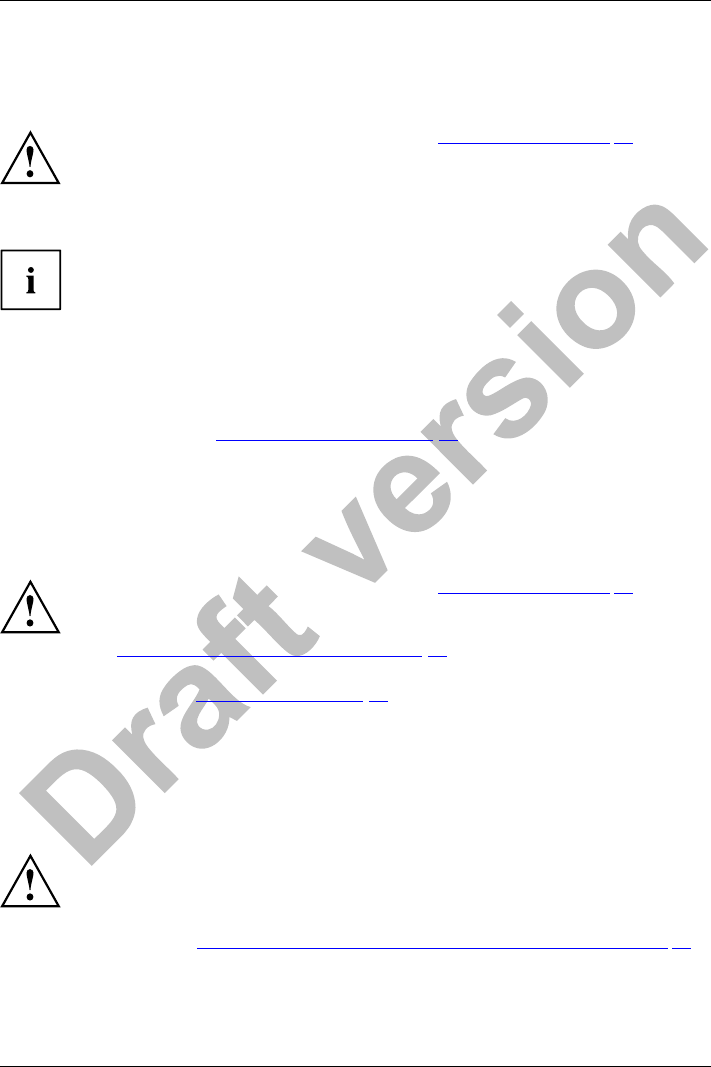
Removing and installing components during servicing
Preparing to remove components
If you are going to remove or change system components, prepare for the removal as follows:
Please observe the safety information in chapter "Important notes", Page 12.
Remove the power plug from the mains outlet !
►Switch the device off.
The device must not be in energy-saving mode !
►Close the LCD screen.
►Remove all the cables from the device.
►Turn the device over and place it on a stable, flat and clean surface. If necessary, lay an
anti-slip cloth on this surface to prevent the device from being scratched.
►Remove the battery (see "Removing the battery", Page 46).
Installing and removing memory expansion
MemorymoduleMainmemoryRemovingmemory
Systemexpansi on
Systemexpansi on
If you are asked by the Hotline/Service Desk to remove and install the memory
expansion yourself, proceed as follows:
Please observe the safety information in chapter "Important notes", Page 12.
When installing/removing memory modules, the battery must be removed from
the notebook and the notebook must not be connected to the power supply,
see "Preparing to remove components", Page 83.
Only use memory expansion modules that have been approved for your
notebook (see "Technical data", Page 99).
Never use force when installing or removing a memory extension.
Make sure that foreign objects do not fall into the memory extension compartment.
You must open the service compartment to remove or install a memory module. On some devices,
opening the compartment may expose other components. These components should be removed
and replaced only by authorised specialists. Therefore, be sure to observe the following:
Individual components can become very hot during operation. Therefore, we
recommend that you wait one hour after switching off the notebook before removing
or installing memory modules. Otherwise, there is a risk of suffering burns!
As some components are exposed that are sensitive to static electricity, please take
note of chapter "Notes on installing and removing boards and components", Page 82.
Fujitsu 83
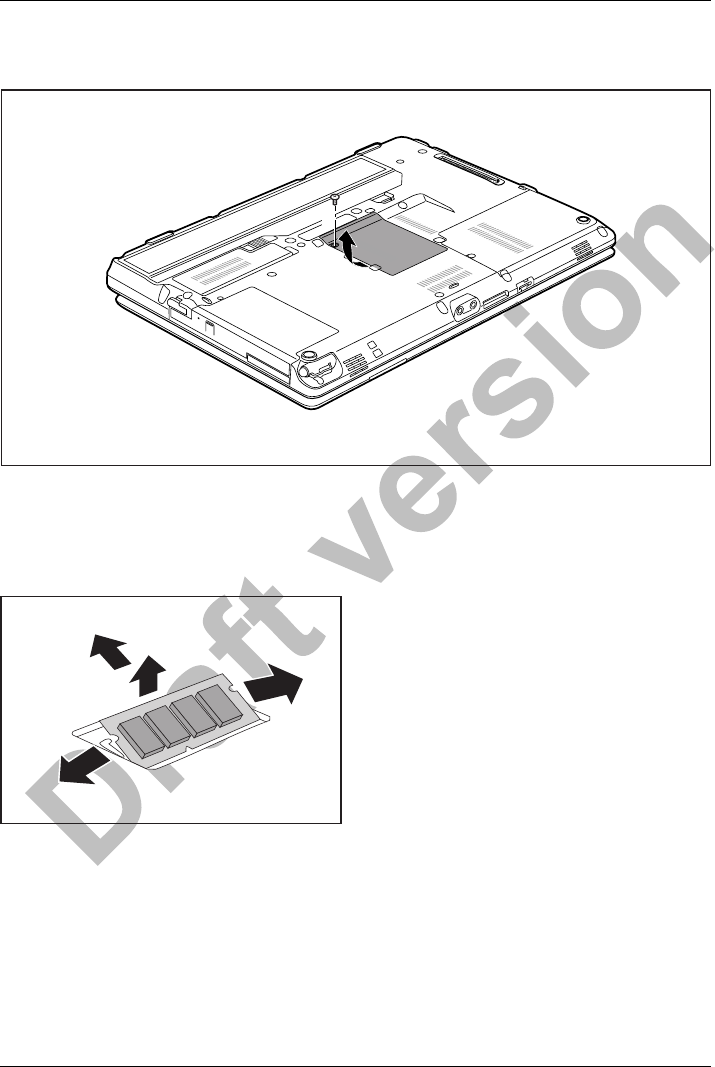
Removing and installing components during servicing
Removing a cover
2
1
►Remove the screw (1).
►Pull off the cover from the notebook in the direction of the arrow (2).
Removing memory modules
3
2
1
1
►Carefully push the two mounting
clips outwards (1).
MemoryexpansionMemorymodule
The memory module snaps upwards (2).
►Pull the memory module out of its slot
in the direction of the arrow (3).
84 Fujitsu
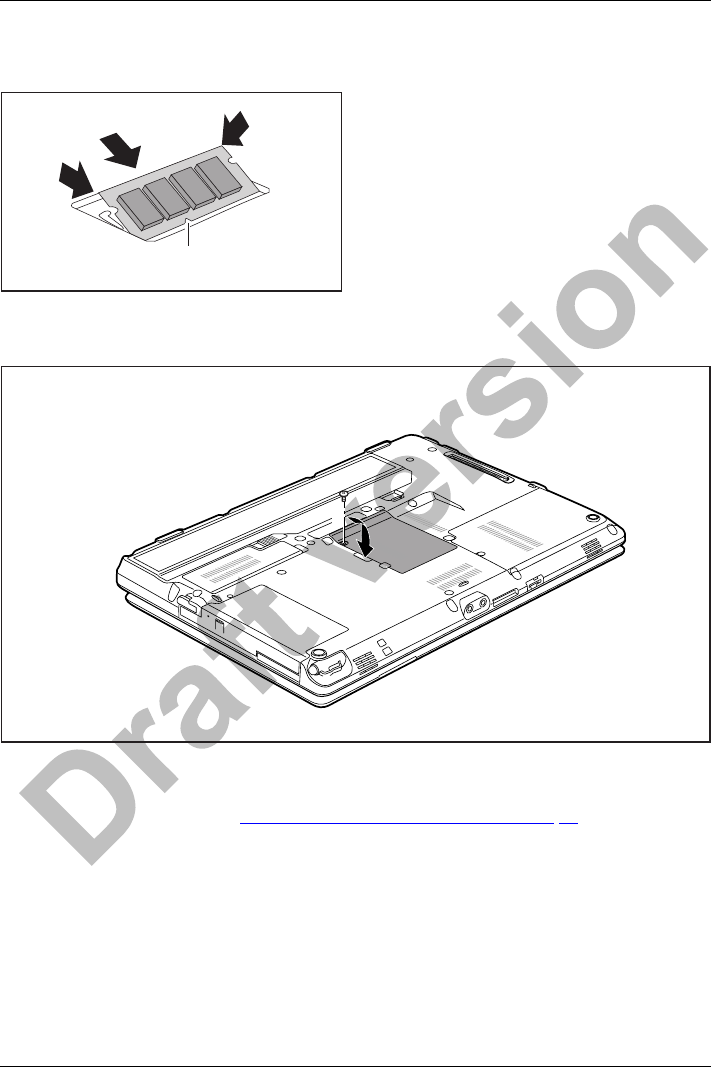
Removing and installing components during servicing
Installing a memory module
2
a
1
2
►Insert the memory module with the contacts
and the recess (a) facing the slot (1).
MemoryexpansionMemorymodule
►Carefully push the memory module
downwards until you feel it click
into place (2).
Attaching the cover
1
2
►Place the cover into position, following the direction of the arrow (1).
►Fasten the cover with the screw (2).
►Install the battery again (see "Removing and installing the battery", Page 46).
►Turn the notebook the right way up again and place it on a flat surface.
►Reconnect the cables that were previously disconnected.
Fujitsu 85
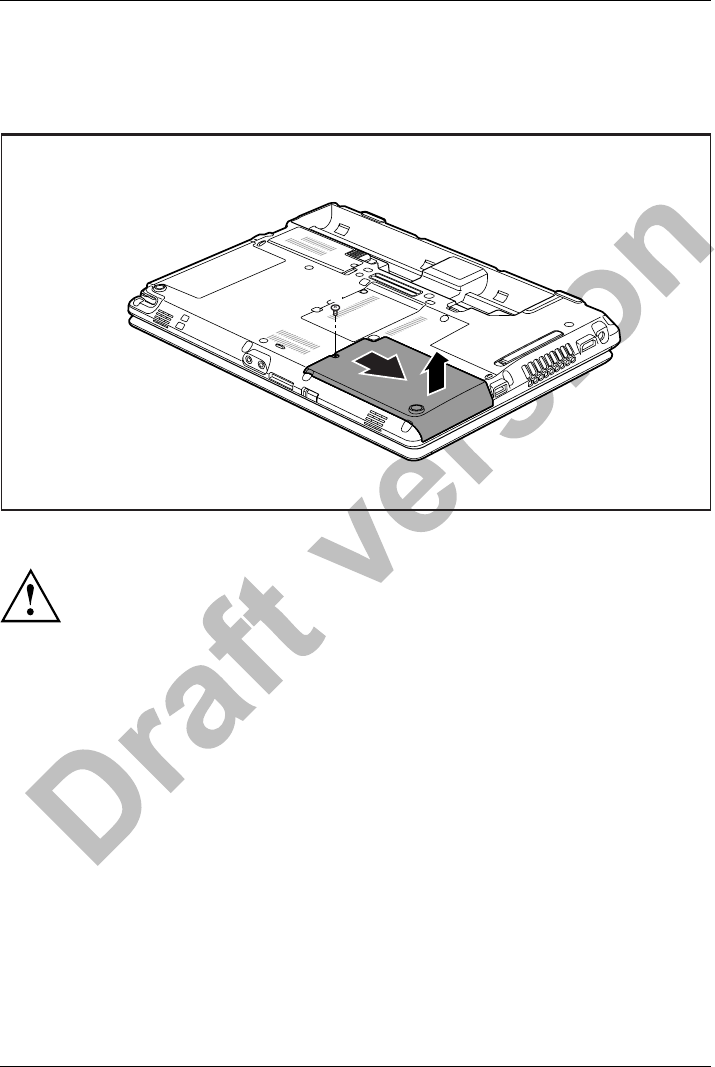
Removing and installing components during servicing
Removing and installing the harddisk
Removing a cover
1
3
2
►Remove the screw (1).
Keep the screw in a safe place. If you are removing more than one component at
the same time, store the screws for the individual components separate from each
other. If you install the wrong screws, components may be damaged.
►Slide the cover in direction of the arrow (2).
►Lift the cover off the notebook (3).
86 Fujitsu
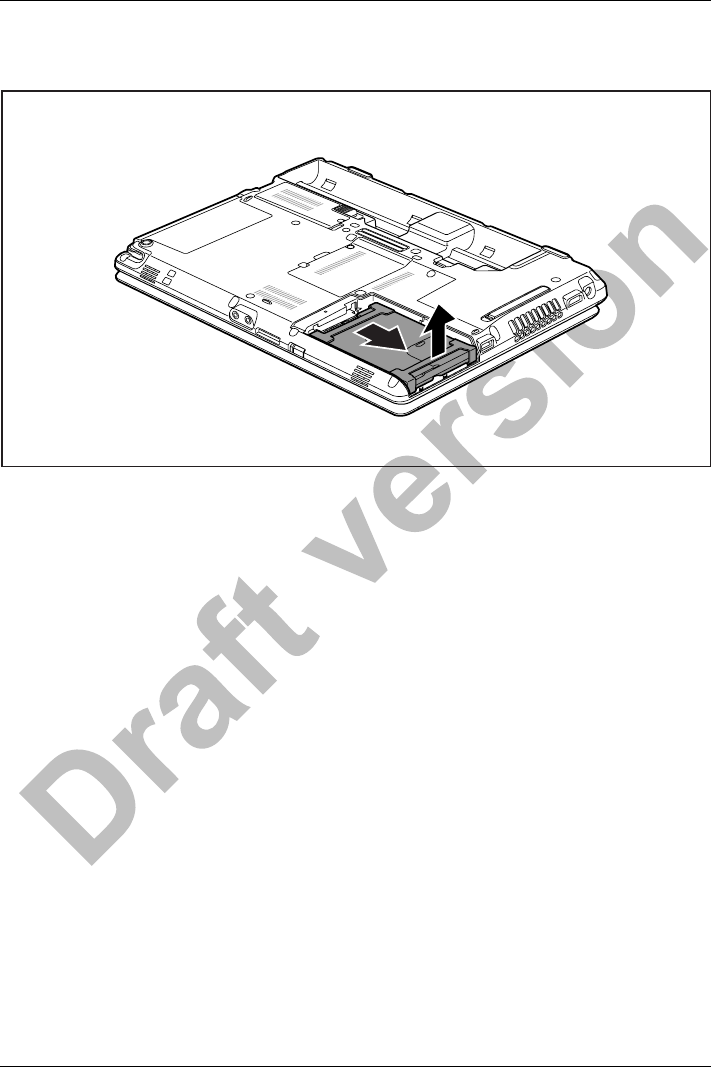
Removing and installing components during servicing
Removing a hard disk
2
1
►To release the hard disk from the contacts, pull it in the direction of the arrow (1).
►Remove the hard disk from the hard disk compartment (2).
Fujitsu 87
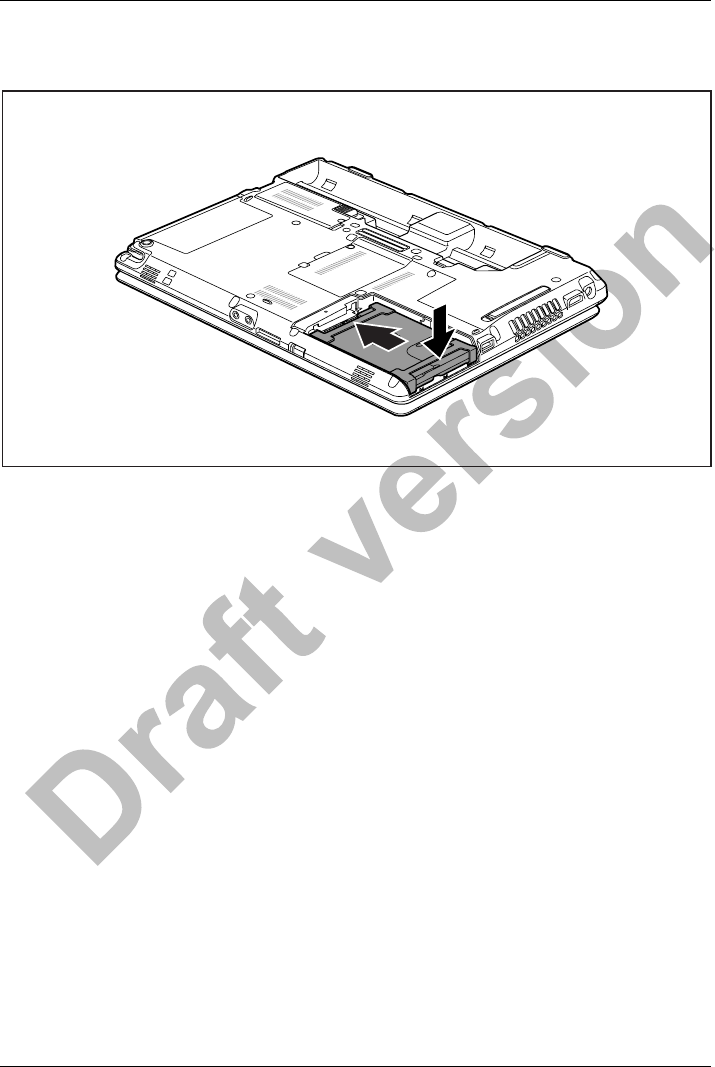
Removing and installing components during servicing
Installing a hard disk
1
2
►Place the hard disk into the hard disk compartment (1).
►Push the hard disk in the direction of the arrow (2) until the contacts of the hard disk engage.
88 Fujitsu
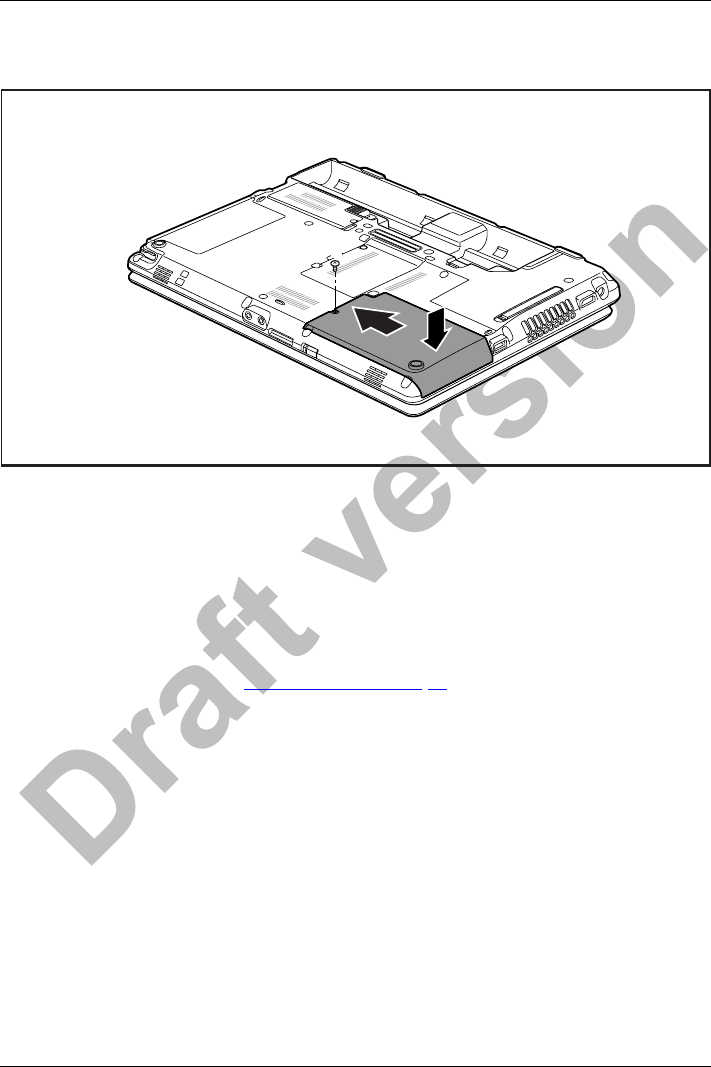
Removing and installing components during servicing
Attaching the cover
3
1
2
►Place the cover in the correct mounting position (1).
►Slide the cover in the direction of the arrow (2).
►Tighten the screw (3).
Finishing component removal
After you have removed or changed the system components as you required, please
prepare your device for operation again as follows:
►Install the battery again (see "Inserting battery", Page 47).
►Turn the notebook the right way up again and place it on a flat surface.
►Reconnect the cables that you disconnected before.
Fujitsu 89
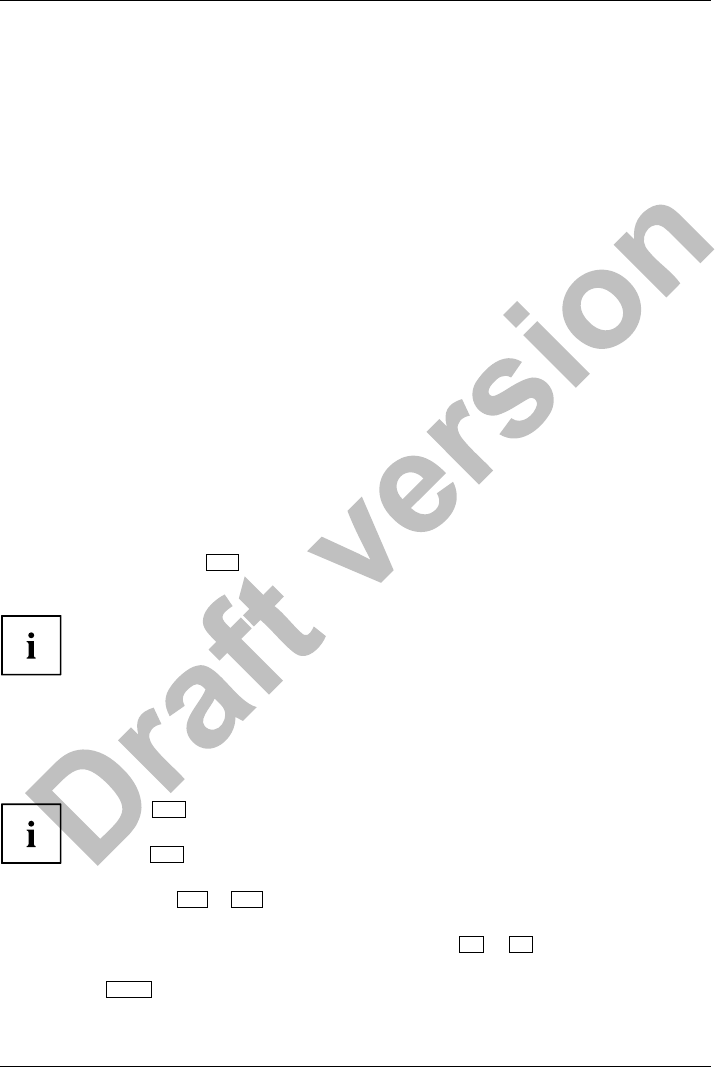
Settings in BIOS Setup Utility
Settings in BIOS Setup Utility
BIOSSetupUtilitySystemsettings,BIOSSe tupUtilityConfiguration,BIOSSetupUtilitySetupSystemconfigurationHardwareconfigurati on
The BIOS Setup Utility allows you to set the system functions and the hardware
configuration for the notebook.
When it is delivered, the notebook is set to factory default settings. You can
change these settings in BIOS Setup Utility. Any changes you make take effect as
soon as you save and exit the BIOS Setup Utility.
The BIOS Setup Utility program contains the following menus:
About Displays information relating to the BIOS, processor and notebook
System Advanced system settings
Advanced Configuration of various hardware components, such as mouse, keyboard,
processor
Security Password settings and security functions
Boot Configuration of the start-up sequence
Exit Exits the BIOS Setup Utility
Starting the BIOS Setup Utility
►Reboot the device (switch off/on or reboot the operating system).
BIOSSetupUtility
The following or a similar display appears on the screen at start-up:
<F2> BIOS Setup <F12> Boot Menu
►Press the function key F2 .
►If a password has been assigned, enter the password and press the Enter key.
If you have forgotten the password, contact your system administrator
or contact our customer service centre.
The BIOS Setup Utility starts.
Operating BIOS Setup Utility
BIOSSetupUtility
Press the F1 key to display help on the operation of the BIOS Setup Utility. The description
of the individual settings is shown in the right-hand window of the BIOS Setup Utility.
With the F9 key you can load the default settings of the BIOS Setup Utility.
►Use the cursor keys ←or →to select the menu you wish to access to make changes.
The menu is displayed on the screen.
►Select the option you want to change with the cursor keys ↑or ↓.
►Press the Enter key.
►Press the ESC key to exit the selected menu.
►For future reference, make a note of the changes you have made (for example, in this manual).
90 Fujitsu

Settings in BIOS Setup Utility
Exiting BIOS Setup Utility
BIOSSetupUtility
You need to select the desired option in the Exit menu and activate it by pressing the Enter key:
Exit Saving Changes - save changes and exit BIOS Setup Utility
►To save the current menu settings and exit the BIOS Setup Utility,selectExit Saving Changes and Yes.
The notebook is rebooted and the new settings come into effect.
Exit Discarding Changes – Discard changes and
exit BIOS Setup Utility
►To discard the changes, select Exit Discarding Changes and Yes.
The settings in place when BIOS Setup Utility was called remain effective. BIOS
Setup Utility is terminated and the notebook is rebooted.
Load Setup Defaults – Copy Standard Entries
►To copy the standard entries for all menus of the BIOS Setup Utility,
choose Load Setup Defaults and Yes.
Discard Changes – Discard changes without exiting
the BIOS Setup Utility
►To discard the changes you have made, select Discard Changes and Yes.
ThesettingsinplacewhenBIOS Setup Utility was called remain effective.
You can now make additional settings in the BIOS Setup Utility.
►If you want to exitBIOS Setup Utilitywith these settings, select Exit Saving Changes and Yes.
Save Changes - save changes without exiting
the BIOS Setup Utility
►To save the changes, select Save Changes and Yes.
The changes are saved. You can now make additional settings in the BIOS Setup Utility.
►If you want to exit BIOS Setup Utility with these settings, choose Exit Saving Changes and Yes.
Save Changes and Power Off
►To save the changes and switch off your device, select Save Changes and Power Off and Yes.
The changes are saved. Your device is shut down.
Fujitsu 91

Troubleshooting and tips
Troubleshooting and tips
TroubleshootingTipsFaultTroubleshoo ting
Follow the safety notes in the "Safety/Regulations" manual when
connecting or disconnecting cables.
If a fault occurs, try to correct it as described. If you fail to correct the problem, proceed as follows:
►Make a note of the steps and the circumstances that led to the fault. Also
make a note of any error messages displayed.
►Switch the notebook off.
►Please contact the Hotline/Service Desk.
You can find the telephone numbers in the service desk list. Please have
the following information ready when you call:
• The model name and serial number of the notebook. The serial number is
located on a sticker on the underside of the notebook.
• Notes of any messages that appear on the screen and information on acoustic signals.
• Any changes you have made to the hardware or software since
receiving the notebook.
• Any changes you have made to the BIOS Setup settings since receiving the notebook.
• Your system configuration and all peripheral devices connected to your system.
• Your sales contract.
Our notebooks have been designed primarily with mobile applications in mind. This
means that considerable effort has been made to optimise components and equipment
in terms of weight, space and energy requirements. Depending on the particular
configuration you have purchased, it is possible that functionality may be slightly reduced
compared to a desktop PC if you are running processor-intensive gaming software, e.g.
games with intensive 3D graphics. Updating your hardware with drivers which have not
been approved by Fujitsu Technology Solutions may result in performance losses, data
losses or malfunction of the equipment. A list of approved drivers and current BIOS
versions can be downloaded from: "http://support.ts.fujitsu.com/Download/Index.asp"
Help if problems occur
Should you encounter a problem with your computer that you cannot resolve yourself:
►Note the ID number of your device. The ID number is found on the type rating
plate on the back or underside of the casing.
►For further clarification of the problem, contact the Service Desk for your country (see the
Service Desk list or visit the Internet at
"http://support.ts.fujitsu.com/contact/servicedesk/ServiceDeskNumber_Int.asp"). When you
do this, please have ready the ID number and serial number of your system.
92 Fujitsu

Troubleshooting and tips
The notebook’s date or time is incorrect
SummertimeTime,daylightsavingsTime notcorrectTime notcorrectIn correc tdate /timeDateisincorrectBufferbattery,load
Cause Troubleshooting
Time and date are incorrect. ►With the BIOS-Setup-Utility,you can set the
date and time in the main menu.
If the time and date are still set incorrectly after
switching on the notebook.
►Please contact your sales outlet or our
Hotline/Service Desk.
Battery indicator does not illuminate
Cause Fault elimination
The battery is not installed correctly. ►Switch the notebook off.
►Check whether the battery is installed
correctly in its compartment.
►Switch the notebook on.
The battery is fully discharged. ►Charge the battery.
or
►Install a charged battery.
or
►Connect the notebook to a mains outlet
using the mains adapter.
When certain characters are entered on the
keyboard, only numerals are written
Abeepsounds everys econd
Cause Troubleshooting
The virtual numeric keypad of your device is
activated, see "Virtual numeric keypad", Page 39
►Press the Num key.
The notebook’s LCD screen remains blank
LCDscreenLCDscreenistoodark
Cause Troubleshooting
Monitor is switched off. ►Press a key or touch the touchpad.
External monitor or television set connected. ►Press the key combination to switch the
screen output, see "Key combinations",
Page 40.
Fujitsu 93

Troubleshooting and tips
The LCD screen is difficult to read
LCDscreenLCDscreen
Cause Troubleshooting
Reflected glare ►Turn the notebook or alter the tilt of the LCD
screen.
►Increase the brightness of the screen.
The external monitor remains blank
Monitor
Cause Troubleshooting
Monitor is switched off. ►Switch the external monitor on.
Power saving has been activated (monitor is
blank).
►Press any key to continue.
Brightness is set to dark. ►Adjust the brightness of the monitor.
Screen output is set to the notebook’s LCD
screen
►Press the key combinationtoswitchthe
screen output, see "Key combinations",
Page 40.
The external monitor’s power cable or data
cable is not connected properly.
►Switch off the external monitor and the
notebook.
►Check whether the power cable is plugged
properly into the external monitor and into
the power socket.
►Check whether the data cable is properly
connected to the notebook and the external
monitor (if it is plugged in with a connector).
►Switch on the external monitor and the
notebook.
The external monitor is blank or the image is unstable
ScreenMonitor
Cause Troubleshooting
The wrong external monitor has been selected
or the wrong screen resolution has been set for
the application program.
►Terminate the application program in
Windows by pressing Alt +F4 .Ifthe
fault persists after closing the program, use
the key combination for switching the screen
output (see "Key combinations", Page 40)to
switch over to the notebook’s LCD screen.
Change the following setting:
►Set the screen resolution: Set the screen
resolution as described in the documentation
foryouroperatingsystem.
►Select monitor: Select monitor 1 or 2 as
described in the documentation for your
operating system.
94 Fujitsu

Troubleshooting and tips
The cursor does not correctly follow the
pen movements
Cause Fault elimination
Pen incorrectly calibrated ►Calibrate the pen as shown under Hardware
and Sound / Tablet PC Settings in the Control
Panel, see "Setting the pen", Page 33 and
"Calibrating the pen", Page 34.
Pen input not working
Cause Troubleshooting
Incorrect driver installed. ►If your device is one which can only be
operated using the pen, install the driver for
the standard model.
or
►If your device is one which can be
operated using the pen and by finger,
install the driver for the "Dual Digitizer"
model.
The notebook cannot be started
Notebook
Cause Troubleshooting
The battery is not installed correctly. ►Check whether the battery is installed
correctly in its compartment.
►Switch the notebook on.
The battery is dead. ►Charge the battery.
or
►Insert a charged battery.
or
►Connect the mains adapter to the
notebook.
The power adapter is not connected correctly. ►Check whether the mains adapter is
connected correctly to the notebook.
►Switch the notebook on.
Fujitsu 95

Troubleshooting and tips
The notebook stops working
NotebookEnergys avingmode
Cause Troubleshooting
Notebook is in energy saving mode. ►Leave energy saving mode.
An application programme has caused the
malfunction.
►Close the application program or restart
the notebook (by restarting the operating
system or switching the device off and back
on again).
The battery is dead. ►Charge the battery.
or
►Insert a charged battery.
or
►Connect the mains adapter to the
notebook.
The printer does not print
Printerdoesnot print
Cause Troubleshooting
The printer is not switched on. ►Make sure that the printer is switched
on and ready for operation (refer to the
documentation supplied with the printer).
The printer is not connected correctly. ►Check that the data cable connecting
the notebook to the printer is properly
connected.
The printer driver is faulty or not correctly
installed, or it is the wrong printer driver.
►Check that the data cable connecting
the notebook to the printer is properly
connected.
►Check whetherthecorrectprinterdriveris
loaded (refer to the printer documentation).
The radio connection to a network does not work
Theradioconnect iontoane tworkdoes notwork
Cause Troubleshooting
The wireless component is disabled. ►Switch the radio component on (see
"Switching the wireless components on and
off", Page 60).
The wireless component is enabled. Despite
this, the wireless connection to a network does
not work.
►Check whether the radio connection is
switched on via the software.
►Further information on using the radio
component can be found in the help files.
96 Fujitsu

Troubleshooting and tips
The battery discharges too quickly
Battery:
Cause Troubleshooting
The battery is either too hot or too cold. In this
case the battery indicator flashes.
►Bring the notebook up/down to a normal
temperature again.
►If the operating time of the battery life is
extremely short, the battery is probably too
old. Replace battery if necessary.
You may have an application running that
consumes a great deal of power due to frequent
accessing of the hard disk or optical drive.
►Use the mains adapter as frequently as
possible.
The maximum brightness may have been set
for the screen.
►Set the screen slightly darker with the
key combination for Decreasing the screen
brightness in order to reduce the amount of
power being drawn.
Acoustic warnings
Acousticerror messages
ErrorsCause Troubleshooting
A beep sounds every few seconds.
The battery is almost flat.
►Charge the battery.
Error messages on the screen
Errormessagesont hescreen
Errormessage:
This section describes the error messages generated by the BIOS Setup. Error messages displayed
by the operating system or programmes are described in the relevant documentation.
If the error message appears repeatedly, despite troubleshooting measures, please
contact the place of purchase or our customer service centre.
Error message/cause Resolution
CMOS battery bad
If the error message occurs repeatedly, the
buffer battery in the notebook is flat.
►Contact your sales outlet or our customer
service centre.
System CMOS checksum bad - default configuration
used
The system configuration information is
incorrect.
►Switch the notebook off.
►Switch the notebook on.
►Press the function key F2 to access the
BIOS Setup.
►In the BIOS Setup, select the Exit menu.
►Select the entry Load Setup Defaults.
►Select OK and press the Enter key.
Fujitsu 97

Troubleshooting and tips
Error message/cause Resolution
Extended memory failed at offset: xxxx Failing Bits:
zzzz zzzz
When testing the extended memory an error has
resulted at the address xxxx.
►Check whether the additional memory
module has been inserted correctly.
Failure Fixed Disk n
The settings of the hard disk drive are incorrect.
►Start the BIOS Setup (Primary Master
submenu) and select the correct settings.
Keyboard controller error ►Switch the notebook off with the ON/OFF
switch.
►Wait 3 - 5 seconds and switch on the
notebook again.
Keyboard error If you are using an external keyboard:
►Check the connection and reboot the
notebook.
nn Stuck key ►Make sure that no key is pressed.
Operating system not found ►Check in the BIOS Setup whether your hard
disk has been set correctly.
►Make sure that the operating system is
installed on the corresponding drive.
Press <F1> to resume, <F2> to SETUP
This error message appears if an error occurs
during the self-test before starting the operating
system.
►Press the F1 function key to start the
operating system.
►Press the function key F2 to access the
BIOS Setup.
Previous boot incomplete - Default configuration
used Due to an error during the previous system
boot, default values were used for certain
settings. Check the settings in the BIOS Setup.
►Press the F1 function key when prompted
to do so.
Real time clock error ►Contact your sales outlet or our customer
service centre.
nnnnK Shadow RAM failed at offset: xxxx Failing
Bits: zzzz ►Contact your sales outlet or our customer
service centre.
System battery is dead - Replace and run SETUP ►Contact your sales outlet or our customer
service centre.
System cache error - Cache disabled ►Contact your sales outlet or our customer
service centre.
System timer error ►Contact your sales outlet or our customer
service centre.
98 Fujitsu

Technical data
Technical data
Notebook
General
Processor 3rd Generation Intel® Core™ with vPro™
technology
Main memory (SO DIMM) Maximum 16 Gbyte DDR3
2 slots for 2 Gbyte, 4 Gbyte or 8 Gbyte modules
Electrical data
Safety regulations complied with CE
Protection class II
Maximum power draw (when the notebook is
switched on and the battery is charged): 80 W (with and without connected port replicator)
LCD screen
Size 31.75 cm / 12.5" TFT HD
Resolution 1366 x 768 (HD), 16 mio. colors
Pixel class II
Brightness control 12 levels
Technology Wide-View High-Bright WXGA Display with LED
Background Lighting
Digitizer and glass panel • Dual Digitizer
• Matter Touchscreen
• Toughened glass
WebCam Full-HD camera (1080 p), with status indicator
Graphics card
Chip Intel® HD Graphics 4000
Maximum resolution on external display: 1920 x 1200 subpixels, 16 mio. colors
on port replicator:
• VGA: 1920 x 1200 subpixels
• DVI: 1920 x 1200 subpixels
• DisplayPort: 2560 x 1600 subpixels
Dimensions
Width x depth x height 315.6 mm x 233 mm x 37.5-33.5 mm with rubber
feet
Weight depending on configuration from 1.8 kg
Input devices
Keyboard 85 buttons, splash-protected
Touchpad 2 keys
Tablet buttons 5 buttons + 1 Windows button
Pen 1 freely programmable rocker button / eraser
Fujitsu 99

Technical data
Slots
Memory card slot 1xSDCard
ExpressCard slot 1 x ExpressCard/54
SIM card slot 1x
Ports
Monitor port (analogue) 15-pin socket
HDMI port 1 x
LAN port Socket, RJ45
Microphone port/Line In 3.5mmstereominijack
Headphones port/Line Out 3.5mmstereominijack
Docking port 100-pin socket
USB (Universal Serial Bus) Total: 3 x USB (1 x USB 3.0 with charging
function (Anytime USB charge), 2 x USB 2.0)
Security Lock 1x
Ambient conditions
Environment class DIN IEC 721 7K1
Mechanism class DIN IEC 721 7M2
Operating temperature 5℃.... 35℃
Transport temperature (2K2) –15°C .... 60°C
Port Replicator (optional)
Electrical data
Safety regulations complied with CE
Protection class II
Ports
Monitor port (analogue) 15-pin
Monitor port (digital) 25-pin, DVI-D
DisplayPort 1 x
LAN port RJ45
USB (Universal Serial Bus) 4 x USB 3.0
Audio Headphone port
Docking port 100-pin
Security Lock 1x
Ambient conditions
Environment class DIN IEC 721 7K1
Mechanism class DIN IEC 721 7M2
Operating temperature 5 °C .... 35℃
Transport temperature –15 °C .... 60 ℃
100 Fujitsu
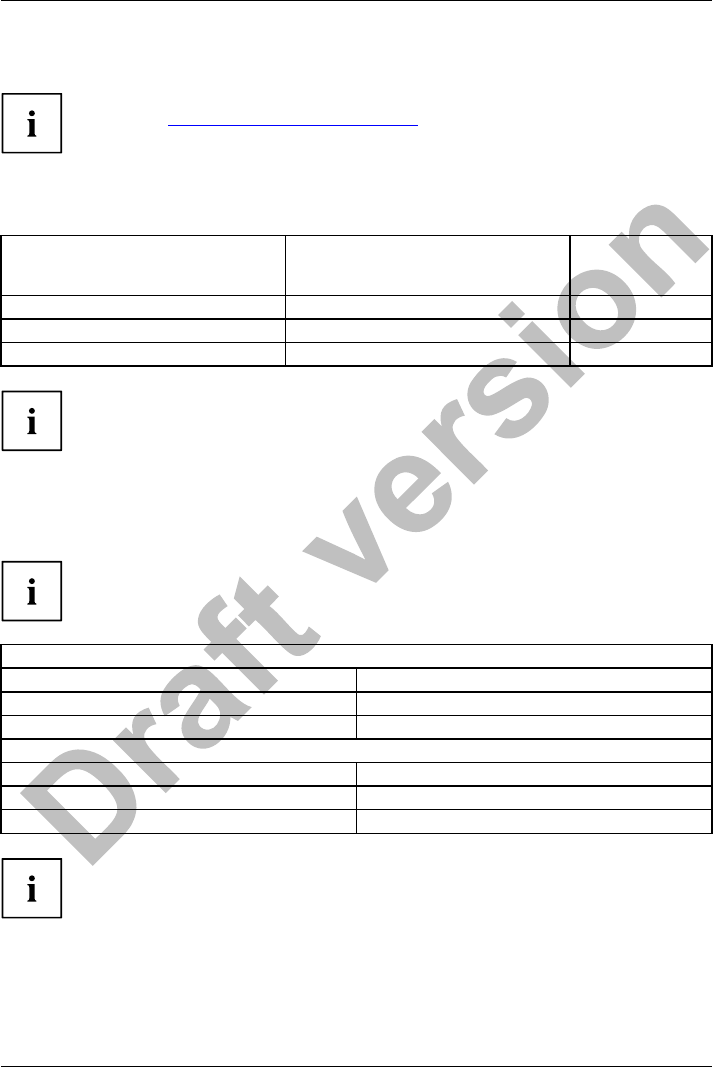
Technical data
Rechargeable battery
You will find information on the batteries used in your device on the
Internet at "http://www.fujitsu.com/fts/support/".
In addition to the main battery, you can order an optional battery which is inserted in the module slot.
All rechargeable batteries are 6-cell batteries.
Main battery
Optional battery
(to be inserted in
the module bay)
Rated voltage 10.8 V 10.8 V
Rated capacity 72.4 Wh 28.1 Wh
Nominal power 6700 mAh 2600 mAh
The operating time depends on the device configuration, the active
applications and the energy-saving settings.
Mains adapter for use with the notebook
and port replicator
The following technical data applies to the mains adapter supplied with the
notebook and to the port replicator which you can order optionally.
Primary
Rated voltage 100 V to 240 V (automatic)
Rated frequency 50 Hz to 60 Hz (automatic)
Max. rated current 0.7 A to 1.2 A
Secondary
Nominal power 80 W
Rated voltage 19 V
Max. rated current 4.22 A
An additional mains adapter or power cable can be ordered at any time.
Fujitsu 101

Manufacturer’s notes
Manufacturer’s notes
Disposal and recycling
Notes
Information about this subject can be found on your notebook or on our Internet pages.
Declarations of Conformity
Declarationof conformity
The "Declarations of Conformity" for the device can be found on the Internet at:
"http://globalsp.ts.fujitsu.com/sites/certificates/default.aspx".
Fujitsu Technology Solutions hereby declares that your device is in compliance with the
essential requirements and other relevant provisions of Directive 1999/5/EC.
CE marking
CEmarking
CE marking for devices with radio component
This equipment complies with the requirements of Directive 1999/5/EC of the European
Parliament and Commission from 9 March, 1999 governing Radio and Telecommunications
Equipment and mutual recognition of conformity.
This equipment can be used in the following countries:
Belgium Bulgaria Denmark Germany
Estonia Finland France Greece
UK Ireland Iceland Italy
Latvia Liechtenstein Lithuania Luxembourg
Malta The Netherlands Norway Austria
Poland Portugal Rumania Sweden
Switzerland Slovakia Slovenia Spain
Czech Republic Hungary Cyprus
Contact the corresponding government office in the respective country for current information on
possible operating restrictions. If your country is not included in the list, then please contact the
corresponding supervisory authority as to whether the use of this product is permitted in your country.
Regulatory notices
102 Fujitsu

103
- Regulatory Information
Regulatory Information
Notice
Changes or modifications not expressly approved by Fujitsu could void this user’s authority to operate the equipment.
FCC NOTICES
Notice to Users of Radios and Television
This equipment has been tested and found to comply with the limit for class B digital devices, pursuant to parts 15
of the FCC Rules.
These limits are designed to provide reasonable protection against harmful interference in a residential installation.
This equipment generates, uses, and can radiate radio frequency energy and, if not installed and used in accordance
with the instructions, may cause harmful interference to radio communications. However, there is no guarantee that
interference will not occur in a particular installation. If this equipment does cause harmful interference to radio or
television reception, which can be determined by turning the equipment off and on, the user is encouraged to try to
correct the interference by one or more of the following measures:
•Reorient or relocate the receiving antenna.
•Increase the separation between the equipment and receiver.
•Connect the equipment into an outlet that is on a different circuit than the receiver.
•Consult the dealer or an experienced radio/TV technician for help.
Shielded interconnect cables must be employed with this equipment to ensure compliance with the pertinent RF
emission limits governing this device.
DOC (INDUSTRY CANADA) NOTICES
Notice to Users of Radios and Television
This Class B digital apparatus meets all requirements of Canadian Interference-Causing Equipment
Regulations.
CET appareil numérique de la class B respecte toutes les exigence du Réglement sur le matérial brouilleur du Canada.

104
Appendix A: WLAN User’s Guide
FCC Regulatory Information
Please note the following regulatory information related to the optional wireless LAN device.
Regulatory Notes and Statements
Wireless LAN, Health and Authorization for use
Radio frequency electromagnetic energy is emitted from Wireless LAN devices. The energy levels of these emissions, however, are far much
less than the electromagnetic energy emissions from wireless devices such as mobile phones. Wireless LAN devices are safe for use by
consumers because they operate within the guidelines found in radio frequency safety standards and recommendations. The use of Wireless
LAN devices may be restricted in some situations or environments, such as:
•On board an airplane, or
•In an explosive environment, or
•In situations where the interference risk to other devices or services is perceived or identified as harmful.
In cases in which the policy regarding use of Wireless LAN devices in specific environments is not clear (e.g., airports, hospitals,
chemical/oil/gas industrial plants, private buildings), obtain authorization to use these devices prior to operating the equipment.
Regulatory Information/Disclaimers
Installation and use of this Wireless LAN device must be in strict accordance with the instructions included in the user documentation
provided with the product. Any changes or modifications made to this device that are not expressly approved by the manufacturer may void
the user’s authority to operate the equipment. The manufacturer is not responsible for any radio or television interference caused by
unauthorized modification of this device, or the substitution or attachment of connecting cables and equipment other than those specified
by the manufacturer. It is the responsibility of the user to correct any interference caused by such unauthorized modification, substitution or
attachment. The manufacturer and its authorized resellers or distributors will assume no liability for any damage or violation of government
regulations arising from failure to comply with these guidelines.

105
This device must not be co-located or operated in conjunction with any other antenna or transmitter.
For IEEE 802.11a Wireless LAN: For operation within 5.15~5.25 GHz frequency range, it is restricted to indoor environments, and the
antenna of this device must be integral.
Federal Communications Commission statement
This device complies with Part 15 of FCC Rules.
Operation is subject to the following two conditions: (1) This device may not cause interference, and, (2) This device must accept any
interference, including interference that may cause undesired operation of this device.
FCC Interference Statement
This equipment has been tested and found to comply with the limits for a Class B digital device, pursuant to Part 15 of the FCC Rules. These
limits are designed to provide reasonable protection against harmful interference in a residential installation. This equipment generates,
uses, and can radiate radio frequency energy. If not installed and used in accordance with the instructions, it may cause harmful interference
to radio communications. However, there is no guarantee that interference will not occur in a particular installation.
If this equipment does cause harmful interference to radio or television reception, which can be determined by turning the equipment off
and on, the user is encouraged to try and correct the interference by one or more of the following measures:
1Reorient or relocate the receiving antenna.
2Increase the distance between the equipment and the receiver.
3Connect the equipment to an outlet on a circuit different from the one the receiver is connected to.
4Consult the dealer or an experienced radio/TV technician for help.
FCC Radio Frequency Exposure statement
The available scientific evidence does not show that any health problems are associated with using low power wireless devices. There is no
proof, however, that these low power wireless devices are absolutely safe. Low power wireless devices emit low levels of radio frequency
energy (RF) in the microwave range while being used. Whereas high levels of RF can produce health effects (by heating tissue), exposure to
low-level RF that does not produce heating effects causes no known adverse health effects. Many studies of low-level RF exposure have not
found any biological effects. Some studies have suggested that some biological effects might occur, but such findings have not been
confirmed by additional research.
The wireless LAN radio device has been tested and found to comply with FCC radiation exposure limits set forth for an uncontrolled equipment
and meets the FCC radio frequency (RF) Exposure Guidelines in Supplement C to OET65.
Figure A-1. Ad Hoc Mode Network

1
06 -
Export restrictions
This product or software contains encryption code which may not be exported or transferred from the US or Canada without an approved US
Department of Commerce export license. This device complies with Part 15 of FCC Rules., as well as ICES 003 B / NMB 003 B. Operation is
subject to the following two conditions: (1) this device may not cause harmful interference, and (2) this device must accept any interference
received, including interference that may cause undesirable operation. Modifications not expressly authorized by Fujitsu America, Inc. may
invalidate the user's right to operate this equipment.
Canadian Notice
The device for the 5150 - 5250 MHz band is only for indoor usage to reduce the potential for harmful interference to co-channel mobile
satellite systems.
The maximum antenna gain of 6 dBi permitted (for devices in the 5250 - 5350 MHz, 5470 - 5725 MHz and 5725 - 5825 MHz bands) to comply
with the e.i.r.p. limit as stated in A9.2 of RSS210.
In addition, users are cautioned to take note that high power radars are allocated as primary users (meaning they have priority) of 5250 -
5350 MHz and 5650 - 5850 MHz and these radars could cause interference and/or damage to LE-LAN devices.

107
- Before Using the Optional Wireless LAN
Before Using the Optional Wireless LAN
This manual describes the procedures required to properly set up and configure the optional integrated Wireless LAN
Mini-PCI device (referred to as "WLAN device" in the rest of the manual). Before using the WLAN device, read this
manual carefully to ensure its correct operation. Keep this manual in a safe place for future reference.
Wireless LAN Device Covered by this Document
This document is applicable to systems containing one of the following optional devices:
•Integrated Intel Centrino Advanced-N 6205 (802.11a/b/g/n)
•Atheros XSPAN 802.11abgn
Characteristics of the WLAN Device
•The WLAN device is a Mini-PCI card attached to the main board of the mobile computer.
•The WLAN device operates in license-free RF bands, eliminating the need to procure an FCC operating license.
The WLAN operates in the 2.4GHz Industrial, Scientific, and Medical (ISM) RF band and the lower, middle, and
upper bands of the 5GHz Unlicensed National Information Infrastructure (UNII) bands.
•The WLAN devices are capable of four operating modes, IEEE802.11a, IEEE802.11b, IEEE802.11g, and
IEEE802.11n
•The WLAN devices are Wi-Fi certified and operate (as applicable) at a the maximum data rate of 450 Mbps
(theoretical) in IEEE802.11n mode; 54 Mbps in IEEE802.11a or IEEE802.11g mode; and 11 Mbps in
IEEE802.11b mode.
•The WLAN devices support the following encryption methods - WEP, TKIP, CKIP, and AES encryption.
•The Wireless LAN devices are compliant with the following standards: WPA, WPA2, CCX1.0, CCX2.0, CCX3.0, and
CCX4.0.
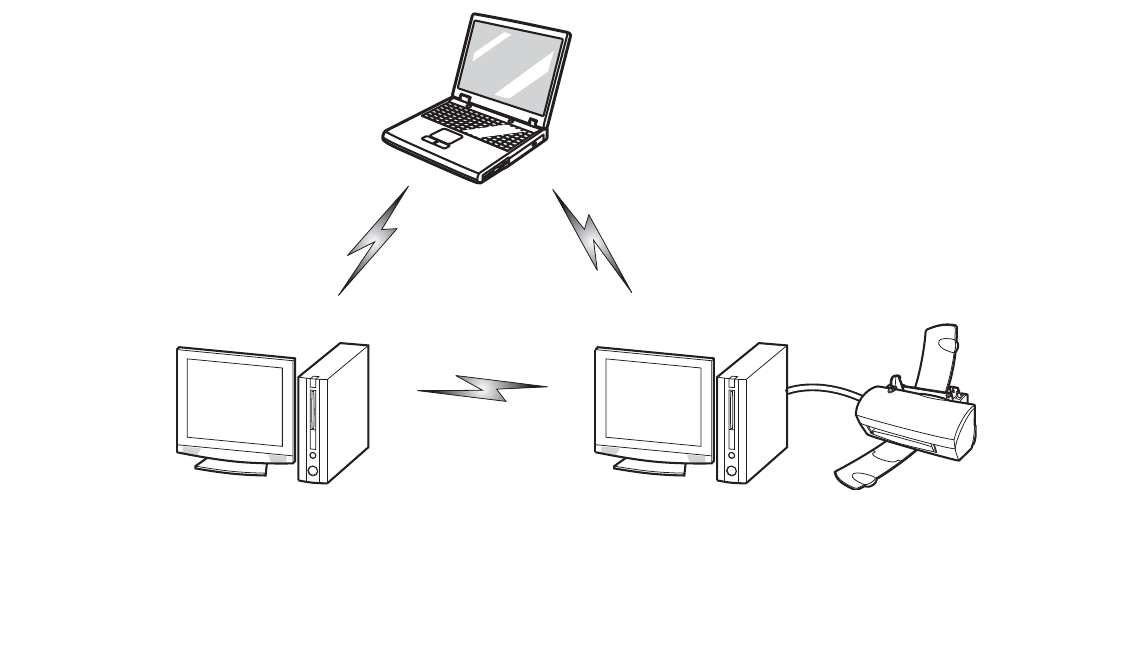
1
08- Before Using the Optional Wireless LAN
Wireless LAN Modes Using this Device
Ad Hoc Mode
"Ad Hoc Mode" refers to a wireless network architecture where wireless network connectivity between multiple
computers is established without a central wireless network device, typically known as Access Point(s). Connectivity
is accomplished using only client devices in a peer-to-peer fashion. That is why Ad Hoc networks are also known as
peer-to-peer networks. Ad Hoc networks are an easy and inexpensive method for establishing network connectivity
between multiple computers. Ad Hoc mode requires that the SSID, network authentication, and encryption key
settings are identically configured on all computers in the Ad Hoc network.
Figure 49. Ad Hoc Mode Network
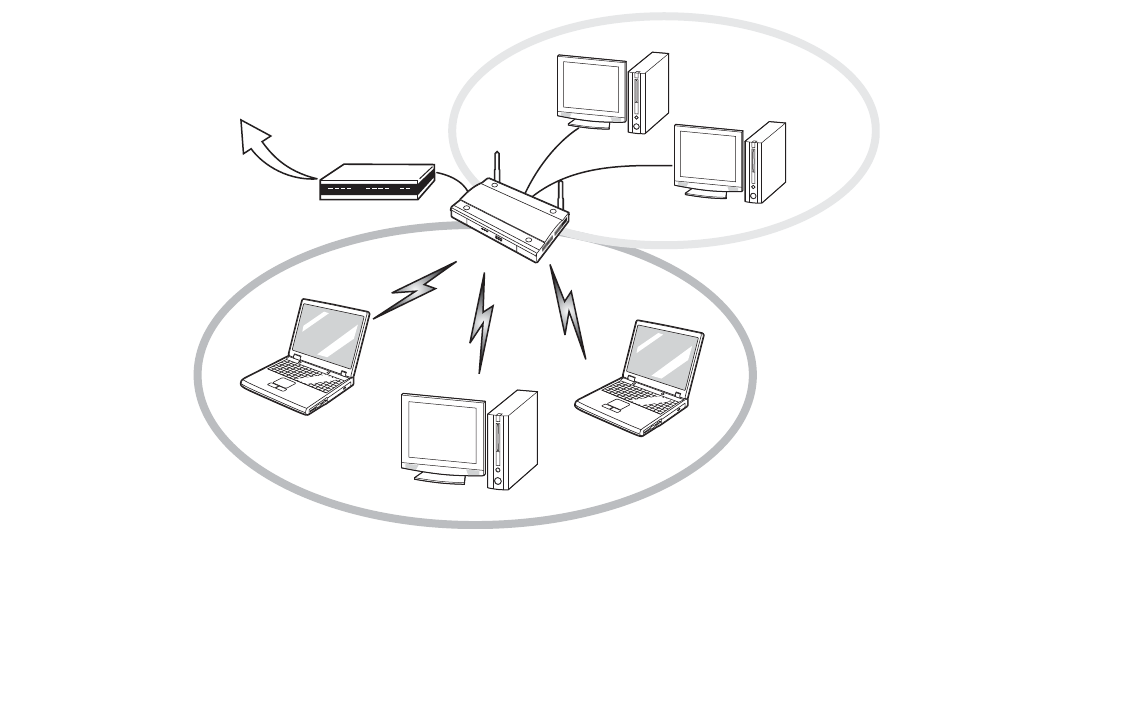
109
Before Using the Optional Wireless LAN
Access Point (Infrastructure) Mode
Infrastructure mode refers to a wireless network architecture in which devices communicate with wireless or wired
network devices by communicating through an Access Point. In infrastructure mode, wireless devices can
communicate with each other or with a wired network. Corporate wireless networks operate in infrastructure mode
because they require access to the WLAN in order to access services, devices, and computers (e.g., file servers,
printers, databases).
Figure 50. Access Point (Infrastructure) Mode Network
ADSL modem,
cable modem,
or similar
Internet Wired LAN
Access Point*
Wireless LAN *An optional hub for a wired
LAN may be required depending
upon the type of access point used.

110
- Before Using the Optional Wireless LAN
How to Handle This Device
The WLAN device is an optional device that may come pre-installed in your mobile computer. Under normal
circumstances, it should not be necessary for you to remove or re-install it. The operating system that your mobile
computer comes with has been pre-configured to support the WLAN device.
•The Wireless LAN devices support IEEE802.11a, IEEE802.11b, IEEE802.11g, and IEEE802.11n.
•The WLAN devices operate in the 2.4 GHz ISM band and the 5 GHz lower, middle, and upper UNII bands.
•Microwave ovens may interfere with the operation of WLAN devices since they operate in the same 2.4 GHz
frequency range as IEEE802.11b/g/n devices. Interference by microwaves does not occur with IEEE802.11a
radio which operates in the 5 GHz RF band.
•Wireless devices that transmit in the 2.4 GHz range may interfere with operation of WLAN devices in
IEEE802.11b/g/n modes. Symptoms of interference include reduced throughput, intermittent disconnects, and
many frame errors. It is HIGHLY recommended that these interfering devices be powered off to ensure proper
operation of the WLAN device.
Deactivating/Disconnecting the WLAN Device
Disconnecting the WLAN device may be desired in certain circumstances (to extend battery life) or where certain
environments require it (i.e. hospitals, clinics, airplanes, etc.). The WLAN device can be deactivated by using the
Wireless On/Off Switch, and it can be disconnected in Windows using the WLAN icon in the system tray (Note that
disconnecting via the icon in the system tray does not turn off the radio; it continues to transmit and receive even
though it’s not connected.).
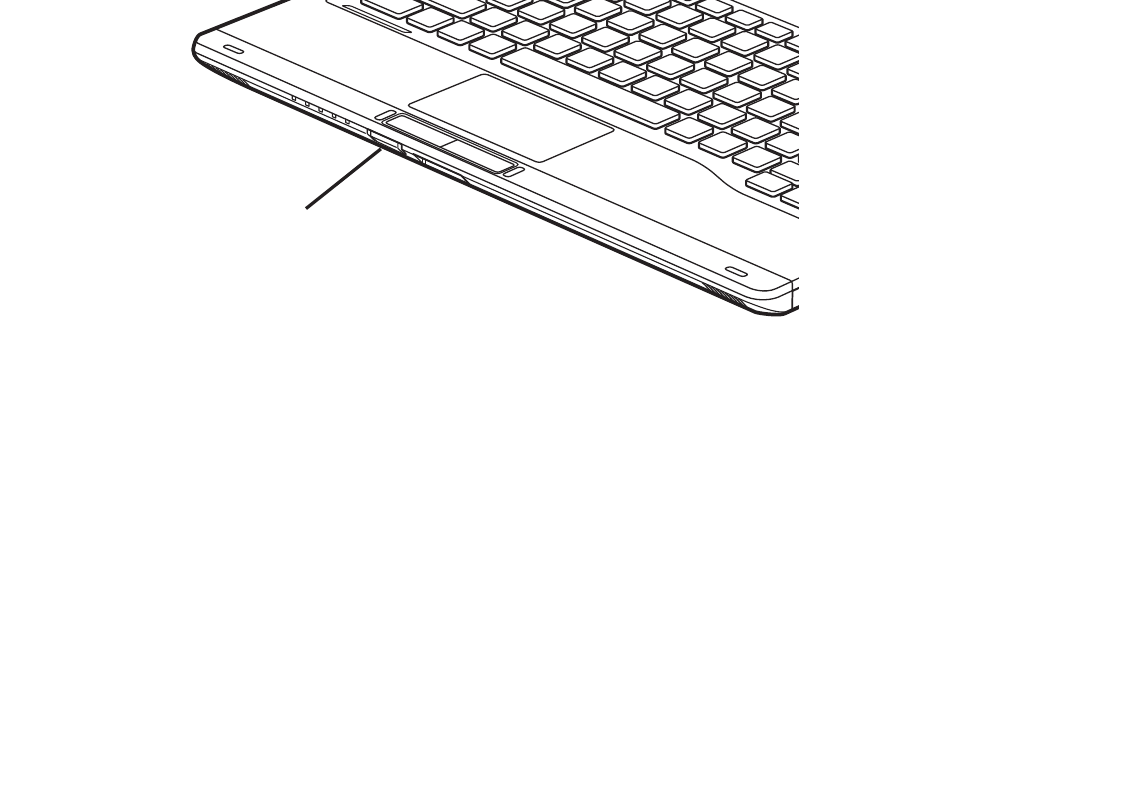
111
- Before Using the Optional Wireless LAN
Deactivation Using the Wireless On/Off Switch
The WLAN device can be deactivated quickly and efficiently by toggling the Wireless Device On/Off Switch to the Off
position.
The switch has no effect on non-Wireless LAN models.
Figure 51. Wireless Device On/Off Switch Location
Disconnection Using the Icon in the Taskbar
Note that disconnecting via the icon in the system tray does not turn off the radio; it continues to transmit and receive
even though it’s not connected.
1Right-click the WLAN icon in the taskbar at the bottom right of your screen.
2Choose Disconnect from a network.
Activating the WLAN Device
Activation of the WLAN device can be accomplished using the same methods as the deactivation process
•Using the Wireless On/Off Switch
•In Windows, by right-clicking the WLAN icon then clicking “Connect to a network”
Wireless Device Switch

112
- Configuring the Wireless LAN
Configuring the Wireless LAN
The optional WLAN device can be configured to establish wireless network connectivity using the software that is built
into Windows. Support for most industry standard security solutions is contained in this software.
Pre-defined parameters will be required for this procedure. Please consult with your network administrator for these
parameters:
Configuring the WLAN
1Click the Start button, then select Control Panel. (If you are in Windows Vista and the Control Panel is not in Classic
View, select Classic View from the left panel.)
2Double-click the Network and Sharing Center icon.
3Select “Manage wireless networks” from the left panel.
4Click on the [Add] button.
5Depending upon what type of connection you would like to make, make a selection. For an infrastructure network,
select “Manually create a network profile. For ad hoc network, select “Create an ad hoc network”.
6Enter the required information. If necessary, consult with your network administrator for some of the information.
7In the event you require assistance, go to the Network and Sharing Center window (Start -> Control Panel ->
Network and Sharing Center), and type in relevant keywords in the Search box.
Connecting to a Network
After you have configured your computer, you can connect to an active network by performing the following steps:
1Click on the WLAN icon in the system tray.
2Select “Connect to a network”.
3Select a network from the list that appears, and click the [Connect] button.
Connection to the network
After you have configured your computer, you can connect to an active network by clicking on the Wireless Network
icon in the system tray:

113
Troubleshooting the WLAN
Troubleshooting the WLAN
Troubleshooting
Causes and countermeasures for troubles you may encounter while using your wireless LAN are described in the
following table. If you are unfamiliar with the steps required, consult your System Administrator or go to [Start] ->
Help and Support -> Networking and the Web
Problem Possible Cause Possible Solution
Unavailable
network
connection
Incorrect network
name (SSID) or
network key
Ad hoc connection: verify that the network names (SSID’s) and network keys (WEP) of all
computers to be connected have been configured correctly. SSID’s and WEP or WPA/WPA2 Pre-
Shared key values must be identical on each machine.
Access Point (Infrastructure) connection: set network name (SSID) and network key to the
same values as those of the access point.
Set the Network Authentication value identically to that of the Access Point. Please consult your
network administrator for this value, if necessary.
Weak received
signal strength
and/or link quality
Ad hoc connection: Retry connection after shortening the distance to the destination computer or
removing any obstacles for better sight.
Access Point (Infrastructure) connection: Retry connection after shortening the distance to the
access point or removing any obstacles for better transmission.
The WLAN device
has been
deactivated or
disabled
Check if the wireless switch is turned On. Go to Start -> Control Panel, and double-click on
Windows Mobility Center. If the wireless network is off, click the [Turn wireless on] button.
The computer to be
connected is turned
off
Check if the computer to be connected is turned ON.

114
- Troubleshooting the WLAN
Unavailable
network
connection
(continued)
RF interference from
Access Points or
other wireless
networks
The use of identical or overlapping RF channels can cause interference with the operation of the
WLAN device. Change the channel of your Access Point to a channel that does not overlap with
the interfering device.
Wireless network
authentication has
failed
Re-check your Network Authentication, Encryption, and Security settings. Incorrectly configured
security settings such as an incorrectly typed WEP key, a misconfigured LEAP
username/password, or an incorrectly chosen authentication method will cause the LAN device
to associate but not authenticate to the wireless network.
Incorrectly
configured network
settings
Recheck the configuration of your network settings.
Incorrect IP address
configuration
This only applies to networks using static IP addresses. Please contact your network
administrator for the correct settings.
Problem Possible Cause Possible Solution

115
WLAN Specifications
WLAN Specifications
Specifications
* “Wi-Fi based” indicates that the interconnectivity test of the organization which guarantees the interconnectivity of wireless LAN (Wi-Fi
Alliance) has been passed.
** The communication ranges shown above will increase or decrease depending on factors such as number of walls, reflective material, or
interference from external RF sources.
*** Encryption with network key (WEP) is performed using the above number of bits, however, users can set 40 bits/ 104 bits after
subtracting the fixed length of 24 bits.
**** Depending on practical environments, the allowable number of computers to be connected may be decreased.
Item Specification
Type of network The integrated Intel Centrino Advanced-N 6205 (802.11abgn 2x2) and Atheros XSPAN 802.11a/b/g/n WLAN
devices conform to IEEE 802.11a, 802.11b/g, and 802.11n, Wi-Fi based*.
Transfer rate (Automatic switching) 54 Mbps maximum data rate (IEEE802.11n to be determined)
Active frequency •802.11n: 2.4 GHz or 5 GHz
•802.11b/g: 2400~2473 MHz
•802.11a: 4900 ~ 5850 MHz
Typical operating distances** •802.11a: 40 ft. (12 m) @ 54 Mbps; 300 ft. (91 m) @ 6 Mbps
•802.11b: 100 ft. (30 m) @ 11 Mbps; 300 ft. (91 m) @ 1 Mbps
•802.11g: 100 ft. (30 m) @ 54 Mbps; 300 ft. (91 m) @ 1 Mbps
•802.11n: Estimated double the operating distance of 802.11g and 802.11a in their respective frequencies.
Number of channels •802.11a: 8 independent channels
•802.11b/g: 11 channels, 3 non-overlapping channels
•802.11n: 2.4 GHz - 3 non-overlapping channels when Channel Bonding is not used; 2 non-overlapping
channels when Channel Bonding is used.
5 GHz - 12 non-overlapping UNII channels with or without Channel Bonding
Security Encryption Types - WEP, TKIP, AES***, CKIP, WPA 1.0 and WPA 2.0 compliant
Maximum recommended number of
computers to be connected over
wireless LAN (during ad hoc
connection)
10 units or less ****

116
- Using the Bluetooth Device
Using the Bluetooth Device
The Integrated Bluetooth module is a wireless device installed in selected Fujitsu mobile computers.
What is Bluetooth
Bluetooth technology is designed as a short-range wireless link between mobile devices, such as laptop computers,
phones, printers, and cameras. Bluetooth technology is used to create Personal Area Networks (PANs) between
devices in short-range of each other.
Where to Find Information About Bluetooth
The Bluetooth module contains a robust Help user’s guide to assist you in learning about operation of the Bluetooth
device.
To access the Help file:
1Click on the Bluetooth icon in notification area.
2Select Open Settings. The "Bluetooth Settings" dialog will be opened.
3Select the Share tab.
4Click on "Learn more about Bluetooth sharing" link. The Bluetooth User Guide will open.
For additional information about Bluetooth Technology, visit the Bluetooth Web site at: www.bluetooth.com.
SLIDING THE WIRELESS DEVICE SWITCH ON THE FRONT OF THE SYSTEM WILL TURN BOTH THE OPTIONAL WIRELESS LAN AND BLUETOOTH DEVICES ON
AND OFF AT THE SAME TIME. TO ENABLE OR DISABLE BLUETOOTH INDIVIDUALLY, PERFORM THE FOLLOWING STEPS:
•CLICK ON THE BLUETOOTH ICON IN THE SYSTEM NOTIFICATION AREA LOCATED IN THE LOWER RIGHT CORNER OF THE SCREEN.
•SELECT TURN ADAPTER OFF.

117
- Using the Bluetooth Device
FCC Radiation Exposure Statement
This equipment complies with FCC radiation exposure limits set forth for an uncontrolled environment. The Bluetooth
antenna is exempt from minimum distance criteria due to its low power.
The transmitters in this device must not be co-located or operated in conjunction with any other antenna or
transmitter.
Canadian Notice
To prevent radio interference to the licensed service, this device is intended to be operated indoors and away from
windows to provide maximum shielding. Equipment (or its transmit antenna) that is installed outdoors is subject to
licensing.
Warranty
Users are not authorized to modify this product. Any modifications invalidate the warranty.
This equipment may not be modified, altered, or changed in any way without signed written permission from Fujitsu.
Unauthorized modification will void the equipment authorization from the FCC and Industry Canada and the
warranty.

Index
Index
A
A beep sounds every second 93
Acoustic error messages 97
Anti-theft protection 69
Audio devices, connecting 81
Audio ports 81
B
Backspace 38
Bass loudspeaker (subwoofer) 58
Battery
battery life 45
caring for and maintaining 45
charge level 45, 54
charging 45
self-discharge 45
storage 45
Battery status meter 45
Battery:
discharges too quickly 97
BIOS Setup Utility
calling 90
exiting 91
operating 90
protecting with password 70
settings 90
Bluetooth
Switching off module 60
Switching on module 60
Bluetooth, safety notes 12
Board 82
Buffer battery, load 93
Buttons 37
C
Caps Lock 38
CD/DVD indicator 51
CD/DVD:
manual emergency removal 52
CE marking 102
Charging capacity, battery 45
Cleaning 14
Components
installing / removing 82
Configuration, BIOS Setup Utility 90
Connecting audio devices 81
Connecting headphones 81
Crystal View display
cleaning 14
Cursor control keys 38
Cursor keys 38
D
Date is incorrect 93
Declaration of conformity 102
Device
setting up 16
Devices
connecting 75
disconnecting 75
Display orientation
selecting 24
DOC (INDUSTRY CANADA) NOTICES 104
Drive
Removing 49
E
Emergency removal of data carrier 52
Energy
energy saving 13
Energy saving 13
Energy saving mode
leaving 96
Enter 38
Enter key 38
Error message:
on the screen 97
Error messages on the screen 97
Errors
Acoustic warnings 97
ESD 82
Ethernet LAN 62
ExpressCard 56
F
Fault
correction 92
Fingerprint sensor 69
configure 69
First-time setup 15
Fn + F10 41
Fn key 38
Fn+F3 40
Fn+F4 40
Fn+F6 40
Fn+F7 40
Fn+F8 40
Fn+F9 40
118 Fujitsu

Index
G
Getting started 15
H
Handling
data carriers 50
Hardware configuration 90
HDMI port 78
I
Important notes 12
Incorrect date/time 93
Inserting
a data carrier 51
K
Keyboard 37
cleaning 14
L
Landscape orientation
screen 24
LCD screen
cleaning 14
difficult to read 94
notes 28
reduce brightness 40
reflected glare 94
remains blank 93
LCD screen is too dark 93
Life, battery 45
Line feed 38
Loudspeaker
switch off 40
switch on 40
Loudspeakers 58
M
Main memory
see Adding memory 83
Mains adapter
connecting 16
setting up 16
Manual removal of data carrier 52
Mechanical backup 69
Memory card
handling 55
inserting 55
removing 56
Memory expansion
installing 85
removing 84
Memory module
important notes 83
installing 85
removing 84
Microphone 58
Microphone, connecting 81
Mobile operation 13
Module
Removing 49
Module bay 49
Modules 49
Monitor
connecting 76
drifting display 94
remains blank 94
Monitor port
see VGA connection socket 76
N
Notebook
before you travel 13
cannot be started 95
cleaning 14
stops working 96
switching off 26
transporting 13–14
using 18
Notebook, operation 18
Notebook: switching on 21
Notes 12
boards 82
cleaning 14
disposal / recycling 102
energy saving 13
LCD screen 28
Safety 12
transport 13
Num Lock
indicator 39
Numeric keypad 37
see Virtual numeric keypad 39
O
Operating system
activating system protection 71
cancel system protection 71
protecting with password 71
Optical drive 50
P
Packaging 15
Fujitsu 119

Index
Password
changing 71
entering 70
removing 71
Password protection 70
Password protection:
hard disk 72
Peripheral devices
connecting 75
disconnecting 75
Port Replicator
Ports 63
Portrait orientation
screen 24
Ports
Port Replicator 63
Power
power consumption 54
power-management features 54
Power-on indicator 21
Preparing for operation 16
Printer does not print 96
R
Radio component:
safety notes 12
Rechargeable battery 45
see Battery 45
Regulatory information
notebooks with radio device 106
Notebooks without radio device 103
Removing
a data carrier 51
Removing memory
see Adding memory 83
Return 38
S
Safety notes 12
Screen
no screen display 94
Screen brightness
increase 40
reduce 40
Screen port
see VGA connection socket 76
Security functions 68
Security Lock 69
Selecting a location 16
Self-discharge, battery 45
Servicing 82
Setup
see BIOS Setup Utility 90
Shift 38
Shift key 38
Shift+Tab 41
SlotExpressCard 56
Memory cards 55
Start key 38
Status indicators 18
Summer time 93
Supervisor password
changing 71
entering 70
removing 71
Suspend/Resume button 21
Switchingonforthefirst time 17
Symbols
indicators 18
System configuration 90
System expansion 83
see Adding memory 83
System settings, BIOS Setup Utility 90
T
Tab back 41
Tab key 38
The radio connection to a network does
not work 96
Time not correct 93
Time, daylight savings 93
Tips 92
Toggle output screen 41
Touchpad 35, 40
buttons 35
cleaning 14
dragging items 36
executing commands 35
moving the pointer 35
selecting an item 35
switch off 40
Touchpad buttons 40
TPM 74
Transport
Transport damage 15
Transportation 13–14
Travel, notebook 13
Troubleshooting 92
Trusted Platform Module 74
U
UMTS 61
Antenna 61
120 Fujitsu

Index
USB charging function 80
USB ports 79
User password
changing 71
entering 70
removing 71
Using the Kensington Lock Cable 69
V
VGA connection socket 76
Virtual numeric keypad 39
Volume
decrease 40
increase 40
Volume control 58
W
Webcam 44
Weight Saver
Removing 49
Wireless LAN
Switching off module 60
Switching on module 60
Wireless LAN:
safety notes 12
Fujitsu 121

